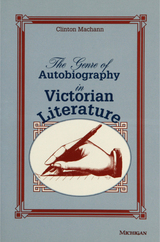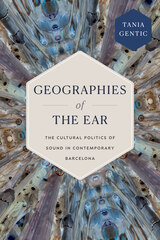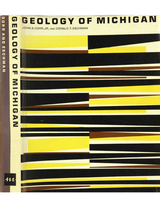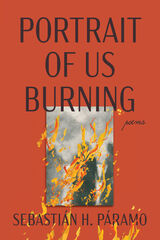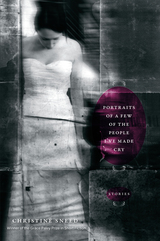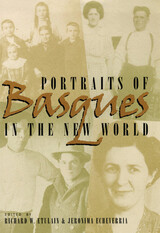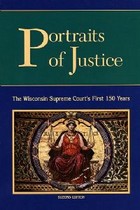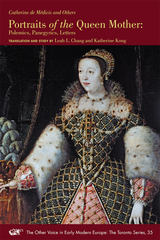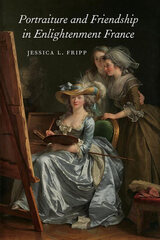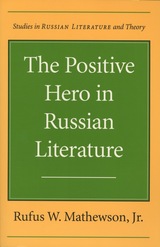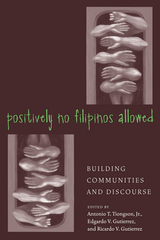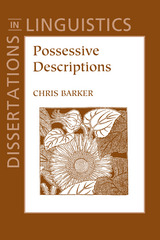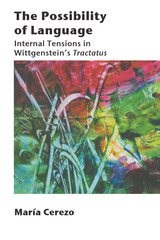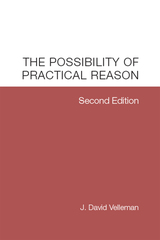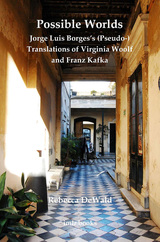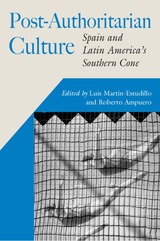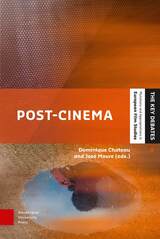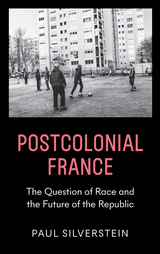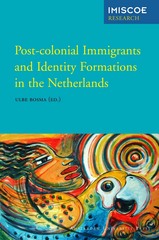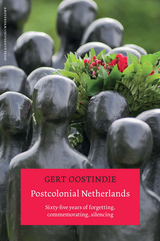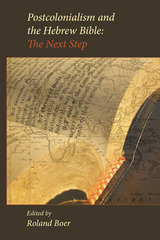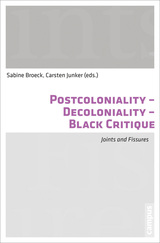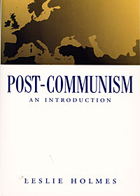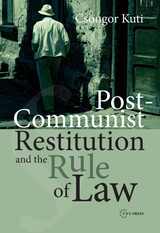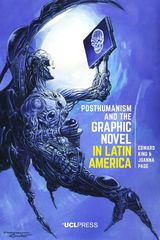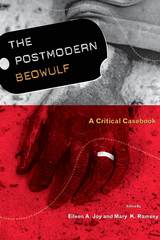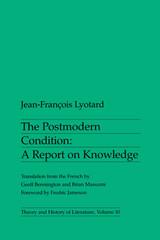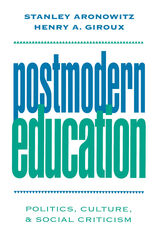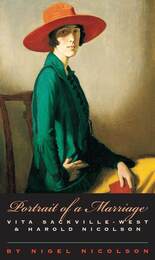 Portrait of a Marriage: Vita Sackville-West and Harold Nicolson
Nigel Nicolson
University of Chicago Press, 1998 Vita Sackville-West, novelist, poet, and biographer, is best known as the friend of Virginia Woolf, who transformed her into an androgynous time-traveler in Orlando. The story of Sackville-West's marriage to Harold Nicolson is one of intrigue and bewilderment. In Portrait of a Marriage, their son Nigel combines his mother's memoir with his own explanations and what he learned from their many letters. Even during her various love affairs with women, Vita maintained a loving marriage with Harold. Portrait of a Marriage presents an often misunderstood but always fascinating couple.
"Portrait of a Marriage is as close to a cry from the heart as anybody writing in English in our time has come, and it is a cry that, once heard, is not likely ever to be forgotten. . . . Unexpected and astonishing."—Brendan Gill, New Yorker
"The charm of this book lies in the elegance of its narration, the taste with which their son has managed to convey the real, enduring quality of his parents' love for each other."—Doris Grumbach, New Republic
Portrait of a Port: Boston, 1852–1914
W. H. Bunting
Harvard University Press, 1971 Two hundred and thirty-four striking photographs of the port of Boston combine with interpretive commentary to recapture the flavor, buoyancy, and excitement of the city’s years as one of the two or three great American ports. After the Civil War Boston underwent a radical and successful transformation from a declining mercantile home port to an important and competitive modern seaport. At the same time the transition from sail to steam was taking place. Photographic studies of deep water sail and steam vessels, naval ships, fishing boats, catboats, tugs, schooners, and sloops, and of the picturesque wharves—all create a kaleidoscopic visual history of these years of change.
The volume offers, as well, some of the most distinguished early work in photography, including the widest selection ever published of photographs by pioneer marine photographer Nathaniel Stebbins.
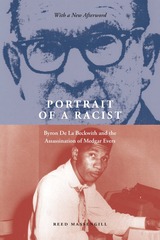 Portrait of a Racist: Byron De La Beckwith and the Assassination of Medgar Evers
Reed Massengill
University of Tennessee Press, 2023 Originally published in 1994, Portrait of a Racist is an astonishing biography of Byron De La Beckwith (1920–2001), who murdered Black civil rights leader Medgar Evers in June 1963. Written by Beckwith’s nephew by marriage, the book is based on dozens of exclusive personal interviews with Beckwith and people who knew him—as well as letters Beckwith wrote directly to the author. These unique sources provide as definitive a glimpse into the chilling psychological landscape of a man devoted to murderous intolerance as we will likely ever have. Although the slaying of Evers helped to galvanize the civil rights movement in the South, the killer evaded justice for three decades after the crime. Twice tried for murder in the 1960s—both times by all- male, all-White juries—Beckwith was finally convicted in a third trial in 1994.
Accompanied by new illustrations that have never been printed before, this new edition includes an afterword that recounts the author’s participation as a witness and his introduction of new evidence in the third trial. It also chronicles Beckwith’s last years of declining health behind bars, examines the rich scholarship on Evers and civil rights that has arisen since this book’s original appearance, and reflects on the catastrophic persistence of Beckwith’s ideology— Christian nationalism and white supremacy—in our own times.
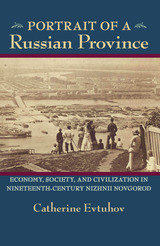 Portrait of a Russian Province: Economy, Society, and Civilization in Nineteenth-Century Nizhnii Novgorod
Catherine Evtuhov
University of Pittsburgh Press, 2011
Several stark premises have long prevailed in our approach to Russian history. It was commonly assumed that Russia had always labored under a highly centralized and autocratic imperial state. The responsibility for this lamentable state of affairs was ultimately assigned to the profoundly agrarian character of Russian society. The countryside, home to the overwhelming majority of the nation’s population, was considered a harsh world of cruel landowners and ignorant peasants, and a strong hand was required for such a crude society.
A number of significant conclusions flowed from this understanding. Deep and abiding social divisions obstructed the evolution of modernity, as experienced “naturally” in other parts of Europe, so there was no Renaissance or Reformation; merely a derivative Enlightenment; and only a distorted capitalism. And since only despotism could contain these volatile social forces, it followed that the 1917 Revolution was an inevitable explosion resulting from these intolerable contradictions—and so too were the blood-soaked realities of the Soviet regime that came after. In short, the sheer immensity of its provincial backwardness could explain almost everything negative about the course of Russian history.
This book undermines these preconceptions. Through her close study of the province of Nizhnii Novgorod in the nineteenth century, Catherine Evtuhov demonstrates how nearly everything we thought we knew about the dynamics of Russian
society was wrong. Instead of peasants ground down by poverty and ignorance, we find skilled farmers, talented artisans and craftsmen, and enterprising tradespeople. Instead of an exclusively centrally administered state, we discover effective and participatory local government. Instead of pervasive ignorance, we are shown a lively cultural scene and an active middle class. Instead of a defining Russian exceptionalism, we find a world recognizable to any historian of nineteenth-century Europe.
Drawing on a wide range of Russian social, environmental, economic, cultural, and intellectual history, and synthesizing it with deep archival research of the Nizhnii Novgorod province, Evtuhov overturns a simplistic view of the Russian past. Rooted in, but going well beyond, provincial affairs, her book challenges us with an entirely new perspective on Russia’s historical trajectory.
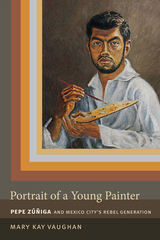 Portrait of a Young Painter: Pepe Zuniga and Mexico City's Rebel Generation
Mary Kay Vaughan
Duke University Press, 2015 In Portrait of a Young Painter, the distinguished historian Mary Kay Vaughan adopts a biographical approach to understanding the culture surrounding the Mexico City youth rebellion of the 1960s. Her chronicle of the life of painter Pepe Zúñiga counters a literature that portrays post-1940 Mexican history as a series of uprisings against state repression, injustice, and social neglect that culminated in the student protests of 1968. Rendering Zúñiga's coming of age on the margins of formal politics, Vaughan depicts midcentury Mexico City as a culture of growing prosperity, state largesse, and a vibrant, transnationally-informed public life that produced a multifaceted youth movement brimming with creativity and criticism of convention. In an analysis encompassing the mass media, schools, politics, family, sexuality, neighborhoods, and friendships, she subtly invokes theories of discourse, phenomenology, and affect to examine the formation of Zúñiga's persona in the decades leading up to 1968. By discussing the influences that shaped his worldview, she historicizes the process of subject formation and shows how doing so offers new perspectives on the events of 1968.
A Portrait of the Artist as a Political Dissident: The Life and Work of Aleksandar Petrovic
Vlastimir Sudar
Intellect Books, 2013 In the liberal West as in socialist Yugoslavia, the films of Aleksandar Petrovic dramatize how enforced dogmatism can corrode any political system. A case study of the oft-overlooked Yugoslav director’s colorful and eventful career, A Portrait of the Artist as a Political Dissident explores how Petrovic developed specific political and social themes in his films. A response to the political vagaries of his time, these anti-dogmatic views were later to become a trademark of his work. Although interest in socialist Yugoslavia and its legacy has risen steadily since the 1990s, the history of Yugoslav cinema has been scarcely covered, and this book marks a fresh contribution to a burgeoning area of interest.
Portrait of Us Burning: Poems
Sebastián H. Páramo
Northwestern University Press, 2024 A powerful debut collection exploring one family’s pursuit of the American Dream
Sebastián H. Páramo renders a semi-autobiographical collection, utilizing self-portraiture and memory to uncover how his Texan, working-class, Mexican American identity shapes his relationship to his half brother and to his family’s burning desire to become American.
Portrait of Us Burning begins with the humble picture of an immigrant American family. This picture starts to disintegrate—and, ultimately, burns—with the need to understand an inciting event that haunts the family throughout the second half of the collection. As the poems gather force and the picture dissolves further, Páramo asks us again and again: What does it mean to burn while becoming a part of a whole?
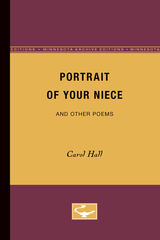 Portrait of Your Niece: And Other Poems
Carol Hall
University of Minnesota Press, 1959
Portrait of Your Niece was first published in 1959.Carol Hall wrote her first poem, addressed to Santa Claus, when she was four years old. She has been writing ever since and has contributed poems to many magazines, but this is the first collection of her poetry to be published in book form. The volume contains fifty lyric and dramatic poems.Richard Eberhart comments: “Carol Hall’s poems are mature, tightly written and full of thought. She is not afraid to take a hard look at the truth. She can be light-hearted too. There is a sophisticated mind always present in the varying views and evaluations in this book.”Another interesting comment on this collection comes from Arnold Stein: “What especially attracts me is the voice I hear in the poems -- distinctive, wonderfully modulated, and remaining somehow itself even while expressing the intensities and surprises of the imagination with skill and force and courage.”Among the poems in this volume are some that have appeared previously in Botteghe Oscure (Italy), the New Yorker, Atlantic Monthly, Sewanee Review, New World Writing, Poetry, Western Review, Quarterly Review of Literature, Folder, Perspective, Voices, Experiment, Interim, and Poetry Northwest.
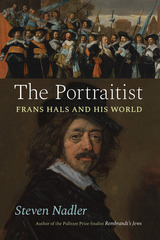 The Portraitist: Frans Hals and His World
Steven Nadler
University of Chicago Press, 2022 A biography of the great portraitist Frans Hals that takes the reader into the turbulent world of the Dutch Golden Age.
Frans Hals was one of the greatest portrait painters in history, and his style transformed ideas and expectations about what portraiture can do and what a painting should look like.
Hals was a member of the great trifecta of Dutch Baroque painters alongside Rembrandt and Vermeer, and he was the portraitist of choice for entrepreneurs, merchants, professionals, theologians, intellectuals, militiamen, and even his fellow artists in the Dutch Golden Age. His works, with their visible brush strokes and bold execution, lacked the fine detail and smooth finish common among his peers, and some dismissed his works as sloppy and unfinished. But for others, they were fresh and exciting, filled with a sense of the sitter’s animated presence captured with energy and immediacy.
Steven Nadler gives us the first full-length biography of Hals in many years and offers a view into seventeenth-century Haarlem and this culturally rich era of the Dutch Republic. He tells the story not only of Hals’s life, but also of the artistic, social, political, and religious worlds in which he lived and worked.
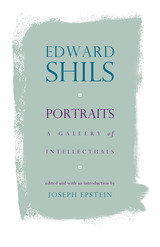 Portraits: A Gallery of Intellectuals
Edward Shils
University of Chicago Press, 1997 In these vivid portraits of prominent twentieth-century intellectuals, Edward Shils couples the sensitivity of a biographer with the profound knowledge of a highly respected scholar. Ranging as widely across various disciplines as Shils himself did, the essays gathered here share a distaste for faddists who "run with the intellectual mob" and a deep respect for intellectuals who maintain their integrity under great pressure.
Highlights include an affectionate treatment of Leo Szilard, the physicist whose involvement with the development of the atomic bomb led him to work ceaselessly to address its social consequences; a discussion of the educational philosophy of Robert Maynard Hutchins, the University of Chicago's fifth and most controversial president; an appreciative account of the Polish emigré Leopold Labedz's well-informed and outspoken resistance to Communism; and an essay about the extraordinary Indian writer Nirad Chaudhuri.
Many of these essays have appeared in The American Scholar, edited by Joseph Epstein, who introduces this volume with his own portrait of Edward Shils.
"Though professionally a sociologist, Edward Shils was a man of wide cosmopolitan culture and experience, greatly concerned with the public problems of his time: in particular with those created by the rise of new and dangerous ideologies, the frightening possibilities of science, and the apparent abrogation of public responsibility by many Western intellectuals."—Hugh Trevor-Roper
The late Edward Shils was a member of the University of Chicago's Committee on Social Thought for forty-five years and a fellow of Peterhouse, Cambridge University. His many books include The Calling of Sociology and The Intellectuals and the Powers, both published by the University of Chicago Press.
 Portraits in a Nutshell: The Art and History of Coquilla Nut Snuff Boxes and Bottles
Donna S. Sanzone
Brandeis University Press, 2025 A gorgeously illustrated look at snuff boxes and bottles carved from the Brazilian coquilla nut reveals a larger history of commerce, cultural exchange, and power in the Atlantic world.
Portraits in a Nutshell showcases intricately carved snuff boxes and bottles sculpted from the Brazilian coquilla nut between the seventeenth and mid-nineteenth centuries. Both utilitarian and decorative, these bottles and boxes were produced and used by diverse people of wide-ranging geographic origin, racial background, and social standing. As a result, coquilla nut snuff boxes present a rich material archive of the Atlantic world and the central role of Indigenous and Black histories within it.
Despite being just three or four inches long, these coquilla nut snuff boxes encapsulate an early modern history of transoceanic movement and creativity. The carvings depict animals and fantastical creatures, scenes of religious and courtly life, portraits of political and military leaders, abolitionists and activists, and people at the margins of colonial society. These images are available to the public and to scholars for the first time in this book and will be of interest to antique collectors, art historians, social historians, and anyone interested in the unusual and the curious.
Over 250 detailed photographs of snuff bottles and boxes from the unique and wide-ranging collection of David Badger not only illustrate the exceptional skill of their creators but also tell the story of millions of Africans transported to Brazil during centuries of the transatlantic slave trade. The text demonstrates the interconnectedness of the Atlantic world, the movements of peoples and ideas, and the commercial exchange of goods and cultural and material objects in Africa, Brazil, the Caribbean, and North America. In this beautiful book, these objects reveal a story never before told.
With a preface by Matthew Francis Rarey, associate professor of African and Black Atlantic art history at Oberlin College, and an introduction by Gwendolyn DuBois Shaw, professor of art history at the University of Pennsylvania and director of the Arthur Ross Gallery.
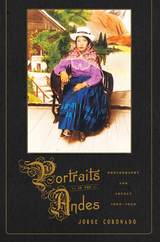 Portraits in the Andes: Photography and Agency, 1900-1950
Jorge Coronado
University of Pittsburgh Press, 2018 Portraits in the Andes examines indigenous and mestizo self-representation through the medium of photography from the early to mid twentieth century. As Jorge Coronado reveals, these images offer a powerful counterpoint to the often-slanted, predominant view of indigenismo produced by the intellectual elite.
Photography offered an inexpensive and readily available technology for producing portraits and other images that allowed lower- and middle-class racialized subjects to create their own distinct rhetoric and vision of their culture. The powerful identity-marking vehicle that photography provided to the masses has been overlooked in much of Latin American cultural studies—which have focused primarily on the elite’s visual arts. Coronado's study offers close readings of Andean photographic archives from the early- to mid-twentieth century, to show the development of a consumer culture and the agency of marginalized groups in creating a visual document of their personal interpretations of modernity.
Portraits of a Few of the People I’ve Made Cry: Stories
Christine Sneed
University of Massachusetts Press, 2010 The ten stories in this striking debut collection examine the perils of love and what it means to live during an era when people will offer themselves, almost unthinkingly, to strangers. Risks and repercussions are never fully weighed. People leap and almost always land on rocky ground. May-December romances flourish in these stories, as do self-doubt and, in many cases, serious regret. Mysterious, dangerous benefactors, dead and living artists, movie stars and college professors, plagiarists, and distinguished foreign novelists are among the many different characters. No one is blameless, but villains are difficult to single out--everyone seemingly bears responsibility for his or her desires and for the outcome of difficult choices so often made hopefully and naively.
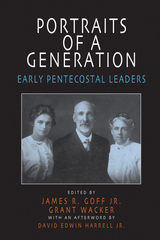 Portraits of a Generation: Early Pentecostal Leaders
James Goff
University of Arkansas Press, 2002 A spirit of religious revival blazed across the United States just after 1900. With a focus on Holy Spirit power, early adherents stirred an enthusiastic response, first at a Bible school in Topeka and then in a small mission on Asuza Street in Los Angeles. Almost immediately, the movement spread to Houston, Chicago, and then northeastern urban centers. By the early 1910s the fervor had reached most parts of the United States, Canada, and northern Mexico, and eventually the converts called themselves pentecostals. Today there are pentecostals all over the world. From the beginning the movement was unusually diverse: women and African Americans were active in many of the early fellowships, and although some groups were segregated, some were interracial. Everytwhere, ordinary people passionately devoted themselves to salvation, Holy Ghost baptism evidenced by speaking in tongues, divine healing, and anticipation of the Lord’s imminent return. This movement saw itself as leaderless, depending on individual conversion and a radical equality of souls — or, as early devotees would say, on the Holy Spirit. But a closer look reveals a host of forceful, clear-eyed leaders. This volume offers twenty biographical portraits of the first-generation pioneers who wove the different strands of Holy Spirit revivalism into a coherent and dramatically successful movement.
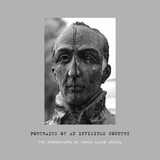 Portraits of an Invisible Country: The Photographs of Jorge Mario Múnera
José Luis Falconi
Harvard University Press In 2003, Jorge Mario Múnera won the Latino and Latin American Art Forum Prize at Harvard University, which entitled him to produce and present an exhibit at Harvard’s David Rockefeller Center for Latin American Studies. By this time, Múnera had already produced an important body of work, revealing even the farthest corners of his native Colombia through his photographs of people and their traditions.
Portraits of an Invisible Country, which bears the name of the exhibit he presented at Harvard in 2004, is the culmination of a five-year collaboration between the photographer and the curator of the show, José Luis Falconi. It comprises a book of essays with insightful reflections on Múnera’s diverse body of work and a series of sixteen photo posters, which together highlight the photographer’s travels within Colombia and his careful depiction of his countrymen and women.
Renowned in Colombia as one of the most prolific and influential photographers of his generation, Múnera was the first recipient of the National Photography Award in Colombia in 1998. Since then, numerous international accolades have followed, chief among them as the first photographer to hold the Andrés Bello Chair of the King Juan Carlos Center at New York University.
Portraits of Basques in the New World
Richard W. Etulain
University of Nevada Press, 1999 A collection of new essays on notable historic and contemporary Basques of America's Far West that offers a perceptive and lively examination of the lives of one of the West's most resilient and successful ethnic minorities. It is essential reading for anyone interested in the Basque people or those interested in the process of immigration and assimilation: these profiles illustrate how America's Basque immigrants have achieved success in mainstream society while retaining strong ties to their ancient Old World culture.
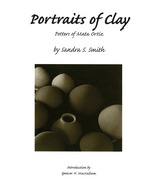 Portraits of Clay: Potters of Mata Ortíz
Sandra S. Smith
University of Arizona Press, 1998 Not long ago, pottery was a lost art in Chihuahua, Mexico. But in the 1970s, near the ruins of Casas Grandes, an art revolution was born. Inspired by ancient pottery fragments from a tradition that had disappeared before the arrival of the first Europeans, a self-taught woodcutter-turned-artist reinvented an entire ceramic technology. Today Casas Grandes pottery, made by hand from local clays and mineral colors by a handful of artists, claims high prices and sets the standard for contemporary pottery. Photographer Sandra Smith traveled to Mata Ortíz to photograph the potters and to record their reflections on their work. Her portraits document their techniques—collecting and preparing the clay, forming by hand, sanding, and painting. They also capture intimate moments between artists and their art. For anyone who has ever admired Casas Grandes pottery, Portraits of Clay is a beautiful introduction to the potters and their work.
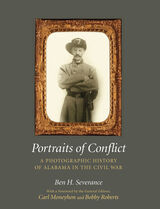 Portraits of Conflict: A Photographic History of Alabama in the Civil War
Ben H. Severance
University of Arkansas Press, 2012 Portraits of Conflict: A Photographic History of Alabama in the Civil War is the tenth volume in this acclaimed series showing the human side of the country's great national conflict. Over 230 photographs of soldiers and civilians from Alabama, many never seen before, are accompanied by their personal stories and woven into the larger narrative of the war both on the battlefield and the home front. Alabama is unusual among the Rebel states in that, while its people saw little fighting inside its boundaries, nearly one hundred thousand Alabamians served with Confederate units throughout the South. This volume chronicles their experiences in almost every battle east of the Mississippi River--especially at Sharpsburg, Chancellorsville, and Gettysburg under the legendary Robert E. Lee; at Murfreesboro and Chickamauga as part of the ill-fated Army of Tennessee; and at the famous siege of Vicksburg. Ultimately Union soldiers did invade the state, and Alabamians defended their homeland against enemy cavalry raiders at Selma and against Federal warships in the fight for Mobile Bay. The volume also includes accounts of some of Alabama's leading politicians as well as several of its more ordinary citizens. This new volume contains the same quality of photography and storytelling that has attracted Civil War enthusiasts since the first volume was published in 1987, making it another welcome addition to the series Civil War History called "a sensibly priced, beautifully produced photographic history."
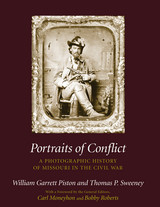 Portraits of Conflict: A Photographic History of Missouri in the Civil War
William Garrett Piston
University of Arkansas Press, 2009 A deeply divided border state, heir to the “Bleeding Kansas” era, Missouri became the third most fought-over state in the war, following Virginia and Tennessee. Rich in resources and manpower, critical politically to both the Union and the Confederacy, it was the scene of conventional battles, river warfare, and cavalry raids. It saw the first combat by organized units of Native Americans and African Americans. It was also marked by guerrilla warfare of unparalleled viciousness. This volume, the ninth in the series, includes hundreds of photographs, many of them never before published. The authors provide text and commentary, organizing the photographs into chapters covering the origins of the war, its conventional and guerrilla phases, the war on the rivers, medicine (Sweeny’s medical knowledge adds a great deal to this chapter and expands our knowledge of its practice in the west), the experiences of Missourians who served out of state, and the process of reunion in the postwar years.
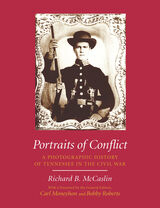 Portraits of Conflict: Tennessee: A Photographic History of Tennessee in the Civil War
Richard B. McCaslin
University of Arkansas Press, 2007 It’s one thing to understand that over twenty-thousand Confederate and Union soldiers died at the Battle of Murfreesboro. It’s quite another to study an ambrotype portrait of twenty-year-old private Frank B. Crosthwait, dressed in his Sunday best, looking somberly at the camera. In a tragically short time, he’ll be found on the battlefield, mortally wounded, still clutching the knotted pieces of handkerchief he used in a hopeless attempt to stop the bleeding from his injuries. Private Crosthwait’s image is one of more than 250 portraits—many never before published—to be found in the much anticipated Portraits of Conflict: A Photographic History of Tennessee in the Civil War. The eighth in the distinguished Portraits of Conflict series, this volume joins the personal and the public to provide a uniquely rich portrayal of Tennesseans—in uniforms both blue and gray—who fought and lost their lives in the Civil War. Here is the story of a widow working as a Union spy to support herself and her children. Of a father emerging from his house to find his Confederate soldier son dying at his feet. Of a nine-year-old boy who attached himself to a Union regiment after his mother died. Their stories and faces, joined with personal remembrances from recovered letters and diaries and ample historical information on secession, famous battles, surrender, and Reconstruction, make this new Portraits of Conflict a Civil War treasure.
 Portraits of John Quincy Adams and His Wife
John Quincy Adams
Harvard University Press, 1970 The publication of Portraits of John Quincy Adams and His Wife makes available a record which both affords unique visual documentation of the most varied political career in American history and exemplifies the work of the principal American portraitists from the days of Copley and Stuart to the dawn of the Daguerrean era. Included in the volume's 159 illustrations are all the known life portraits, busts, and silhouettes of John Quincy and Louisa Catherine Adams, along with important replicas, copies, engravings, and representative likenesses of their siblings.
The book is organized into seven chapters which generally coincide with the major divisions of John Quincy Adams' political career. Within each chapter are discussed the artists, their relationships with the Adams's, and the provenance of each of their works. A comprehensive chronology of John Quincy Adams' life for each period accompanies the chapter to which it pertains. All important information about the size of each likeness, the inscriptions if any, the date executed, and present ownership where known is summarized in the List of Illustrations.
The Adams's, as they watched themselves age over the years in the marble, ink, or oil of the artists who portrayed them, recorded much by way of commentary on the artistic talent and process at hand. Andrew Oliver, in his detailed and lively discussions of each likeness, makes full use of the diaries and correspondence preserved in the Adams Papers, thus combining a learned appreciation with an intimate glimpse of Adams's as they saw themselves. The volume continues the record of Adams family portraiture begun with Portraits of John and Abigail Adams. The two volumes together constitute Series IV of the distinguished Adams Papers publications.
Portraits of Justice: The Wisconsin Supreme Court's First 150 Years
Trina E. Gray
Wisconsin Historical Society Press, 2003 First published in 1998 to commemorate the sesquicentennial of Wisconsin statehood, this book has been updated to mark the Wisconsin Supreme Court's 150th anniversary and the 125th anniversary of the State Bar of Wisconsin, both celebrated in 2003. It contains profiles of all those who have served as Wisconsin Supreme Court justices and a new introduction by Chief Justice Abrahamson summarizing the court's history and its vision for the future.
This book is an excellent reference for students, attorneys, and all interested in the state's legal history.
 Portraits of Learned Men
Paolo Giovio
Harvard University Press, 2023 The most complete translation available of these brief biographies of great European figures, written by one of the leading historians of the sixteenth century.
Portraits of Learned Men provides a fascinating synopsis of the contours, mentality, and trajectory of humanistic culture in Italy and Europe by one of the leading historians of the sixteenth century, Paolo Giovio (1483–1552). These brief biographies of 146 men of learning—from Dante, Petrarch, and Boccaccio in the fourteenth century to Erasmus, Thomas More, and Juan Luis Vives in the sixteenth—were meant to accompany accurate portrait paintings commemorating great figures in modern history. Presented together with the literary portraits in this volume, these paintings would be located in a purpose-built villa on Lake Como that would be open to the public. Giovio called this his musaeum, or home of the Muses, one of the first such institutions in European history. His museum would not only serve the traditional function of inspiring virtuous emulation but also provide a comprehensive, candid, and personal overview of the Republic of Letters as it had taken shape and flourished in Italy and Europe during the Renaissance.
This volume contains a fresh edition of the Latin text and a new, more complete translation than any now available in English.
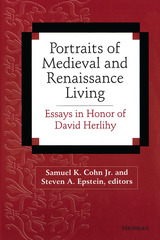 Portraits of Medieval and Renaissance Living: Essays in Memory of David Herlihy
Samuel K. Cohn, Jr. and Steven A. Epstein, Editors
University of Michigan Press, 1996 This volume--a collection of essays dedicated to one of this century's most distinguished medieval historians, David Herlihy--introduces the general reader to the new social history of the Middle Ages and the Renaissance. The essays address three themes: sex and the family, power and patronage in local history, and society in town and countryside. The authors use current research to illustrate how Herlihy's ideas continue to shape work about the lives of powerful and ordinary people in this long and important period of Western history.
Portraits of Medieval and Renaissance Living opens with Herlihy's final summary of his views on family history, followed by a reminiscence by his most important collaborator, Christiane Klapisch-Zuber. The first group of essays takes us inside specific familial settings, using recent methods in anthropological, legal, and women's studies to uncover new dimensions of medieval and Renaissance family life. A second group of studies focuses on the question of authority in medieval society and advances new theses about politics and society in Florence and other local settings. The final group of authors considers the special circumstances of town and countryside in Italy, England, and Spain and draws insightful generalizations across territorial and national boundaries.
Like Herlihy's own work, these essays present innovative and challenging hypotheses about significant problems in the history of medieval and Renaissance Europe. Important new material on Florence, family history, religion, the Inquisition, and taxation is presented for the first time, but the essays are not simply technical exercises focused on small or isolated pieces of research. Thus the volume will go beyond the interest of specialists in medieval and Renaissance social history and will attract a wide audience of students and scholars.
Samuel K. Cohn, Jr., is Professor of History, Brandeis University. Steven Epstein is Professor of History, University of Colorado.
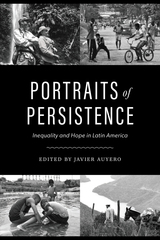 Portraits of Persistence: Inequality and Hope in Latin America
Javier Auyero
University of Texas Press, 2024 Profiles of triumph and hardship amid massive inequality in Latin America. Each chapter of Portraits of Persistence, a project of the University of Texas Urban Ethnography Lab, offers an intimate portrait of one or two individual lives. The subjects are a diverse group of individuals from across the continent: grassroots activists and political brokers, private security entrepreneurs, female drug dealers, shantytown dwellers, and rural farmers, as well as migrants finding routes into and out of the region. Through these accounts, the writers explore issues that are common throughout today's world: precarious work situations, gender oppression, housing displacement, experiences navigating the bureaucracy for asylum seekers, state violence, environmental devastation, and access to good and affordable health care. Carefully situating these experiences within the sociohistorical context of their specific local regions or countries, editor Javier Auyero and his colleagues consider how people make sense of the paths their lives have taken, the triumphs and hardships they have experienced, and the aspirations they hold for the future. Ultimately, these twelve compelling profiles offer unique and personal windows into the region’s complex and multilayered reality.
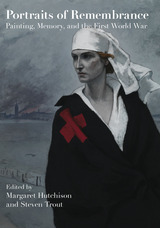 Portraits of Remembrance: Painting, Memory, and the First World War
Edited by Margaret Hutchison and Steven Trout
University of Alabama Press, 2020 Interdisciplinary collection of essays on fine art painting as it relates to the First World War and commemoration of the conflict
Although photography and moving pictures achieved ubiquity during the First World War as technological means of recording history, the far more traditional medium of painting played a vital role in the visual culture of combatant nations. The public’s appetite for the kind of up-close frontline action that snapshots and film footage could not yet provide resulted in a robust market for drawn or painted battle scenes.
Painting also figured significantly in the formation of collective war memory after the armistice. Paintings became sites of memory in two ways: first, many governments and communities invested in freestanding panoramas or cycloramas that depicted the war or featured murals as components of even larger commemorative projects, and second, certain paintings, whether created by official artists or simply by those moved to do so, emerged over time as visual touchstones in the public’s understanding of the war.
Portraits of Remembrance: Painting, Memory, and the First World War examines the relationship between war painting and collective memory in Australia, Austria, Belgium, Canada, Croatia, France, Germany, Great Britain, New Zealand, Russia, Serbia, Turkey, and the United States. The paintings discussed vary tremendously, ranging from public murals and panoramas to works on a far more intimate scale, including modernist masterpieces and crowd-pleasing expressions of sentimentality or spiritualism. Contributors raise a host of topics in connection with the volume’s overarching focus on memory, including national identity, constructions of gender, historical accuracy, issues of aesthetic taste, and connections between painting and literature, as well as other cultural forms.
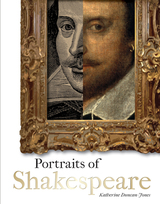 Portraits of Shakespeare
Katherine Duncan-Jones
Bodleian Library Publishing, 2015 Most of us can recall with clarity a favorite scene from Shakespeare. But call to mind the playwright’s appearance and there are many depictions to choose from with few widely accepted. Shakespeare himself left no description of his appearance nor can any evidence be found that he commissioned a portrait.
With Portraits of Shakespeare, Katherine Duncan-Jones poses a series of questions about the mysterious physical appearance of the brilliant writer of plays, poems, and sonnets: Why is it so difficult to find images of Shakespeare that were made during his lifetime? Which images are most likely to have been made by those close to the writer? And why do newly discovered images emerge with such startling regularity? With an eye toward answering these questions, the book begins with a broad analysis of the tradition of the “author portrait” before, during, and after Shakespeare’s lifetime. Duncan-Jones provides a detailed critique of three of the most widely accepted portraits: the engraving facing the First Folio’s title page; the sculptured stone bust that adorns Shakespeare’s funerary monument at Holy Trinity Church, Stratford-upon-Avon; and the “Chandos portrait,” an early seventeenth-century painting on canvas which is widely recognized as the best image. Through a painstaking historical analysis of the painting’s early history and provenance, Duncan-Jones arrives at a plausible new identification of both the artist and the artist’s personal connections with Shakespeare. Finally, taking the book into the present, she considers the afterlife of all three images in memorials, advertising, and in graphic art—all evidence of a continuing desire to put a face to one of literature’s most famous names.
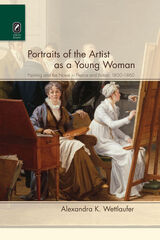 Portraits of the Artist as a Young Woman: Painting and the Novel in France and Britain, 1800–1860
Alexandra K. Wettlaufer
Ohio State University Press, 2011 As women entered the field of cultural production in unprecedented numbers in nineteenth-century France and Britain, they gradually forged a place for themselves, however tenuous, in artistic movements and exhibitions, in academies and salons, and finally in the public imagination. Portraits of the Artist as a Young Woman: Painting and the Novel in France and Britain, 1800–1860 focuses on a decisive period in that process of professional self-invention and maps out the concrete and symbolic roles played by women painters, real and fictional, in the construction of female artistic identity in the aesthetic and the public spheres. Alexandra K. Wettlaufer examines the diverse and complex ways canonical and non-canonical women painters and novelists—including Anne Brontë, Sydney Owenson, Margaret Gillies, Marceline Desbordes-Valmore, George Sand, and Hortense Haudebourt-Lescot—figured and brought forth the radical image of a female subject representing the world. Wettlaufer brings to light a rich and nearly forgotten culture of women’s artistic production, allowing us to understand the nineteenth-century in more complex and nuanced ways across the borders of gender, genre, and nation. In her close readings of paintings by women and novels about women painting, she charts the political and cultural resonances of this artistic self-representation, tracing its evolution through themes of “The Studio” (Part I), “Cosmopolitan Visions” (Part II), and “The Portrait” (Part III). By pairing painting and literature in a single study that also considers works from two distinct but closely related cultures, Portraits of the Artist as a Young Woman locates the interpretation of these works in the dialogic context in which they were created and consumed, highlighting aesthetic and political intersections between nineteenth-century British and French art, literature, and feminism that are too often elided by the disciplinary boundaries of scholarship.
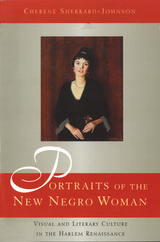 Portraits of the New Negro Woman: Visual and Literary Culture in the Harlem Renaissance
Cherene M. Sherrard-Johnson
Rutgers University Press, 2007 Of all the images to arise from the Harlem Renaissance, the most thought-provoking were those of the mulatta. For some writers, artists, and filmmakers, these images provided an alternative to the stereotypes of black womanhood and a challenge to the color line. For others, they represented key aspects of modernity and race coding central to the New Negro Movement. Due to the mulatta’s frequent ability to pass for white, she represented a variety of contradictory meanings that often transcended racial, class, and gender boundaries. In this engaging narrative, Cherene Sherrard-Johnson uses the writings of Nella Larsen and Jessie Fauset as well as the work of artists like Archibald Motley and William H. Johnson to illuminate the centrality of the mulatta by examining a variety of competing arguments about race in the Harlem Renaissance and beyond.
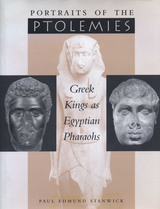 Portraits of the Ptolemies: Greek Kings as Egyptian Pharaohs
By Paul Edmund Stanwick
University of Texas Press, 2003 As archaeologists recover the lost treasures of Alexandria, the modern world is marveling at the latter-day glory of ancient Egypt and the Greeks who ruled it from the ascension of Ptolemy I in 306 B.C. to the death of Cleopatra the Great in 30 B.C. The abundance and magnificence of royal sculptures from this period testify to the power of the Ptolemaic dynasty and its influence on Egyptian artistic traditions that even then were more than two thousand years old. In this book, Paul Edmund Stanwick undertakes the first complete study of Egyptian-style portraits of the Ptolemies. Examining one hundred and fifty sculptures from the vantage points of literary evidence, archaeology, history, religion, and stylistic development, he fully explores how they meld Egyptian and Greek cultural traditions and evoke surrounding social developments and political events. To do this, he develops a "visual vocabulary" for reading royal portraiture and discusses how the portraits helped legitimate the Ptolemies and advance their ideology. Stanwick also sheds new light on the chronology of the sculptures, giving dates to many previously undated ones and showing that others belong outside the Ptolemaic period.
Portraits of the Queen Mother: Polemics, Panegyrics, Letters
Catherine de Médicis and Others
Iter Press, 2014 Catherine de Médicis was portrayed in her day as foreign usurper, loving queen and queen mother, patron of the arts, and Machiavellian murderer of Protestants. Leah L. Chang and Katherine Kong assemble a diverse array of scathing polemic and lofty praise, diplomatic reports, and Catherine’s own letters, which together show how one extraordinary woman’s rule intersected with early modern conceptions of gender, maternity, and power.
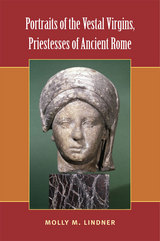 Portraits of the Vestal Virgins, Priestesses of Ancient Rome
Molly M. Lindner
University of Michigan Press, 2015 For more than eleven hundred years, the Vestal Virgins dedicated their lives to the goddess Vesta, protector of the Roman state. Though supervised by a male priest, the Pontifex Maximus, they had privileges beyond those of most women; like Roman men, they dispensed favors and influence on behalf of their clients and relatives. In 1883, Rodolfo Lanciani, Director of Antiquities for Rome, discovered the first Vestal statues. The recovery of the Vestals’ house, and the objects contained therein, was an exciting moment in Roman archaeology. Newspapers were filled with details about the huge numbers of sculptures, inscriptions, jewelry, coins, and terracotta figures. Molly M. Lindner examines the sculptural presentation of the Vestal Virgins and investigates what images of long-dead women tell us about their lives. She addresses why these portraits were created, and why they only began to appear in the late first or second century CE—much later than portraits of other Roman priestesses and nonimperial women. Lindner sheds light on the distinctions between a Vestal portrait and portraits of other priestesses, and considers why Vestal portraits do not copy each other’s headdresses and hairstyles. In addition to the extensive illustrations that complement the text, a catalog of all known Vestal portraits displays historical clues embedded in the hairstyles and facial features of the Vestals and other women of their day. In Portraits of the Vestal Virgins, Priestesses of Ancient Rome, Lindner has given a voice to the long-silent women of these extraordinary marble portraits.
 Portraits of Violence: War and the Aesthetics of Disfigurement
Suzannah Biernoff
University of Michigan Press, 2017 Portraits of Violence explores the image and idea of facial disfigurement in one of its most troubling modern formations, as a symbol and consequence of war. It opens with Nina Berman’s iconic photograph Marine Wedding, which provoked a debate about the medical, military, and psychological response to serious combat injuries. While these issues remain urgent, it is equally crucial to interrogate the representation of war and injury. The concepts of valor, heroism, patriotism, and courage assume visible form and do their cultural work when they are personified and embodied. The mutilated or disabled veteran’s body can connote the brutalizing, dehumanizing potential of modern combat.
Suzannah Biernoff draws on a wide variety of sources mainly from WWI but also contemporary photography and computer games. Each chapter revolves around particular images: Marine Wedding is discussed alongside Stuart Griffiths’ portraits of British veterans; Henry Tonks’ drawings of WWI facial casualties are compared to the medical photographs in the Gillies Archives; the production of portrait masks for the severely disfigured is approached through the lens of documentary film and photography; and finally the haunting image of one of Tonks’s patients reappears in BioShock, a highly successful computer game. The book simultaneously addresses a neglected area in disability studies; puts disfigurement on the agenda for art history and visual studies; and makes a timely and provocative contribution to the literature on the First World War.
Portraiture
Richard Brilliant
Harvard University Press, 1991
Portraiture and Friendship in Enlightenment France
Jessica Fripp
University of Delaware Press, 2011 Portraiture and Friendship in Enlightenment France examines how new and often contradictory ideas about friendship were enacted in the lives of artists in the eighteenth century. It demonstrates that portraits resulted from and generated new ideas about friendship by analyzing the creation, exchange, and display of portraits alongside discussions of friendship in philosophical and academic discourse, exhibition criticism, personal diaries, and correspondence. This study provides a deeper understanding of how artists took advantage of changing conceptions of social relationships and used portraiture to make visible new ideas about friendship that were driven by Enlightenment thought.
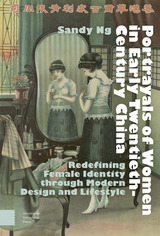 Portrayals of Women in Early Twentieth-Century China: Redefining Female Identity through Modern Design and Lifestyle
Sandy Ng
Amsterdam University Press, 2024 Portrayals of Women in Early Twentieth-Century China explores the role played by woman, and their visual representations, in introducing modern design and modern ways of living to China. It investigates this through an analysis of how women and modern design were represented in the advertisements, photographs, and films of Republican-era China. This study explores the intersection of modernity and the Chinese woman, as they negotiated their changing identities through, and with, new designs that proliferated in Chinese households in the first half of the twentieth century. The advertisements, mass media, photographs and films took on the function of social conditioning, conveying to the viewers ideas of modern social standards, behavior and appearances. With women both instrumentalised within these images, and addressed through them, their visual representations became metaphors that fashioned a new portrait of China, while concurrently impacting on the identity, agency and subjectivity of women themselves.
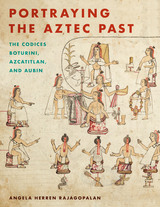 Portraying the Aztec Past: The Codices Boturini, Azcatitlan, and Aubin
By Angela Herren Rajagopalan
University of Texas Press, 2019 During the period of Aztec expansion and empire (ca. 1325–1525), scribes of high social standing used a pictographic writing system to paint hundreds of manuscripts detailing myriad aspects of life, including historical, calendric, and religious information. Following the Spanish conquest, native and mestizo tlacuiloque (artist-scribes) of the sixteenth century continued to use pre-Hispanic pictorial writing systems to record information about native culture. Three of these manuscripts—Codex Boturini, Codex Azcatitlan, and Codex Aubin—document the origin and migration of the Mexica people, one of several indigenous groups often collectively referred to as “Aztec.” In Portraying the Aztec Past, Angela Herren Rajagopalan offers a thorough study of these closely linked manuscripts, articulating their narrative and formal connections and examining differences in format, style, and communicative strategies. Through analyses that focus on the materials, stylistic traits, facture, and narrative qualities of the codices, she places these annals in their historical and social contexts. Her work adds to our understanding of the production and function of these manuscripts and explores how Mexica identity is presented and framed after the conquest.
 Portugal and Africa: Ris Af#81
David Birmingham
Ohio University Press, 2004 Portugal was the first European nation to assert itself aggressively in African affairs. David Birmingham’s Portugal and Africa, a collection of uniquely accessible historical essays, surveys this colonial encounter from its earliest roots. The Portuguese established sugar plantations on Africa’s offshore islands and built factories on the beaches in the fifteenth century, but Professor Birmingham explains that their focus shifted to regions where medieval African miners had discovered deep seams of gold ore. Later, when even richer mines and more fertile lands were captured from the native peoples of the Americas, Portuguese ships became the great “slave bridge” that spanned the Atlantic and ferried captive black workers to the colonies of the New World. Portugal lost its major mining claims in Africa to the British, but it left a legacy of a new pattern of white settler colonization based on American-style plantations. The blending of European and African cultures and races led to the emergence of elite communities, from the Kongo princes of the seventeenth century to the creolized generals of today. Portugal and Africa focuses extensively on Angola to cast new light on the final years of the colonial experience and its traumatic legacies. After 1950, Portuguese Angola became one of the most dynamic of Africa’s colonies and the largest white colony outside of Algeria or South Africa. Angola’s eventual collapse in a series of wars had devastating results. Birmingham brings the terror and devastation to life in a series of powerful chapters that are a model of disciplined scholarship and informed passion.
 Portugal and Brazil in Transition
Raymond S. Sayers, Editor
University of Minnesota Press, 1968 Portugal and Brazil in Transition was first published in 1968. Minnesota Archive Editions uses digital technology to make long-unavailable books once again accessible, and are published unaltered from the original University of Minnesota Press editions. Through a series of essays on various aspects of Portuguese and Brazilian culture, this book presents an enlightening picture of contemporary civilization in the two countries and a forecast of what the next twenty years or so may bring. The authors discuss subjects in such basic fields as literature, linguistics, history, the social sciences, geography, the fine arts, music, and natural science. Taken as a whole, the contents demonstrate the logic of organizing a volume not around a geographical concept but, rather, around a historical concept, in this case "the world the Portuguese created," as Gilberto Freyre described it. The essays are based on papers that were given at the Sixth International Colloquium of Luso-Brazilian Studies, held in the United States in 1966. In addition to the essays, the book contains the text of comments and discussion about the papers. There are twenty-seven major essays by as many contributors and comments by a number of discussants.
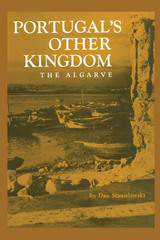 Portugal's Other Kingdom: The Algarve
By Dan Stanislawski
University of Texas Press, 1963 A land of long ago on the brink of tomorrow. That is the Algarve, the southernmost province of Portugal, a land that knew the Phoenicians, Carthaginians, Greeks, Romans, Visigoths, Moslems—and yet retained its own distinctive personality. In the 1950s it first felt the impact of industrialization, and from that situation the author developed this book. In presenting this descriptive geography of the Algarve, Dan Stanislawski offers no thesis, except that geographers, economists, politicians, humanists—all those interested in the way the world is developing—should watch the small, culturally disparate areas of the world, to learn what they have of value to teach, to enjoy the qualities of their independent ways of living, and to observe and evaluate their reaction to modern change. This book, the result of detailed observation of one such region, is a valuable contribution to the knowledge necessary to form sound value judgments on the future development of these areas. From this account the charm of the Algarve emerges in all of its picturesqueness. With the aid of Stanislawski's vivid descriptions, his eighteen helpful maps and graphs, and his more than ninety photographs, the reader moves leisurely through this appealing, but unpublicized, region: along roadways bordered by rock walls and blooming almonds, traveled by sturdy burros bearing their loads of produce; through colorful landscapes of the Lower Algarve, with their pastel-calcimined dwellings and their intensively cultivated plots of olives, figs, carobs, grain, and vegetables; along the rugged cliff coast near Portimão, and the boat-filled port of Faro; past the canyon gardens of the Caldeirão; along the Arade River with its cork barges; northward past Cape S. Vicente to the area of wind-sheared trees. Guided by Stanislawski, the reader comes to understand Algarvian problems inherent in soils, topography, climate, location, and history. He sees the Algarvians following the occupational practices that have produced for them, in the midst of difficult conditions, a stable culture: fishing, netmaking, shipbuilding, farming, herding, and so on. He realizes that these people, with their unique cultural background and environment, desire to live, and to change, in their own way. Finally, he learns how it is possible to communicate effectively with the Algarvians and with millions of other people whose peculiar problems tend to isolate them from the rest of the world.
Português Contemporâneo I
Maria I. Abreu and Cléa Rameh
Georgetown University Press This is the first volume of a basic course organized around the concept that to learn another language is to internalize another set of linguistic rules. A set of 11 audiocassettes totaling 11 hours is available to accompany this volume.
Português Contemporâneo II
Maria I. Abreu and Cléa Rameh
Georgetown University Press This second volume of the basic Portuguese course contains additional readings for vocabulary refinement and development of cultural knowledge. A set of 10 audiocassettes is available to accompany Volume II.
 Portuguese: A Reference Manual
By Sheila R. Ackerlind and Rebecca Jones-Kellogg
University of Texas Press, 2011 An essential, comprehensive guide for all who are interested in learning the Portuguese language and mastering its complexities, Portuguese: A Reference Manual supplements the phonetic and grammatical explanations offered in basic textbooks. While the Manual focuses on Brazilian Portuguese, it incorporates European Portuguese variants and thus provides a more complete description of the language. Accessible to non-linguists and novice language learners, as well as informative for instructors of Portuguese and specialists in other languages, this guide incorporates the Orthographic Accord (in effect since 2009–2010), which attempts to standardize Portuguese orthography. The Manual reflects the language as it is currently taught at both the undergraduate and graduate levels by providing detailed explanations of the sound and writing systems and the grammar of the principal Portuguese dialects. A reference guide rather than a textbook, the Manual also provides extensive verb charts, as well as comparisons of Portuguese with English and Spanish.
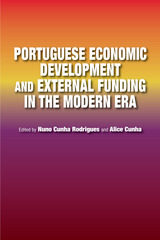 Portuguese Economic Development and External Funding in the Modern Era
Alice Cunha
Sussex Academic Press, 2023 After World War II, with the triumph of multilateralism, several international organizations were created, including two which would be of special importance for the external funding of the Portuguese economy in the second half of the twentieth century and in the early twenty-first. The European Union and the International Monetary Fund have been responsible for providing large amounts of funding, both in periods of economic development and during times of financial crisis. This contributory volume provides a thorough analysis on specific case studies: the Marshall Plan (19491952); the three IMF interventions (in the seventies, eighties, and the 2011 bailout); the implementation of the first EU funds Portugal received prior to accession; and the debate on the new framework for European funds for the period 2021-2027. These case study analyses provide an overview of the legal, economic, and financial implications that such external funding has on the country at different times and in different economic contexts. Of particular import at all times is the public finance legal framework, and this is especially the case for the new European funding structures, which has attracted some criticism. And for any future IMF financial assistance and its political implementation implications. Portuguese Economic Development and External Funding in the Modern Era; provides important insights into economic development, crisis management, financial assistance, and European investment funds. While the work is Portuguese-centered, the topics investigated and the means of analysis adopted are applicable to other countries. This is the first book to address economic development and external funding, and it will inevitably be used as a template for future research.
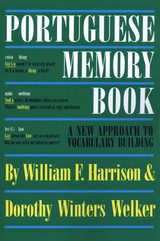 Portuguese Memory Book: A New Approach to Vocabulary Building
By William F. Harrison and Dorothy Winters Welker
University of Texas Press, 1996 Mnemonics is an age-old device for remembering names, numbers, and many other things. The Portuguese Memory Book, by William F. Harrison and Dorothy Welker, makes use of this reliable memory help in a series of mnemonic jingles that are by turns playful, sardonic, touching, and heroic to help both students and independent learners acquire and remember Portuguese vocabulary. The mnemonic jingles present both the sound of the Portuguese word (indicated by syllables in underlined boldface type) and its English meaning (given by a word or phrase in boldface type): noite (f.) night Don't annoy Chihuahuas in the night.
If you ignore their bark, you'll feel their bite. This innovative approach to vocabulary building is simple, effective, and entertaining. The authors also include a general pronunciation guide to Brazilian Portuguese, particularly to the Carioca dialect of Rio de Janeiro.
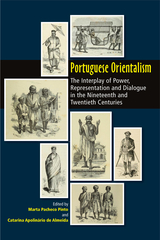 Portuguese Orientalism: The Interplay of Power, Representation and Dialogue in the Nineteenth and Twentieth Centuries
Catarina De Almeida
Sussex Academic Press, 2022 Research on Portuguese orientalism has been mostly centred on the sixteenth and seventeenth centuries and has focused on missionary work and Catholic orientalism. In contrast, reflection on the nineteenth and twentieth centuries is scarce and has relied on individual case studies, notwithstanding the TECOP (Texts and Contexts of Portuguese Orientalism: The International Congresses of Orientalists, 1873-1973) research project. This edited collection is the result of an international forum (www.tecop.letras.ulisboa.pt) hosted by the Centre for Comparative Studies, the University of Lisbon. The editorial aim is to counter the scant attention paid to Portuguese orientalist scholarship, which has been peripheralized within the comparative history of western imperialisms at large and within national orientalisms in particular. Incorporating Portugal into a broader European colonial discourse about the East and discussing the responses to Portuguese colonial legacies gives visibility to the agency of the multiple actors and networks implicated in the Portuguese modern connection to the East. Essays cover former Portuguese India (Goa), Macau, Timor and Japan, as well as East Africa, Egypt, and even Angola as an expansive site of the Portuguese orientalist rhetoric. The chapters by necessity revisit Edward Said's Orientalism; (1978), making use of its analytical framework. They foster an understanding of Portuguese orientalism as an epistemological system supported by an elite—either intellectual, scientific, or literary—that assumed different material manifestations in the shape of colonial policies, scientific expeditions, exhibitions, press and literary publications, radio broadcasts, and the institutionalization itself of orientalist knowledge. This is the first collection in the English language overtly expressing an intention to examine this epistemological contribution.
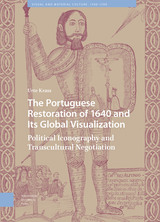 The Portuguese Restoration of 1640 and Its Global Visualization: Political Iconography and Transcultural Negotiation
Urte Krass
Amsterdam University Press, 2023 The Portuguese Restoration of 1640 ended the dynastic union of Portugal and Spain. This book pioneers in reconstructing the global image discourse related to the event by bringing together visualizations from three decades and four continents. These include paintings, engravings, a statue, coins, emblems, miniatures, a miraculous crosier and other regalia, buildings, textiles, a castrum doloris, drawings, and ivory statues. Situated within the academic field of visual studies, the book interrogates the role of images and depictions before, during, and after the overthrow and how they functioned within the intercontinental communication processes in the Portuguese Empire. The results challenge the conventional notion of center and periphery and reveal unforeseen entanglements as well as an unexpected agency of imagery from the remotest regions under Portuguese control. The book breaks new ground in linking the field of early modern political iconography with transcultural art history and visual studies.
 The Portuguese-Speaking Diaspora: Seven Centuries of Literature and the Arts
By Darlene J. Sadlier
University of Texas Press, 2016 Long before the concept of “globalization,” the Portuguese constructed a vast empire that extended into Africa, India, Brazil, and mid-Atlantic territories, as well as parts of China, Southeast Asia, and Japan. Using this empire as its starting point and spanning seven centuries and four continents, The Portuguese-Speaking Diaspora examines literary and artistic works about the ensuing diaspora, or the dispersion of people within the Portuguese-speaking world, resulting from colonization, the slave trade, adventure seeking, religious conversion, political exile, forced labor, war, economic migration, and tourism. Based on a broad array of written and visual materials, including historiography, letters, memoirs, plays, poetry, fiction, cartographic imagery, paintings, photographs, and films, The Portuguese-Speaking Diaspora is the first detailed analysis of the different and sometimes conflicting cultural productions of the imperial diaspora in its heyday and an important context for understanding the more complex and broader-based culture of population travel and displacement from the former colonies to present-day “homelands.” The topics that Darlene J. Sadlier discusses include exploration and settlement by the Portuguese in different parts of the empire; the Black Atlantic slave trade; nineteenth-century travel and Orientalist imaginings; the colonial wars; and the return of populations to Portugal following African independence. A wide-ranging study of the art and literature of these and other diasporic movements, this book is a major contribution to the growing field of Lusophone studies.
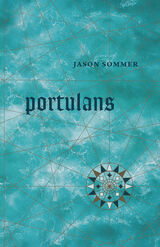 Portulans
Jason Sommer
University of Chicago Press, 2021 Taking inspiration from medieval sea charts—portulans—the poems in Jason Sommer’s collection bring a fresh variation to the ancient metaphor of life as a journey. Creating a coordinate system charting paths between ports and the dangers that surrounded them, portulans offered webs of routes and images through which sailors could navigate. These maps—both accurate and beautifully illustrated—guided mariners from port to port weaving paths at the threshold of the open sea. Similarly, the course of these poems navigates familiar mysteries and perennial questions through times of unbelief, asking whether consciousness is anchored in the transcendent, if inward travel can descend past the self, and if the universe can be accounted for by physics alone. Is there more to the story that you remember and hesitate
to say? Your eyes, though, scanning upward in their sockets,
do seem to search memory, but for what may be gone already,
gone to where it goes—wherever it came from—gone as can be imagined,
down into things, in past flesh and bark, marrow and pith, and down,
down into molecule, atom, particle, vanishing into theory.
Through this collection, Sommer takes us to the ocean floor, into the basement, out the front door, through multiverses, and in and out of dreams. Along the way, he considers whether art—the beauty of the map—can provide momentary meaning against a backdrop of oblivion. Drawing on history and myth, the voices in these poems consider what can and cannot be known of the self and the other, of our values, and of what we insist has permanence. These are poems of searching. Like ancient cartographers who lent lavish decoration to their maps, the poems in Portulans illuminate possibilities of beauty in each journey.
 Positions
Jacques Derrida
University of Chicago Press, 1982 Positions is a collection of three interviews with Jacques Derrida that illuminate and make more accessible the complex concepts and terms treated extensively in such works as Writing and Difference and Dissemination. Derrida takes positions on his detractors, his supporters, and the two major preoccupations of French intellectual life, Marxism and psychoanalysis.
The interviews included in this volume offer a multifaceted view of Derrida. "Implications: Interview with Henri Ronse" contains a succinct statement of principles. "Seminology and Grammatology: Interview with Julia Kristeva" provides important clarifications of the role played by linguistics in Derrida's work. "Positions: Interview with Jean-Louis Houdebine and Guy Scarpetta" is a wide-ranging discussion that touches on many of the polemics that Derrida's work has provoked.
Alan Bass, whose translation of Writing and Difference was highly praised for its clarity, accuracy, and readability, has provided extremely useful critical notes, full of vital information, including historical background.
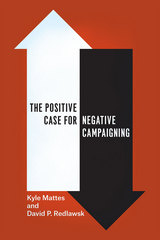 The Positive Case for Negative Campaigning
Kyle Mattes and David P. Redlawsk
University of Chicago Press, 2015 Turn on the television or sign in to social media during election season and chances are you’ll see plenty of negative campaigning. For decades, conventional wisdom has held that Americans hate negativity in political advertising, and some have even argued that its pervasiveness in recent seasons has helped to drive down voter turnout. Arguing against this commonly held view, Kyle Mattes and David P. Redlawsk show not only that some negativity is accepted by voters as part of the political process, but that negative advertising is necessary to convey valuable information that would not otherwise be revealed.
The most comprehensive treatment of negative campaigning to date, The Positive Case for Negative Campaigning uses models, surveys, and experiments to show that much of the seeming dislike of negative campaigning can be explained by the way survey questions have been worded. By failing to distinguish between baseless and credible attacks, surveys fail to capture differences in voters’ receptivity. Voters’ responses, the authors argue, vary greatly and can be better explained by the content and believability of the ads than by whether the ads are negative. Mattes and Redlawsk continue on to establish how voters make use of negative information and why it is necessary. Many voters are politically naïve and unlikely to make inferences about candidates’ positions or traits, so the ability of candidates to go on the attack and focus explicitly on information that would not otherwise be available is crucial to voter education.
Positive Hero in Russian Literature
Rufus W. Mathewson, Jr.
Northwestern University Press, 2000 This classic text brings a period of Russian literature to life and demonstrates how the battles over the positive hero reappeared with dramatic clarity in the dissident literary movement after Stalin's death. Mathewson argues that the true continuity between nineteenth- and twentieth-century Russian prose was to be found in this persistent conflict between contrary views of the real nature and proper uses of literature. This new edition includes chapters on Belinsky, Pasternak, Solzhenitsyn, and Sinyavsky.
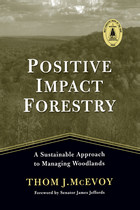 Positive Impact Forestry: A Sustainable Approach To Managing Woodlands
Thom J. McEvoy; Foreword by James Jeffords
Island Press, 2004 Positive Impact Forestry offers private landowners, forest managers, and conservation-minded professionals a clear, practical roadmap for managing woodlands in ways that sustain both ecological health and long-term economic value. Rather than focusing solely on low-impact practices, Thom McEvoy introduces a forward-thinking approach that actively enhances the vitality of forest ecosystems while meeting the real-world needs of families, communities, and future generations.
Grounded in the latest forestry science, this comprehensive guide explains how decisions about harvesting, soil management, and silviculture can influence everything from biodiversity to soil organisms to timber quality. McEvoy presents core concepts—like forest soils, tree physiology, and regeneration dynamics—in a highly accessible format, making the science understandable and actionable for non-specialists and seasoned professionals alike.
The book also addresses key financial and legal considerations, offering guidance on working with forestry professionals, diversifying revenue beyond timber, and ensuring that land management legacies can be passed on across generations. Case studies and examples help illustrate how values-driven forestry practices can create measurable benefits over time—without compromising the ecological integrity of the land.
Recognized by the National Woodland Owners Association as the “Best Forestry Book for 2004,” Positive Impact Forestry remains a trusted resource for anyone committed to thoughtful, sustainable forest stewardship that balances today’s goals with tomorrow’s responsibility.
 The Positive Mind: Its Development and Impact on Modernity and Postmodernity
Evaldas Nekrašas
Central European University Press, 2016 This book is a radical reappraisal of positivism as a major movement in philosophy, science and culture. In examining positivist movement and its contemporary impact, I had the following goals. First, to provide a more precise and systematic definition of the notion of positivism. Second, to describe positivism as a trend of thought concerned not only with the theory of knowledge and philosophy of science, but also with problems of ethics, social, and political philosophy, and show that its representatives usually thought that the problems of the latter cannot be solved without solving the former first. Third, to examine the development of positivism as a movement which preserves a certain tradition and hence possesses some coherence, although the forms of this movement changed in different historical circumstances: it was born in the eighteenth century during the Enlightenment, took the form of social positivism in the nineteenth century, was transformed at the turn of the twentieth century with the emergence of empirio-criticism, and became logical positivism (or logical empiricism) in the twentieth century. Fourth, to reveal the external and internal factors of this evolution. Fifth, to disclose the relation of positivism to other trends of philosophy. Sixth, to determine the influence the positive mind had not only upon philosophy, but upon other cultural phenomena, such as the natural and social sciences, law, politics, arts, religion, and everyday life.
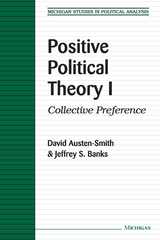 Positive Political Theory I: Collective Preference
David Austen-Smith and Jeffrey S. Banks
University of Michigan Press, 2000 Positive Political Theory I is concerned with the formal theory of preference aggregation for collective choice. The theory is developed as generally as possible, covering classes of aggregation methods that include such well-known examples as majority and unanimity rule and focusing in particular on the extent to which any aggregation method is assured to yield a set of "best" alternatives. The book is intended both as a contribution to the theory of collective choice and a pedagogic tool.
Austen-Smith and Banks have made the exposition both rigorous and accessible to people with some technical background (e.g., a course in multivariate calculus). The intended readership ranges from more technically-oriented graduate students and specialists to those students in economics and political science interested less in the technical aspects of the results than in the depth, scope, and importance of the theoretical advances in positive political theory.
"This is a stunning book. Austen-Smith and Banks have a deep understanding of the material, and their text gives a powerfully unified and coherent perspective on a vast literature. The exposition is clear-eyed and efficient but never humdrum. Even those familiar with the subject will find trenchant remarks and fresh insights every few pages. Anyone with an interest in contemporary liberal democratic theory will want this book on the shelf." --Christopher Achen, University of Michigan
David Austen-Smith is Professor of Political Science, Professor of Economics, and Professor of Management and Strategy, Northwestern University. Jeffrey S. Banks is Professor of Political Science, California Institute of Technology.
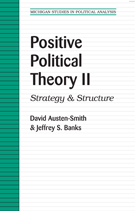 Positive Political Theory II: Strategy and Structure
David Austen-Smith and Jeffrey S. Banks
University of Michigan Press, 2005 “A major piece of work . . . a classic. There is no
other book like it.”
—Norman Schofield, Washington University
“The authors succeed brilliantly in tackling a large
number of important questions concerning the
interaction among voters and elected representatives
in the political arena, using a common, rigorous
language.”
—Antonio Merlo, University of Pennsylvania
Positive Political Theory II: Strategy and Structure
is the second volume in Jeffrey Banks and David
Austen-Smith’s monumental study of the links
between individual preferences and collective choice.
The book focuses on representative systems, including
both elections and legislative decision-making
processes, clearly connecting individual preferences to
collective outcomes. This book is not a survey. Rather,
it is the coherent, cumulative result of the authors’
brilliant efforts to indirectly connect preferences to
collective choice through strategic behaviors such as
agenda-selection and voting.
The book will be an invaluable reference and teaching
tool for economists and political scientists, and an
essential companion to any scholar interested in the
latest theoretical advances in positive political theory.
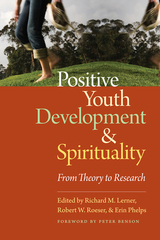 Positive Youth Development and Spirituality: From Theory to Research
Richard M. Lerner
Templeton Press, 2008 <p>Bringing together a never-before-assembled network of biologists, psychologists, and sociologists, <em>Positive Youth Development and Spirituality</em> scientifically examines how spirituality and its cultivation may affect the positive development of adolescents. </p>
<p>Chapters provide groundbreaking new discussions of conceptual, theoretical, definitional, and methodological issues that need to be addressed when exploring the relationships between spirituality and development. Throughout the book, contributors recommend ways in which the research on the spirituality/positive youth development connection may be integral in building the larger field of spiritual development as a legitimate and active domain of developmental science. This volume, which is sure to be seen as a seminal contribution to a field in need of theoretical underpinnings, will be of interest to scholars and scientists in the fields of biology and the social and behavioral sciences.</p>
<p>Contributors include: Mona Abo-Zena, Jeffrey Jensen Arnnett, Peter L. Benson, Marina Umaschi Bers, Aerika Brittian, William Damon, Angela M. DeSilva, Jacquelynne S. Eccles, David Henry Feldman, Simon Gächter, Elena L. Grigorenko, Sonia S. Isaac, Lene Arnett Jensen, Carl N. Johnson, Linda Juang, Pamela Ebstyne King, Richard M. Lerner, Jennifer Menon, Na'ilah Sued Nasir, Guerda Nicolas, Toma´š Paus, Stephen C. Peck, Erin Phelps, Alan P. Poey, Robert W. Roeser, W. George Scarlett, Lonnie R. Sherrod, Gabriel S. Spiewak, Chris Starmer, Moin Syed, Janice L. Templeton, Heather L. Urry, and Richard Wilkinson.</p>
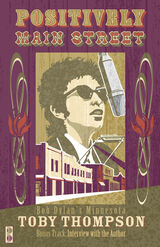 Positively Main Street: Bob Dylan’s Minnesota
Toby Thompson
University of Minnesota Press, 2008 “That boy . . . this fellow, Toby . . . has got some lessons to learn.” —Bob Dylan, Rolling Stone, November 29, 1969
"Toby Thompson was there first." —Greil Marcus
“A first-rate novelistic account of Thompson’s own psyche as he uncovers the Dylan few people know . . . A new look at young Dylan done with kindness, enthusiasm and superb language.” —William Kennedy, Look Magazine
“Essential reading. Thompson, unprecedentedly, managed to interview not only Echo Helstrom, almost certainly the ‘Girl of the North Country,’ but Dylan’s mother and brother, his uncle, his friends.” —Michael Gray, Bob Dylan Encyclopedia
“Dylan fans will not want to miss this book.” —Sioux City Journal
“Enough to satisfy any Dylan fan with all the gossip he’ll ever need.” —Huntsville Times
“Well worth the attention of anyone who has fallen under the spell of the boy from the North Country.” —Los Angeles Times
“It’s a must.” —Ft. Worth Press
"Thompson tracked down anybody who knew 'Die-lan' (as the Hibbingites called him), including the guy at the local music store, the guy at the motorcycle shop, his English and music teachers, his uncles, his brother David and even his reluctant but ultimately charmingly chatty mother. Of course, Thompson traveled into a few dead ends. But the stuff with Dylan's mom and his high school girlfriend, Echo Helstrom, is priceless. Positively Main Street is a free-wheelin', fun and quick read that is surprisingly informative." —Minneapolis Star Tribune
"Hundreds of books have been written about Minnesota's most famous songwriter; Bob Dylan's life and music has been analyzed by fans, scholars, and even himself. So, why do we need Toby Thompson's Positively Main Street: Bob Dylan's Minnesota? Because it's a forgotten milestone. Published in 1971, it was the first biography on Dylan. Although it's been out of print since 1977, the book is, with the exception of Dylan's autobiography, perhaps the most readable and necessary volume on the folk icon." —City Pages
"The new Positively Main Street is a lovely little book, even better than the original, a cherished addition to the Dylan bookshelf. Thompson and the University of Minnesota Press have enhanced what was already a classic and made it available to a whole new audience. Dylan fans owe them a debt of gratitude." —The Dylan Daily
"[Thompson] ends up not only interviewing 'the Girl from the North Country,' Echo Haelstrom, and 'Bob’s' mother and brother and teachers etc., but also filling in for Dylan among his old friends and acquaintances, playing Dylan’s songs on the guitar and harmonica and singing them, in a way that may have seemed stratingly revolutionary at the time for a journalist to do, he actually recreates a bit of Dylan’s existence as his own." —Michael Lally, Lally's Alley
Positively No Filipinos Allowed: Building Communities and Discourse
edited by Antonio T. Tiongson, Jr., Edgardo V. Gutierrez and Ricardo V. Gutierrez, foreword by Lisa Lowe
Temple University Press, 2006 From the perspectives of ethnic studies, history, literary criticism, and legal studies, the original essays in this volume examine the ways in which the colonial history of the Philippines has shaped Filipino American identity, culture, and community formation. The contributors address the dearth of scholarship in the field as well as show how an understanding of this complex history provides a foundation for new theoretical frameworks for Filipino American studies.
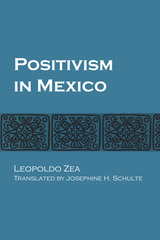 Positivism in Mexico
By Leopoldo Zea; Translated by Josephine H. Schulte
University of Texas Press, 1974 Positivism, not just an “ivory tower” philosophy, was a major force in the social, political, and educational life of Mexico during the last half of the nineteenth century. Once colonial conservatism had been conquered, the French Intervention ended, and Maximilian of Hapsburg executed, reformers wanted to create a new national order to replace the Spanish colonial one. The victorious liberals strove to achieve “mental emancipation,” a kind of second independence, which would abolish the habits and customs imposed on Mexicans by three centuries of colonialism. At this singular moment in Mexican history, positivism was offered as an extraordinary means and pathway to a new order. The next stage was the education of the Mexican people in this liberal philosophy and their incorporation into the process of development achieved by modern nations. Leopoldo Zea traces the forerunners of liberal thought and their influence during Juárez’s time and shows how this ideology degenerated into an “order and progress” philosophy that served merely to maintain colonial forms of exploitation and, at the same time, to create new ones that were peculiar to the neocolonialism that the great nations of the world imposed on other peoples. Zea examines the regime of Porfirio Díaz and its justification by the positivist philosophers of the period. He concludes that the conflict between exploited social groups, on the one hand, and foreign interests and a middle class on the margin of an oligarchy, on the other, brought about the movement known as the Mexican Revolution.
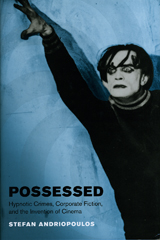 Possessed: Hypnotic Crimes, Corporate Fiction, and the Invention of Cinema
Stefan Andriopoulos
University of Chicago Press, 2008 Silent cinema and contemporaneous literature explored themes of mesmerism, possession, and the ominous agency of corporate bodies that subsumed individual identities. At the same time, critics accused film itself of exerting a hypnotic influence over spellbound audiences. Stefan Andriopoulos shows that all this anxiety over being governed by an outside force was no marginal oddity, but rather a pervasive concern in the late nineteenth and early twentieth centuries.
Tracing this preoccupation through the period’s films—as well as its legal, medical, and literary texts—Andriopoulos pays particular attention to the terrifying notion of murder committed against one’s will. He returns us to a time when medical researchers described the hypnotized subject as a medium who could be compelled to carry out violent crimes, and when films like The Cabinet of Dr. Caligari and Dr. Mabuse, the Gambler famously portrayed the hypnotist’s seemingly unlimited power on the movie screen. Juxtaposing these medicolegal and cinematic scenarios with modernist fiction, Andriopoulos also develops an innovative reading of Kafka’s novels, which center on the merging of human and corporate bodies.
Blending theoretical sophistication with scrupulous archival research and insightful film analysis, Possessed adds a new dimension to our understanding of today’s anxieties about the onslaught of visual media and the expanding reach of vast corporations that seem to absorb our own identities.
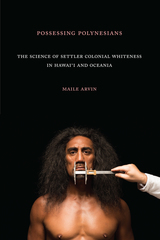 Possessing Polynesians: The Science of Settler Colonial Whiteness in Hawai`i and Oceania
Maile Arvin
Duke University Press, 2019 From their earliest encounters with Indigenous Pacific Islanders, white Europeans and Americans asserted an identification with the racial origins of Polynesians, declaring them to be racially almost white and speculating that they were of Mediterranean or Aryan descent. In Possessing Polynesians Maile Arvin analyzes this racializing history within the context of settler colonialism across Polynesia, especially in Hawai‘i. Arvin argues that a logic of possession through whiteness animates settler colonialism, by which both Polynesia (the place) and Polynesians (the people) become exotic, feminized belongings of whiteness. Seeing whiteness as indigenous to Polynesia provided white settlers with the justification needed to claim Polynesian lands and resources. Understood as possessions, Polynesians were and continue to be denied the privileges of whiteness. Yet Polynesians have long contested these classifications, claims, and cultural representations, and Arvin shows how their resistance to and refusal of white settler logic have regenerated Indigenous forms of recognition.
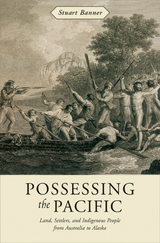 Possessing the Pacific: Land, Settlers, and Indigenous People from Australia to Alaska
Stuart Banner
Harvard University Press, 2007 During the nineteenth century, British and American settlers acquired a vast amount of land from indigenous people throughout the Pacific, but in no two places did they acquire it the same way. Stuart Banner tells the story of colonial settlement in Australia, New Zealand, Fiji, Tonga, Hawaii, California, Oregon, Washington, British Columbia, and Alaska. Today, indigenous people own much more land in some of these places than in others. And certain indigenous peoples benefit from treaty rights, while others do not. These variations are traceable to choices made more than a century ago—choices about whether indigenous people were the owners of their land and how that land was to be transferred to whites.
Banner argues that these differences were not due to any deliberate land policy created in London or Washington. Rather, the decisions were made locally by settlers and colonial officials and were based on factors peculiar to each colony, such as whether the local indigenous people were agriculturalists and what level of political organization they had attained. These differences loom very large now, perhaps even larger than they did in the nineteenth century, because they continue to influence the course of litigation and political struggle between indigenous people and whites over claims to land and other resources.
Possessing the Pacific is an original and broadly conceived study of how colonial struggles over land still shape the relations between whites and indigenous people throughout much of the world.
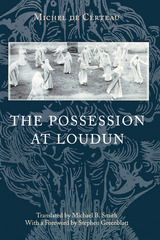 The Possession at Loudun
Michel de Certeau
University of Chicago Press, 2000 It is August 18, 1634. Father Urbain Grandier, convicted of sorcery that led to the demonic possession of the Ursuline nuns of provincial Loudun in France, confesses his sins on the porch of the church of Saint-Pierre, then perishes in flames lit by his own exorcists. A dramatic tale that has inspired many artistic retellings, including a novel by Aldous Huxley and an incendiary film by Ken Russell, the story of the possession at Loudun here receives a compelling analysis from the renowned Jesuit historian Michel de Certeau.
Interweaving substantial excerpts from primary historical documents with fascinating commentary, de Certeau shows how the plague of sorceries and possessions in France that climaxed in the events at Loudun both revealed the deepest fears of a society in traumatic flux and accelerated its transformation. In this tour de force of psychological history, de Certeau brings to vivid life a people torn between the decline of centralized religious authority and the rise of science and reason, wracked by violent anxiety over what or whom to believe.
At the time of his death in 1986, Michel de Certeau was a director of studies at the école des hautes études en sciences sociales, Paris. He was author of eighteen books in French, three of which have appeared in English translation as The Practice of Everyday Life,The Writing of History, and The Mystic Fable, Volume 1, the last of which is published by The University of Chicago Press.
"Brilliant and innovative. . . . The Possession at Loudun is [de Certeau's] most accessible book and one of his most wonderful."—Stephen Greenblatt (from the Foreword)
 Possession(s)
John Smolens
Michigan State University Press, 2026 In settings familiar and foreign, from the shores of the Great Lakes to rural Ireland and Scotland, the boulevards of nineteenth-century Paris, and an ancient Italian hill town, John Smolens’s stories delineate our fears, doubts, and uncertainties, tempered by irony, humor, and tenacity. The collection’s title, Possession(s), suggests an overarching duality that connects these fourteen disparate narratives, which include stories first published in magazines such as the North American Review, the Madison Review, and the Southern Review. In “prose that is an understated marvel” (Publishers Weekly) and through a wide range of compelling voices, each story resonates with compassion and honesty, often turning on unexpected encounters with a stranger, a place, the past, and sometimes with oneself, offset by a recognition that the future holds few assurances other than the promise of mortality. In their search for love, reconciliation, and acceptance, the characters in Possession(s) strive to find understanding and peace.
 Possessions: The History and Uses of Haunting in the Hudson Valley
Judith Richardson
Harvard University Press, 2003 The cultural landscape of the Hudson River Valley is crowded with ghosts--the ghosts of Native Americans and Dutch colonists, of Revolutionary War soldiers and spies, of presidents, slaves, priests, and laborers. Possessions asks why this region just outside New York City became the locus for so many ghostly tales, and shows how these hauntings came to operate as a peculiar type of social memory whereby things lost, forgotten, or marginalized returned to claim possession of imaginations and territories. Reading Washington Irving's stories along with a diverse array of narratives from local folklore and regional writings, Judith Richardson explores the causes and consequences of Hudson Valley hauntings to reveal how ghosts both evolve from specific historical contexts and are conjured to serve the present needs of those they haunt. These tales of haunting, Richardson argues, are no mere echoes of the past but function in an ongoing, contentious politics of place. Through its tight geographical focus, Possessions illuminates problems of belonging and possessing that haunt the nation as a whole.
Possessive Descriptions
Chris Barker
CSLI, 1995 What do possessive noun phrases mean? Although possessives are one of the most commonly used construction types cross-linguistically, they have never received detailed or sustained study from a semantic point of view. Taking work of Abney, May, and Heim as a starting point, this book develops a comprehensive analysis of the contribution of possessive NPs to the truth conditions of the sentences in which they occur.
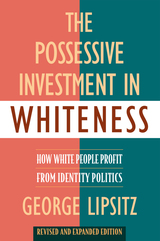 Possessive Investment In Whiteness
George Lipsitz
Temple University Press, 1998 Attacking the common view that whiteness is a meaningless category of identity, Lipsitz shows that public policy and private prejudice insure that whites wind up on top of the social hierarchy. Passionately and clearly written, this wide-ranging book probes into the social and material rewards that accrue to "the possessive investment in whiteness." Lipsitz sums up the ways that public policy has virtually excluded communities of color from everything that American society defines as desirable: first-rate education, decent housing, asset accumulation, political power, social status, satisfying work, and even the power it shape and narrate their own history. White supremacy is no thing of the past, no fringe movement. It is a pervasive and pernicious system that restricts the political and cultural agency of African Americans, Asian Americans, and Latinos every day. Unearned and unacknowledged, race-based advantages, not greater merit or a superior work ethic, account for white privilege.
Lipsitz's ultimate point is not to condemn all white people as racists but to challenge everyone to begin a principled examination of personal actions and political commitments. Exposing the system of unfairness is not enough. People of all groups -- but especially white people because they benefit from that system -- have to work toward eradicating the rewards of whiteness.
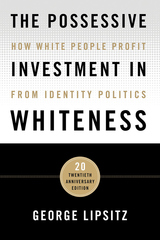 The Possessive Investment in Whiteness: How White People Profit from Identity Politics
George Lipsitz
Temple University Press, 2018 George Lipsitz’s classic book The Possessive Investment in Whiteness argues that public policy and private prejudice work together to create a possessive investment in whiteness that is responsible for the racialized hierarchies of our society. Whiteness has a cash value: it accounts for advantages that come to individuals through profits made from housing secured in discriminatory markets, through the unequal educational opportunities available to children of different races, through insider networks that channel employment opportunities to the friends and relatives of those who have profited most from past and present discrimination, and especially through intergenerational transfers of inherited wealth that pass on the spoils of discrimination to succeeding generations. White Americans are encouraged to invest in whiteness, to remain true to an identity that provides them with structured advantages. In this twentieth anniversary edition, Lipsitz provides a new introduction and updated statistics; as well as analyses of the enduring importance of Hurricane Katrina; the nature of anti-immigrant mobilizations; police assaults on Black women, the killings of Trayvon Martin, Michael Brown, and Freddie Gray; the legacy of Obama and the emergence of Trump; the Charleston Massacre and other hate crimes; and the ways in which white fear, white fragility, and white failure have become drivers of a new ethno-nationalism. As vital as it was upon its original publication, the twentieth anniversary edition of The Possessive Investment in Whiteness is an unflinching but necessary look at white supremacy.
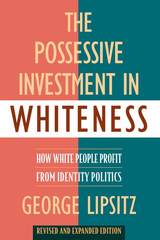 The Possessive Investment in Whiteness: How White People Profit from Identity Politics, Revised and Expanded Edition
George Lipsitz
Temple University Press, 2006 In this unflinching look at white supremacy, George Lipsitz argues that racism is a matter of interests as well as attitudes, a problem of property as well as pigment. Above and beyond personal prejudice, whiteness is a structured advantage that produces unfair gains and unearned rewards for whites while imposing impediments to asset accumulation, employment, housing, and health care for minorities. Reaching beyond the black/white binary, Lipsitz shows how whiteness works in respect to Asian Americans, Latinos, and Native Americans.Lipsitz delineates the weaknesses embedded in civil rights laws, the racial dimensions of economic restructuring and deindustrialization, and the effects of environmental racism, job discrimination and school segregation. He also analyzes the centrality of whiteness to U.S. culture, and perhaps most importantly, he identifies the sustained and perceptive critique of white privilege embedded in the radical black tradition. This revised and expanded edition also includes an essay about the impact of Hurricane Katrina on working class Blacks in New Orleans, whose perpetual struggle for dignity and self determination has been obscured by the city's image as a tourist party town.
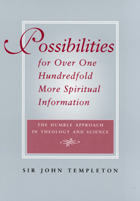 Possibilities for Over One Hundredfold More Spiritual Information: The Humble Approach in Theology and Science
Sir John Templeton
Templeton Press, 2000 Sir John Templeton challenges the reader to apply the same energy that has been devoted to scientific inquiry to the pursuit of spiritual information. The world is at a state of unprecedented technical expertise, but why has our knowledge and faith in our own spirituality stalled and become obsolete in recent times? Possibilities for Over One Hundredfold More Spiritual Information seeks to address this question. It points out that our spiritual knowledge would also have the capacity to increase dramatically if we were to open our minds to the endless possibilities that await us in terms of our spiritual lives. These include altruistic love for all people, new knowledge of the Divine, and a greater sense of our place in the universe. In order for us as human beings to take advantage of all of the spiritual gifts that we have been given, we need to be open and receptive to our individual spiritual natures, and to open ourselves to the limitless spiritual possibilities available to us. The book acknowledges the ancient scriptures and thinkers who have guided us for centuries. Vastly expanded research and the use of scientific method would only enhance our understanding of the wisdom contained within these wise teachings. The benefits of extending our spiritual knowledge might, in fact, exceed the benefits we have realized thus far from scientific and medical advances. Possibilities seeks to reawaken our desire for spiritual knowledge pushed aside so long ago in our quest for scientific knowledge. When these fields work together, the world will reap greater rewards that we can ever imagine.
 Possibility and Necessity: Volume 1
Jean PiagetTranslated by Helga Feider
University of Minnesota Press, 1987
Possibility and Necessity was first published in 1987. Minnesota Archive Editions uses digital technology to make long-unavailable books once again accessible, and are published unaltered from the original University of Minnesota Press editions.
Jean Piaget was preoccupied, later in life, with the developing child's understanding of possibility—how the child becomes aware of the potentially unlimited scope of possible actions and learns to choose among them. Piaget's approach to this question took on a new openness to real-life situations, less deterministic than his earlier, ground-breaking work in cognitive development. The resulting two-volume work—his last—was published in France in 1981 and 1983 and is not available for the first time in English translation. Possibility and Necessity combines theoretical interpretation with detailed summaries of the experiments that Piaget and his colleagues used to test their hypotheses.
Piaget's intent, in Volume 1, is to explore the process whereby possibilities are formed. He chooses to understand "the possible" not as something predetermined by initial conditions; rather, in his use of the term, possibilities are constantly coming into being, and have no static characteristics—each arises from an event which has produced an opening onto it, and its actualization will in turn give rise to other openings. In perceiving that a possibility can be realized, and in acting upon it, the child creates something that did not exist before.
To observe this process, Piaget and his associates devised a series of thirteen problems appropriate for children ranging in age from four or five to eleven or twelve; they were asked to name all possible ways three dice might be arranged, for example, or a square of paper sectioned. The experimenters had two primary aims—to discover to what extent the child's capacity to see possibilities develops with age, and to determine the place in cognitive development of this capacity—does it precede or follow the advent of operational thought structures? In charting this process, Piaget discerns a growing interaction between possibility and necessity. How the child comes to understand necessity and achieves a dynamic synthesis—or equilibrium — between the possible and the necessary is discussed by Piaget and his colleagues in Volume 2, The Role of Necessity in Cognitive Development, also published by Minnesota.
 Possibility and Necessity: Volume 2
Jean PiagetTranslated by Helga Feider
University of Minnesota Press, 1987
Possibility and Necessity was first published in 1987. Minnesota Archive Editions uses digital technology to make long-unavailable books once again accessible, and are published unaltered from the original University of Minnesota Press editions.
This two-volume work—Jean Piaget's last—was published in France in 1981 and 1983 and is available now for the first time in English translation. Reflecting the preoccupations and methodologies of his later years, Possibility and Necessity combines theoretical interpretation with detailed summaries of the experiments Piaget and his colleagues used to test their hypotheses.
Volume 2 presents a series of experiments documenting the way children between the ages of four or five and eleven to thirteen come to develop a grasp of necessity and its role in understanding the world about them. The experiments show how children proceed from an initial level (at four or five years) of pseudo-necessities, where they see the world as necessarily what it appears to be without the existence of other possibilities, to an intermediate level (at six to ten years), where pseudo-necessities give way to increasingly rich arrays of possibilities, and a final stage (at eleven to thirteen years), where children are able to select among these multiple possibilities the one that fits all the data. This stage represents the optimal level of understanding reality, which is now seen by the child as infinitely variable yet coherent and lawful. Psychologically, this lawfulness corresponds to a sense of necessity, or certainty.
Volume 2 thus completes the theory presented in Volume 1 (The Role of Possibility in Cognitive Development) by showing how cognitive development is mediated on the one hand by a dialectical process of ever-expanding possibilities and, on the other, by increasingly delimiting necessities. In demonstrating how this process operates in psychological development—and in pointing out analogies in the history of science — Piaget gave his genetic epistemology its final and most accomplished form. The acquisition of knowledge is thus shown to be the result of two complementary processes: the formation of possibilities and the grasping of necessary laws and constraints in the construction of a reasoned representation of the external world.
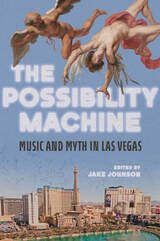 The Possibility Machine: Music and Myth in Las Vegas
Edited by Jake Johnson
University of Illinois Press, 2023 Singular and star-studded writings on America’s neon-lit playground At once a Technicolor wonderland and the embodiment of American mythology, Las Vegas exists at the Ground Zero of a reverence for risk-taking and the transformative power of a winning hand. Jake Johnson edits a collection of short essays and flash ideas that probes how music-making and soundscapes shape the City of Second Chances. Treating topics ranging from Cher to Cirque de Soleil, the contributors delve into how music and musicians factored in the early development of Vegas’s image; the role of local communities of musicians and Strip mainstays in sustaining tensions between belief and disbelief; the ways aging showroom stars provide a sense of timelessness that inoculates visitors against the outside world; the link connecting fantasies of sexual prowess and democracy with the musical values of Liberace and others; considerations of how musicians and establishments gambled with identity and opened the door for audience members to explore Sin City–only versions of themselves; and the echoes and energy generated by the idea of Las Vegas as it travels across the country. Contributors: Celine Ayala, Kirstin Bews, Laura Dallman, Joanna Dee Das, James Deaville, Robert Fink, Pheaross Graham, Jessica A. Holmes, Maddie House-Tuck, Jake Johnson, Kelly Kessler, Michael Kinney, Carlo Lanfossi, Jason Leddington, Janis McKay, Sam Murray, Louis Niebur, Lynda Paul, Arianne Johnson Quinn, Michael M. Reinhard, Laura Risk, Cassaundra Rodriguez, Arreanna Rostosky, and Brian F. Wright
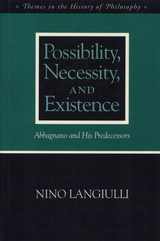 Possibility Necessity and Existence: Abbagnano and His Predecessors
Nino Langiulli
Temple University Press, 1992 In this systematic historical analysis, Nino Langiulli focuses on a key philosophical issue, possibility, as it is refracted through the thought of the Italian philosopher Nicola Abbagnano. Langiulli examines Abbagnano's attempt to raise possibility to a level of prime importance and investigates his understanding of existence. In so doing, the author offers a sustained exposition of and argument with the account of possibility in the major thinkers of the Western tradition—Plato, Aristotle, Kant, and Kierkegaard. He also makes pertinent comments on such philosophers as Diodorus Cronus, William of Ockham, Spinoza, Hobbes, and Hegel, as well as such logicians as DeMorgan and Boole. Nicola Abbagnano, who died in 1990, recently came to the attention of the general public as an influential teacher of author Umberto Eco. Creator of a dictionary of philosophy and author of a multiple-volume history of Western philosophy, Abbagnano was the only philosopher, according to Langiulli, to argue that "to be is to be possible." Even though the concept of probability and the discipline of statistics are grounded in the concept of possibility, philosophers throughout history have grappled with the problem of defining it. Possibility has been viewed by some as an empty concept, devoid of reality, and by others as reducible to actuality or necessity—concepts which are opposite to it. Langiulli analyzes and debates Abbagnano's treatment of necessity as secondary to possibility, and he addresses the philosopher's conversation with his predecessors as well as his European and American contemporaries. In the series Themes in the History of Philosophy, edited by Edith Wyschogrod.
The Possibility of Language: Internal Tensions in Wittgenstein's Tractatus
Maria Cerezo
CSLI, 2003 In this volume, Maria Cerezo examines Wittgenstein's Tractatus Logico-Philosophicus as a response to some of Frege's and Russel's logical problems. In analyzing the tractarian conditions for the possibility of language, she explains the two main theories of the proposition in Tractatus: the truth-functions theory and the picture theory. Cerezo shows that Wittgenstein initially separates the account of the structure of a proposition from the explanation of its expression. However, contrary to his intention, the combination of these theories creates new difficulties, since the requirements of each theory cannot be fully respected by the others. Cerezo also argues that Wittgenstein's theory of language cannot be fully understood unless attention is paid to his theory of expression and his doctrine of projection by the metaphysical subject.
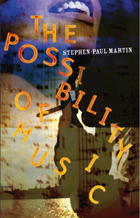 The Possibility of Music
Stephen-Paul Martin
University of Alabama Press, 2007 An exhilarating collection about the limits of language, narrative, and identity. The Possibility of Music is an imaginative reconstruction of America in the early 21st century. What would our post-9/11 society look like if it were viewed through a series of funhouse mirrors?
Each of Stephen-Paul Martin’s stories is a response to this question, a prose exploration that redefines what it means to write fiction in a world in which the Sistein Chapel has become the Mall of America. Nightmarish at times, playfully amusing at others, Martin’s prose is relentlessly inventive and challenging, relocating the experimental tradition of Joyce, Kafka, Borges, and Marquez in a contemporary context in which intelligent communication has become both impossible and increasingly necessary.
"I’d always told myself that if I ever wrote my own music," the narrator of one story says, "every composition would become its own distinct struggle with aesthetic questions that emerged as the process unfolded." In good part, that’s what animates The Possibility of Music, a book in which John Coltrane’s "Love Supreme" moves through characters and stories like a soundtrack.
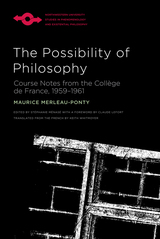 The Possibility of Philosophy: Course Notes from the Collège de France, 1959–1961
Maurice Merleau-Ponty, Edited by Stéphanie Ménasé with a foreword by Claude Lefort, Translated from the French by Keith Whitmoyer
Northwestern University Press, 2022 The Possibility of Philosophy presents the notes that Maurice Merleau‑Ponty prepared for three courses he taught at the Collège de France: “The Possibility of Philosophy Today,” given in the spring semester of 1959, and “Cartesian Ontology and Ontology Today” and “Philosophy and Nonphilosophy since Hegel,” both given in the spring semester of 1961. The last two courses remain incomplete due to Merleau-Ponty’s unexpected death on May 3, 1961. Nonetheless, they provide indications of the new ontology that informed The Visible and the Invisible, a posthumously published work that was under way at the same time. These courses offer readers of Merleau‑Ponty’s late thought a wealth of references—to painting, literature, and psychoanalysis, and to the works of Husserl, Heidegger, Descartes, Hegel, and Marx—that fill in some of the missing pieces of The Visible and the Invisible, especially its often terse and sometimes cryptic working notes. We see more clearly how Merleau-Ponty’s attempt to bring forth a new ontology indicates a fundamental revision in what it means to think, an attempt to reimagine the possibility of philosophy.
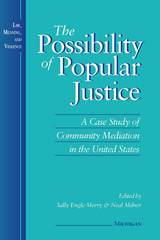 The Possibility of Popular Justice: A Case Study of Community Mediation in the United States
Sally Engle Merry and Neal Milner, Editors
University of Michigan Press, 1995 "The Possibility of Popular Justice is essential reading for scholars and practitioners of community mediation and should be very high on the list of anyone seriously concerned with dispute resolution in general. The book offers many rewards for the advanced student of law and society studies." --Law and Politics Book Review
"These immensely important articles--fifteen in all--take several academic perspectives on the [San Francisco Community Boards] program's diverse history, impact, and implications for 'popular justice.' These articles will richly inform the program, polemical, and political perspectives of anyone working on 'alternative programs' of any sort." -- IARCA Journal
"Few collections are so well integrated, analytically penetrating, or as readable as this fascinating account. It is a 'must read' for anyone interested in community mediation." --William M. O'Barr, Duke University
"You do not have to be involved in mediation to appreciate this book. The authors use the case as a launching pad to evaluate the possibilities and 'impossibilities' of building community in complex urban areas and pursuing popular justice in the shadow of state law." --Deborah M. Kolb, Harvard Law School and Simmons College
Sally Engle Merry is Professor of Anthropology, Wellesley College. Neal Milner is Professor of Political Science and Director of the Program on Conflict Resolution, University of Hawaii.
The Possibility of Practical Reason
J. David Velleman
Michigan Publishing, 2015 The Possibility of Practical Reason explores the foundational questions of moral psychology: How can any of our behavior qualify as acting for a reason? How can any considerations qualify as reasons for us to act? David Velleman argues that both possibilities depend on there being a constitutive aim of action―something that makes for success in action as such. These twelve essays―five of which were not included in the previous edition, two of them previously unpublished―discuss topics such as freedom of the will, shared intention, the relation between value and practical reasoning, the foundations of decision theory, and the motivational role of the imagination.
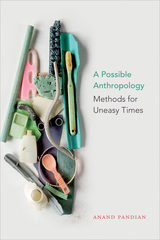 A Possible Anthropology: Methods for Uneasy Times
Anand Pandian
Duke University Press, 2019 In a time of intense uncertainty, social strife, and ecological upheaval, what does it take to envision the world as it yet may be? The field of anthropology, Anand Pandian argues, has resources essential for this critical and imaginative task. Anthropology is no stranger to injustice and exploitation. Still, its methods can reveal unseen dimensions of the world at hand and radical experience as the seed of a humanity yet to come. A Possible Anthropology is an ethnography of anthropologists at work: canonical figures like Bronislaw Malinowski and Claude Lévi-Strauss, ethnographic storytellers like Zora Neale Hurston and Ursula K. Le Guin, contemporary scholars like Jane Guyer and Michael Jackson, and artists and indigenous activists inspired by the field. In their company, Pandian explores the moral and political horizons of anthropological inquiry, the creative and transformative potential of an experimental practice.
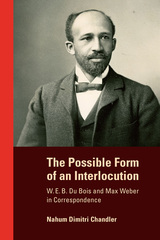 The Possible Form of an Interlocution: W. E. B. Du Bois and Max Weber in Correspondence
Nahum Dimitri Chandler
Duke University Press, 2025 In The Possible Form of an Interlocution, Nahum Dimitri Chandler provides an epistemological and theoretical elaboration of the correspondence between W. E. B. Du Bois and Max Weber in 1904 and 1905. Their interlocution took place under the heading of Du Bois’s famous formulation “the problem of the color line.” This study takes as its incipient reference Weber’s statement to Du Bois that “I am absolutely convinced that the ‘color-line’ problem will be the paramount problem of the time to come, here and everywhere in the world.” Chandler provides a concise statement of Du Bois’s thought of “the problem of the color line” as a general formulation for understanding African American matters within modern historicity on a worldwide scale. He then examines Weber’s earliest writings to understand in just what way “the ‘color-line’ problem", served as a problematization for Weber in both his thought and itinerary, across the 1890s and through the time of their interlocution.
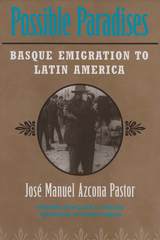 Possible Paradises: Basque Emigration to Latin America
Azcona Pastor
University of Nevada Press, 2003 From Columbus's first voyage to "the Indies" in 1492, Basques participated in Spain's American enterprise. Supported by centuries of experience as mariners, shipbuilders, traders, miners, and ironworkers; encouraged toward emigration by restrictive inheritance laws and a land-poor territory; and conditioned by a culture that prized hard work and social solidarity, the Basques were poised to play a significant role in the exploration and development of the New World. The first Basques arrived with Columbus, and well into the twentieth century they continued to arrive seeking livelihood and refuge.
Possible Paradises, José Manuel Azcona Pastor's engaging and meticulously researched study of Basque emigration to the Americas, is a path breaking work of monumental importance. Ranging over the entire former Spanish American empire from Tierra del Fuego to the U.S. Southwest and covering over five centuries of history, Azcona examines the roles and fates of the Basques who came to the New World. He also studies the impact of the New World on the Basque Country, from the importance in the modern Basque diet of such American foodstuffs as corn and beans to the encouragement given to traditional Basque industries by the colonizers' demand for ships and iron tools. He considers the role of Basques in the Spanish imperial expeditions of exploration and conquest; their participation in transatlantic commerce and communication.
The Basque diaspora, although worldwide in dimension, has had its greatest presence and importance in the Americas. Azcona's pioneering study views the Basque presence in the New World through the broadest possible lens, linking Basque communities and activities from Argentina to the North American West.
Foreword by William A. Douglass. Translation by Roland Vazquez.
Possible Worlds: Jorge Luis Borges's (Pseudo-) Translations of Virginia Woolf and Franz Kafka
Rebecca DeWald
University of London Press, 2020 This volume reevaluates and overturns the assumed hierarchical relationship between original text and translation with an approach that places source and target texts as equal. Combining the translation strategy of Argentine writer Jorge Luis Borges, the theoretical approaches of Walter Benjamin and Michel Foucault, and the exponents of Possible World Theory, the author examines Virginia Woolf’s Orlando and Franz Kafka’s short stories in detail. Rather than considering what may be lost in translation, this study focuses on why we insist on maintaining a border between the textual phenomena of “translation” and “original” and argues for a mutually enriching dialogue between two texts.
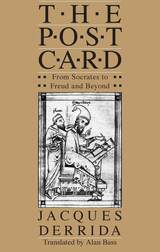 The Post Card: From Socrates to Freud and Beyond
Jacques Derrida
University of Chicago Press, 1987 17 November 1979
You were reading a somewhat retro loveletter, the last in history. But you have not yet received it. Yes, its lack or excess of address prepares it to fall into all hands: a post card, an open letter in which the secret appears, but indecipherably.
What does a post card want to say to you? On what conditions is it possible? Its destination traverses you, you no longer know who you are. At the very instant when from its address it interpellates, you, uniquely you, instead of reaching you it divides you or sets you aside, occasionally overlooks you. And you love and you do not love, it makes of you what you wish, it takes you, it leaves you, it gives you.
On the other side of the card, look, a proposition is made to you, S and p, Socrates and plato. For once the former seems to write, and with his other hand he is even scratching. But what is Plato doing with his outstretched finger in his back? While you occupy yourself with turning it around in every direction, it is the picture that turns you around like a letter, in advance it deciphers you, it preoccupies space, it procures your words and gestures, all the bodies that you believe you invent in order to determine its outline. You find yourself, you, yourself, on its path.
The thick support of the card, a book heavy and light, is also the specter of this scene, the analysis between Socrates and Plato, on the program of several others. Like the soothsayer, a "fortune-telling book" watches over and speculates on that-which-must-happen, on what it indeed might mean to happen, to arrive, to have to happen or arrive, to let or to make happen or arrive, to destine, to address, to send, to legate, to inherit, etc., if it all still signifies, between here and there, the near and the far, da und fort, the one or the other.
You situate the subject of the book: between the posts and the analytic movement, the pleasure principle and the history of telecommunications, the post card and the purloined letter, in a word the transference from Socrates to Freud, and beyond. This satire of epistolary literature had to be farci, stuffed with addresses, postal codes, crypted missives, anonymous letters, all of it confided to so many modes, genres, and tones. In it I also abuse dates, signatures, titles or references, language itself.
J. D.
"With The Post Card, as with Glas, Derrida appears more as writer than as philosopher. Or we could say that here, in what is in part a mock epistolary novel (the long section is called "Envois," roughly, "dispatches" ), he stages his writing more overtly than in the scholarly works. . . . The Post Card also contains a series of self-reflective essays, largely focused on Freud, in which Derrida is beautifully lucid and direct."—Alexander Gelley, Library Journal
 Post Scripts: The Writer’s Workshop
Vincent Kaufmann
Harvard University Press, 1994 We assume that words are posted (mailed or, in another sense, positioned) to communicate with others, to bridge distance and “wish you were here.” But Vincent Kaufmann discovers in his chosen letter writers the urgency not to communicate, to keep their correspondents away and, as it were, posted. The writer avoids real-life dialogue by way of letters, which then become proving grounds for the work to come. Whatever their intellectual, biographical, or aesthetic value—compare Flaubert’s passionate dogmatizing to Baudelaire’s peevish nagging for money—letters teach writers how to appreciate the sound of their own voice and how to make a workable literary space. Distance gives the relentless letter writer the chance to become a writer. Kaufmann, with Lacan, says that what characterizes the literary text is the ability to get beyond a particular other to address the Other, which must be no one in particular.
Kaufmann features several European writers, all of them avidly concerned about the destination of speech when it passes into writing. Among them: Kafka, obsessions spilling over, adoring his fiancee for her emptiness; Proust, master of suffering, with his interminable health bulletins, cancellations, and condolences; Flaubert, an extraordinary letter writer, abandoning his mistress for the more seductive Emma Bovary; Baudelaire, determined in squalor, writing letters almost exclusively about his debts, as if to practice the art of escape and defiance; Mallarmé, patron saint of littérateurs, whose vaunted Book disappears into salons and letters; Artaud, speaker in tongues, who wildly searched for authenticity through letters.
Unending attention has been devoted to these important writers, but they seem new again when viewed in Kaufmann’s epistolary mirror. What they share is a taste, or need, for distance and perversion; we see them becoming “inhuman” in order to textualize their lives. They are all modernists, and the definition of Modernism is thereby deepened. This book—rich in anecdote and humor—escorts literary theory into the no-man’s-land stretching between the life and the word.
 The Post-1945 Internationalization of Economics, Volume 28
A. W. Coats
Duke University Press In addressing the internationalization of economics after 1945, these essays are concerned with aspects of economic education, the economist’s role in policymaking, and the sociology and professionalization of the discipline. These matters have rarely been considered in international terms. While discussing organizations such as the World Bank, International Monetary Fund, and the European Community, and presenting studies that are primarily concerned with the effect of these developments in particular countries, this volume focuses on the situation of Latin America. Arguably, the post-1945 internationalization of economics has proceeded further, more dramatically, and with greater effect in that continent than in any other region of comparable size. Contributors. S. Ambirajan, William Ascher, William J. Barber, Young Back Choi, A. W. Coats, Barend de Vries, Margaret Garrison de Vries, Peter Groenewegen, Arnold Harberger, Aiko Ikeo, Maria Rita Loureiro, Ivo Maes, Veronica Montecinos, Jacques J. Polak, Pier Luigi Porta, Bo Sandelin, Ann Veiderpass, John Williamson
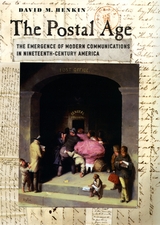 The Postal Age: The Emergence of Modern Communications in Nineteenth-Century America
David M. Henkin
University of Chicago Press, 2006 Americans commonly recognize television, e-mail, and instant messaging as agents of pervasive cultural change. But many of us may not realize that what we now call snail mail was once just as revolutionary. As David M. Henkin argues in The Postal Age, a burgeoning postal network initiated major cultural shifts during the nineteenth century, laying the foundation for the interconnectedness that now defines our ever-evolving world of telecommunications.
This fascinating history traces these shifts from their beginnings in the mid-1800s, when cheaper postage, mass literacy, and migration combined to make the long-established postal service a more integral and viable part of everyday life. With such dramatic events as the Civil War and the gold rush underscoring the importance and necessity of the post, a surprisingly broad range of Americans—male and female, black and white, native-born and immigrant—joined this postal network, regularly interacting with distant locales before the existence of telephones or even the widespread use of telegraphy. Drawing on original letters and diaries from the period, as well as public discussions of the expanding postal system, Henkin tells the story of how these Americans adjusted to a new world of long-distance correspondence, crowded post offices, junk mail, valentines, and dead letters.
The Postal Age paints a vibrant picture of a society where possibilities proliferated for the kinds of personal and impersonal communications that we often associate with more recent historical periods. In doing so, it significantly increases our understanding of both antebellum America and our own chapter in the history of communications.
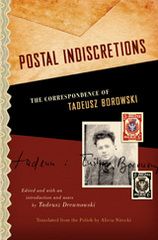 Postal Indiscretions: The Correspondence of Tadeusz Borowski
Tadeusz Drewnowski
Northwestern University Press, 2007 In a brief life deeply and traumatically disrupted by two years in concentration camps as a political prisoner, Tadeusz Borowski (1922–1951) was tragically destined to become one of the most eloquent witnesses to the Holocaust in Poland. His recollections and stories, the most famous of which is This Way for the Gas, Ladies and Gentlemen, document in stark historical, literary, and personal terms the experience of the camps and its cost to humanity.
This correspondence in this volume expands on the insights of Borowski’s published work and extends to the less-documented aftermath of the Holocaust in postwar Poland and East Germany. The volume opens with Borowski’s letter to his mother from Pawiak Prison the day after his arrest and closes with an unsigned telegram informing his parents of his suicide. The letters to and from family members, friends, and literary figures offer an indispensable picture of the world in the wake of the Nazis—and of the indelible stain that experience left upon the literature, politics, and life of Eastern Europe, in particular upon one gifted and doomed writer.
 Post-Anarchism: A Reader
Edited by Duane Rousselle and Sureyyya Evren
Pluto Press, 2011 Post-anarchism has been of considerable importance in the discussions of radical intellectuals across the globe in the last decade. In its most popular form, it demonstrates a desire to blend the most promising aspects of traditional anarchist theory with developments in post-structuralist and post-modernist thought. Post-Anarchism: A Reader includes the most comprehensive collection of essays about this emergent body of thought, making it an essential and accessible resource for academics, intellectuals, activists and anarchists interested in radical philosophy.
Many of the chapters have been formative to the development of a distinctly 'post-anarchist' approach to politics, aesthetics, and philosophy. Others respond to the so-called 'post-anarchist turn' with caution and scepticism. The book also includes original contributions from several of today's 'post-anarchists', inviting further debate and new ways of conceiving post-anarchism across a number of disciplines.
Post-Authoritarian Cultures: Spain and Latin America's Southern Cone
Luis Martín-Estudillo
Vanderbilt University Press, 2008 This volume explores the role played by culture in the transition to democracy in Latin America's Southern Cone (Argentina, Uruguay, Chile) and Spain, with a focus on opposing stances of acceptance and defiance by artists and intellectuals in post-authoritarian regimes.
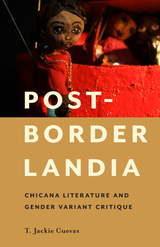 Post-Borderlandia: Chicana Literature and Gender Variant Critique
Cuevas, T. Jackie
Rutgers University Press, 2018 Honorable Mention, 2018 Gloria E. Anzaldúa Book Prize from the National Women's Studies Association
2019 Lambda Literary Awards Finalist
Bringing Chicana/o studies into conversation with queer theory and transgender studies, Post-Borderlandia examines why gender variance is such a core theme in contemporary Chicana and Chicanx narratives. It considers how Chicana butch lesbians and Chicanx trans people are not only challenging heteropatriarchal norms, but also departing from mainstream conceptions of queerness and gender identification.
Expanding on Gloria Anzaldúa’s classic formulation of the Chicana as transformer of the “borderlands,” Jackie Cuevas explores how a new generation of Chicanx writers, performers, and filmmakers are imagining a “post-borderlands” subjectivity, where shifting national, racial, class, sexual, and gender identifications produce complex power dynamics. In addition, Cuevas offers fresh archival analysis of the Chicana feminist canon to reveal how queer gender variance has always been crucial to this literary tradition.
 Postcapitalist Countrysides: From Commoning to Community Wealth Building
Edited by Nick Gallent, Menelaos Gkartzios, Mark Scott, and Andrew Purves
University College London, 2025 Reimagining rural life beyond capitalism, this volume reviews alternative economic structures that center on sustainability and community wealth-building.
Postcapitalist Countrysides exposes the entrenched inequalities that capitalism has imposed on rural communities and charts a path toward more just and sustainable futures. Built upon case studies from around the world, the book critiques the failures of privatization and market-driven development while showcasing alternative economic models that reclaim land and wealth for the many, not the few.
Through analyses of land reform and community wealth building, contributors depict how local initiatives can reshape rural economies and empower communities when reinforced by structural change. From challenging exploitative land ownership to confronting the encroachment of platform capitalism, this volume engages with urgent global crises while offering tangible strategies for transformation. Postcapitalist Countrysides presents a bold vision for rural life beyond capitalism—one rooted in collective prosperity and resilience.
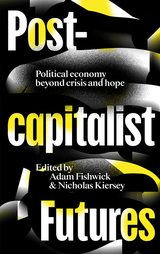 Post-capitalist Futures: Political Economy Beyond Crisis and Hope
Adam Fishwick
Pluto Press, 2021 This book critically engages with the proliferation of literature on postcapitalism, which is rapidly becoming an urgent area of inquiry, both in academic scholarship and in public life. It collects the insights from scholars working across the field of Critical International Political Economy to interrogate how we might begin to envisage a political economy of postcapitalism. The authors foreground the agency of workers and other capitalist subjects, and their desire to engage in a range of radical experiments in decommodification and democratization both in the workplace and in their daily lives. It includes a broad range of ideas including the future of social reproduction, human capital circulation, political Islam, the political economy of exclusion and eco-communities. Rather than focusing on the ending of capitalism as an implosion of the value-money form, this book focuses on the dream of equal participation in the determination of people's shared collective destiny.
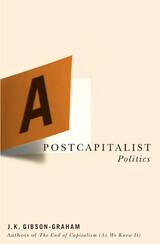 A Postcapitalist Politics
J. K. Gibson-Graham
University of Minnesota Press, 2006 Is there life after capitalism? In this creatively argued follow-up to their book The End of Capitalism (As We Knew It), J. K. Gibson-Graham offer already existing alternatives to a global capitalist order and outline strategies for building alternative economies.
A Postcapitalist Politics reveals a prolific landscape of economic diversity—one that is not exclusively or predominantly capitalist—and examines the challenges and successes of alternative economic interventions. Gibson-Graham bring together political economy, feminist poststructuralism, and economic activism to foreground the ethical decisions, as opposed to structural imperatives, that construct economic “development” pathways. Marshalling empirical evidence from local economic projects and action research in the United States, Australia, and Asia, they produce a distinctive political imaginary with three intersecting moments: a politics of language, of the subject, and of collective action. In the face of an almost universal sense of surrender to capitalist globalization, this book demonstrates that postcapitalist subjects, economies, and communities can be fostered. The authors describe a politics of possibility that can build different economies in place and over space. They urge us to confront the forces that stand in the way of economic experimentation and to explore different ways of moving from theory to action.
J. K. Gibson-Graham is the pen name of Katherine Gibson and Julie Graham, feminist economic geographers who work, respectively, at the Australian National University in Canberra and the University of Massachusetts Amherst.
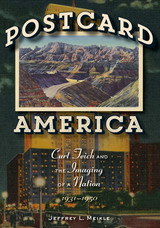 Postcard America: Curt Teich and the Imaging of a Nation, 1931-1950
By Jeffrey L. Meikle
University of Texas Press, 2016 Extensively illustrated with representative images, this unique book illuminates the cultural significance of the highly colorized “linen” postcards that depicted a glowing America in the 1930s and 1940s and that fascinate collectors today. From the Great Depression through the early postwar years, any postcard sent in America was more than likely a “linen” card. Colorized in vivid, often exaggerated hues and printed on card stock embossed with a linen-like texture, linen postcards celebrated the American scene with views of majestic landscapes, modern cityscapes, roadside attractions, and other notable features. These colorful images portrayed the United States as shimmering with promise, quite unlike the black-and-white worlds of documentary photography or Life magazine. Linen postcards were enormously popular, with close to a billion printed and sold. Postcard America offers the first comprehensive study of these cards and their cultural significance. Drawing on the production files of Curt Teich & Co. of Chicago, the originator of linen postcards, Jeffrey L. Meikle reveals how photographic views were transformed into colorized postcard images, often by means of manipulation—adding and deleting details or collaging bits and pieces from several photos. He presents two extensive portfolios of postcards—landscapes and cityscapes—that comprise a representative iconography of linen postcard views. For each image, Meikle explains the postcard’s subject, describes aspects of its production, and places it in social and cultural contexts. In the concluding chapter, he shifts from historical interpretation to a contemporary viewpoint, considering nostalgia as a motive for collectors and others who are fascinated today by these striking images.
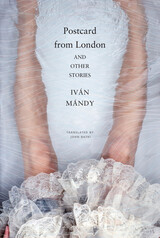 Postcard from London: and Other Stories
Iván Mándy
Seagull Books, 2021 The first comprehensive volume in English from one of Hungary’s most popular twentieth-century writers.
Iván Mándy (1918–1995) has been called “the prose poet of Budapest,” and this volume of short stories presents the first comprehensive collection of his work in English. His early oeuvre created an urban mythology full of picaresque characters inhabiting the seedier neighborhoods of the city: its flea-market stalls, second-run cinemas, and old-fashioned coffeehouses. The stories from the later decades of Mándy’s life, often bordering on the absurd, introduce many autobiographical elements spun around the author’s alter-ego, János Zsámboky, whose hapless adventures on a rare trip abroad constitute this group of stories, including “Postcard from London.” Mándy’s unique style at times borrows techniques from films and radio plays, his quirky cuts creating a flicker of images seen in the mind’s eye. Memory and perception, time and place spin in narrative legerdemain that invites and rewards the reader’s active participation.
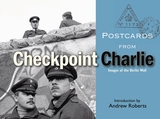 Postcards from Checkpoint Charlie: Images of the Berlin Wall
Edited by the Bodleian Library
Bodleian Library Publishing, 2008 Between 1945 and 1961, an estimated 2.5 million people fled East Germany in search of the political and economic freedom offered by West Germany. To thwart this tide of defections, on the morning of August 13, 1961, hundreds of East German troops began erecting the Berlin wall—a barrier that would take nearly twenty years to complete and would eventually span 166 kilometers. In Postcards from Checkpoint Charlie, the Bodleian Library assembles a stunning collection of images to document the wall’s impact worldwide.
The postcards in this fascinating volume trace the development of the wall—from its beginnings as a simple stretch of barbed wire to the daunting final structure made of concrete and containing over 300 watchtowers. The images capture scenes of tension and urgency, such as those at Checkpoint Charlie, where we see Allied and East German soldiers coldly observing one another through binoculars. Others document the wall’s ties with American history, including pictures of John F. Kennedy in 1963 when he declared his solidarity with all Berliners and a picture of Ronald Regan when he implored Mikhail Gorbachev to tear down the wall. Also included are images from the toppling of the wall, when thousands of joyful East Germans realized the fulfillment of their personal dreams and marked the conclusion of the cold war.
An intimate look at one of the most visible manifestations of the postwar divide, Portraits from Checkpoint Charlie presents a key location in twentieth-century history through the eyes of those on the scene.
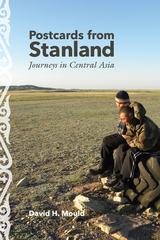 Postcards from Stanland: Journeys in Central Asia
David H. Mould
Ohio University Press, 2015 Central Asia has long stood at the crossroads of history. It was the staging ground for the armies of the Mongol Empire, for the nineteenth-century struggle between the Russian and British empires, and for the NATO campaign in Afghanistan. Today, multinationals and nations compete for the oil and gas reserves of the Caspian Sea and for control of the pipelines. Yet “Stanland” is still, to many, a terra incognita, a geographical blank.
Beginning in the mid-1990s, academic and journalist David Mould’s career took him to the region on Fulbright Fellowships and contracts as a media trainer and consultant for UNESCO and USAID, among others. In Postcards from Stanland, he takes readers along with him on his encounters with the people, landscapes, and customs of the diverse countries—Kazakhstan, Kyrgyzstan, Tajikistan, and Uzbekistan—he came to love. He talks with teachers, students, politicians, environmental activists, bloggers, cab drivers, merchants, Peace Corps volunteers, and more.
Until now, few books for a nonspecialist readership have been written on the region, and while Mould brings his own considerable expertise to bear on his account—for example, he is one of the few scholars to have conducted research on post-Soviet media in the region—the book is above all a tapestry of place and a valuable contribution to our understanding of the post-Soviet world.
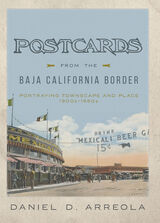 Postcards from the Baja California Border: Portraying Townscape and Place, 1900s–1950s
Daniel D. Arreola
University of Arizona Press, 2021 Postcards have a magical pull. They allow us to see the past through charming relics that allow us to travel back in time. Daniel D. Arreola’s Postcards from the Baja California Border offers a window into the historical and geographical past of storied Mexican border communities. Once-popular tourist destinations from the 1900s through the 1950s, the border communities explored in Postcards from the Baja California Border used to be filled with revelers, cabarets, curio shops, and more. The postcards in this book show the bright and dynamic past of California’s borderlands while diving deep into the historic and geographic significance of the imagery found on the postcards.
This form of place study calls attention to how we can see a past through a serial view of places, by the nature of repetition, and the photographing of the same place over and over again. Arreola draws our focus to townscapes, or built landscapes, of four border towns—Tijuana, Mexicali, Tecate, and Algodones—during the first half of the twentieth century. With an emphasis on the tourist’s view of these places, this book creates a vivid picture of what life was like for tourists and residents of these towns in the early and mid-twentieth century. Postcards from the Baja California Border is a rich and fascinating experience, one that takes you on a time-travel journey through border town histories and geographies while celebrating the visual intrigue of postcards.
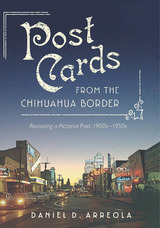 Postcards from the Chihuahua Border: Revisiting a Pictorial Past, 1900s–1950s
Daniel D. Arreola
University of Arizona Press, 2019 Just a trolley ride from El Paso, Ciudad Juárez was a popular destination in the early 1900s. Enticing and exciting, tourists descended on this and other Mexican border towns to browse curio shops, dine and dance, attend bullfights, and perhaps escape Prohibition America.
In Postcards from the Chihuahua Border Daniel D. Arreola captures the exhilaration of places in time, taking us back to Mexico’s northern border towns of Cuidad Juárez, Ojinaga, and Palomas in the early twentieth century. Drawing on more than three decades of archival work, Arreola uses postcards and maps to unveil the history of these towns along west Texas’s and New Mexico’s southern borders.
Postcards offer a special kind of visual evidence. Arreola’s collection of imagery and commentary about them shows us singular places, enriching our understandings of history and the history of change in Chihuahua. No one postcard tells the entire story. But image after image offers a collected view and insight into changing perceptions. Arreola’s geography of place looks both inward and outward. We see what tourists see, while at the same time gaining insight about what postcard photographers and postcard publishers wanted to be seen and perceived about these border communities.
Postcards from the Chihuahua Border is a colorful and dynamic visual history. It invites the reader to time travel, to revisit another era—the first half of the last century—when these border towns were framed and made popular through picture postcards.
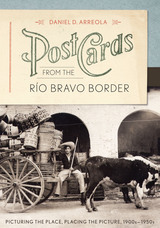 Postcards from the Río Bravo Border: Picturing the Place, Placing the Picture, 1900s–1950s
By Daniel D. Arreola
University of Texas Press, 2013 Between 1900 and the late 1950s, Mexican border towns came of age both as tourist destinations and as emerging cities. Commercial photographers produced thousands of images of their streets, plazas, historic architecture, and tourist attractions, which were reproduced as photo postcards. Daniel Arreola has amassed one of the largest collections of these border town postcards, and in this book, he uses this amazing visual archive to offer a new way of understanding how the border towns grew and transformed themselves in the first half of the twentieth century, as well as how they were pictured to attract American tourists. Postcards from the Río Bravo Border presents nearly two hundred images of five significant towns on the lower Río Bravo—Matamoros, Reynosa, Nuevo Laredo, Piedras Negras, and Villa Acuña. Using multiple images of sites within each city, Arreola tracks changes both within the cities as places and in the ways in which the cities have been pictured for tourist consumption. He makes a strong case that visual imagery has a shaping influence on how we negotiate and think about places, creating a serial scripting or narrating of the place. Arreola also shows how postcard images, when systematically and chronologically arranged, can tell us a great deal about how Mexican border towns have been viewed over time. This innovative visual approach demonstrates that historical imagery, no less than text or maps, can be assembled to tell a compelling geographical story about place and time.
 Postcards from the Road: Robert Frank’s ‘The Americans’
Jonathan Day
Intellect Books, 2014 Walker Evans said in his 1958 introduction to Robert Frank’s The Americans, “For the thousandth time, it must be said that pictures speak for themselves, wordlessly, visually, or they fail.” The images revolutionized postwar American photography. With their candid images of men and women from all classes and walks of life, the photographs presented a very different story than that portrayed by the wholesome caricature of midcentury prosperity pervading American photography at the time. Although initially dismissed by his peers for his pioneering work, Frank was ultimately credited with changing the course of the art form, and his photography holds a secure status in the history of twentieth-century art. And he did all this without words. It seems appropriate then – and not a little overdue – that Jonathan Day has created a book that expounds, explores, and examines Frank’s work pictorially.
Taking Frank’s iconic images as his point of reference, Day shot new photographs that commented on the road and contemporary America. Here, these images are paired with critical commentary that details the aspects of the work that are visually expounded and explained in Day’s complementary images. A visual entryway to the photographs and themes of this iconic book in the history of photography, Postcards from the Road represents an innovative, carefully considered departure from standard photographic textbooks.
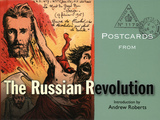 Postcards from the Russian Revolution
Edited by the Bodleian Library
Bodleian Library Publishing, 2008 The tumultuous political events that swept Russia in the early twentieth century sent powerful ripples around the world. The Bolshevik revolutionaries and activists had sympathizers among Americans and Europeans alike, and one notable way they exercised their support was through artfully created postcards. This remarkable volumepresents for the first time a newly unearthed collection of those cards that recount the 1917 Russian Revolution in a novel way.
The postcards originated not only from Russia, but also from Germany, the United States, Belgium, and France, and they reflect their diverse origins in the rich array of artistic styles employed to create them. Whether simply drawn, hand-painted, or mass-printed, the cards present compelling and complex images of the Bolshevik Revolution of 1917 and the people who were enmeshed in it. The cards serve as concise yet powerful artistic documents of Russian history and culture, as they display bloody and graphic street scenes, rare pictures of lesser-known revolutionary leaders, satirical sketches of Russian rulers, portraits of the royal family, illustrations of palaces and institutional buildings, and depictions of pivotal events leading up to the Revolution such as the 1905 assassination of Grand Duke Alexander. Also included in this fascinating visual narrative are cards depicting crucial events from the aftermath of the Revolution, including the great famine of 1921 and public celebrations of the newly formed Union of Soviet Socialist Republics.
An unprecedented and arresting exploration of the Russian Empire in its death throes, Postcards from the Russian Revolution reveals a wholly new and vibrant perspective on one of the most important political movements of the twentieth century.
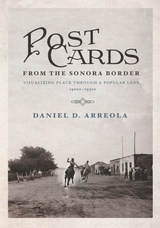 Postcards from the Sonora Border: Visualizing Place Through a Popular Lens, 1900s–1950s
Daniel D. Arreola
University of Arizona Press, 2017 Young men ride horses on a dusty main road through town. Cars and gas stations gradually intrude on the land, and, years later, curiosity shops and cantinas change the face of Mexican border towns south of Arizona. Between 1900 and the late 1950s, Mexican border towns came of age both as centers of commerce and as tourist destinations. Postcards from the Sonora Border reveals how images—in this case the iconic postcard—shape the way we experience and think about place. Making use of his personal collection of historic images, Daniel D. Arreola captures the evolution of Sonoran border towns, creating a sense of visual “time travel” for the reader. Supported by maps and visual imagery, the author shares the geographical and historical story of five unique border towns—Agua Prieta, Naco, Nogales, Sonoyta, and San Luis Río Colorado. Postcards from the Sonora Border introduces us to these important towns and provides individual stories about each, using the postcards as markers. No one postcard view tells the complete story—rather, the sense of place emerges image by image as the author pulls readers through the collection as an assembled view. Arreola reveals how often the same locations and landmarks of a town were photographed as postcard images generation after generation, giving a long and dynamic view of the inhabitants through time. Arranged chronologically, Arreola’s postcards allow us to discover the changing perceptions of place in the borderlands of Sonora, Mexico.
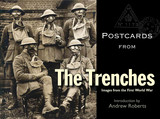 Postcards from the Trenches: Images from the First World War
Edited by the Bodleian Library
Bodleian Library Publishing, 2008 World War I has come down to us in indelible images—those of airplane bombers, bleak-eyed soldiers, stern-faced commanders, and the ruins of countless villages. But soldiers themselves also took photographs on the battlefield, and many of their striking images were transformed into postcards that were sent home to family and friends or collected as war mementos. Postcards from the Trenches gathers a number of these postcards to create a striking visual history of World War I.
The cards in this compelling volume were created not only by soldiers, but also by embedded journalists from France, Belgium, Austria, Germany, and Britain. The images capture scenes both humorous and poignant, including soldiers having a mock party with little food to eat, wounded soldiers smiling for the camera, a makeshift trench hospital, the bloody aftermath of a battle, and a huddle of men taking what they know could be their last communion before marching onto the battlefield. Other cards document the mundane duties that dominated wartime life, including men digging trenches, troops marching to new trenches and battlefields, and or soldiers nearly comatose with boredom while waiting for the fight to begin. This stunning visual narrative opens a new window into one of the most analyzed events in history, as the postcards’ images testify to the resilience and bravery of soldiers in the most trying circumstances.
A fascinating and unprecedented historical document, Postcards from the Trenches draws back the curtain to unflinchingly show the daily horror and humanity that define life in war.
 Postcards from the Underworld: Poems
Sinan Antoon
Seagull Books, 2023 A chilling poetic reflection on the world we have inherited and the destructions that made it.
To confront time, pre-modern Arabic poems often began with the poet standing before the ruins, real and imagined, of a beloved’s home. In Postcards from the Underworld, Sinan Antoon works in that tradition, observing the detritus of his home city, Baghdad, where he survived two wars—the Iran-Iraq War of 1980 and the First Gulf War of 1991—and which, after he left, he watched from afar being attacked during the US invasion in 2003. Antoon’s poems confront violence and force us not to look away as he traces death’s haunting presence in the world. Nature offers consolation, and flowers and butterflies are the poet’s interlocutors, but they too cannot escape ruin. Composed in Arabic and translated into English by the poet himself, Postcards from the Underworld is a searing meditation on the destruction of humans, habitats, and homes.
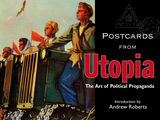 Postcards from Utopia: The Art of Political Propaganda
Edited by the Bodleian Library
Bodleian Library Publishing, 2009 Politicians are famous for making extravagant campaign promises. But there are few promises as powerful—or as idealistically utopian—as those put forth by state-sponsored propaganda. Collected here are colorful images of political ideology created and disseminated by the political regimes of Europe, the Soviet Union, and China from the 1920s through the ‘70s. State leaders of the twentieth century were highly conscious of the need to present a unified national image during a time of serious political transition in Europe, and state-sanctioned art performed a key function in an attempt to consolidate a country behind an idea. These spectacular images provide a rare opportunity to witness how abstract political ideas were rendered as visual picture for a mass audience. Fifty compelling postcards, held in the collection of the Bodleian Library, from the former Soviet Union, China, Germany, Italy, Spain, Czechoslovakia, Hungary, and Albania, reveal that despite national differences there are surprising similarities in political expression and the idealized images presented by each government. An introduction that contextualizes the images within a broader understanding of the ideologies and political powers of the time is provided by European historian, Andrew Roberts. Taken together, the images in Postcards from Utopia offer a striking look at the art of power and its mythical representation at a time of great political upheaval and experiment.
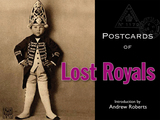 Postcards of Lost Royals
Edited by the Bodleian Library
Bodleian Library Publishing, 2009 This enchanting, unique collection of postcards recovers an old world swept away and forgotten over the decades. The lost royals captured here have not been misplaced or gone missing—what has been lost is the very foundation of their royalty. Collected here are royal figures from around the world who lost their titles and were displaced as a result of World War I and other early twentieth-century political movements. The royal houses of Europe, Africa, and Asia once ruled a continent and held dominions beyond the seas. Today, just ten monarchs still reign in Europe, and those with only limited powers. Captured in these distinctive postcards held in the collection of the Bodleian Library are these lost emperors, kings and queens, czars and czarinas, princes and princess, and grand dukes and duchesses, who were left behind by the sweep of history. Featuring monarchs from the Balkans to the Iberian Peninsula, from Ethiopia to Korea, these portraits include members of the Russian imperial family, and royals from Romania, Bulgaria, and Germany, among others. But this is more than just a picture book; it provides a narrative snapshot of world history—alongside each postcard is an intriguing mini-biography of the pictured royal that provides a gripping account of his or her story. Reminiscent of a forgotten era of glamour, grace, and regal power, Postcards of Lost Royals brings history to life and distills the essence of a long-vanished world of royalty.
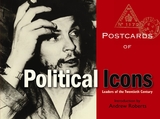 Postcards of Political Icons: Leaders of the Twentieth Century
Edited by the Bodleian Library
Bodleian Library Publishing, 2008 More than any preceding era, the twentieth century was defined by images. The widespread adoption of photography, the advent of film, and the increasing speed and ease of communications enabled people worldwide for the first time to know the faces of world leaders as intimately as those of their friends and family. The jutting jaw and jaunty cigarette holder of Franklin Delano Roosevelt, Fidel Castro’s raised fist and bearded countenance, Tony Blair’s toothy smile, and Stalin’s bristly frown—these and other iconographic images immediately conjure up unforgettable, dramatic moments in history.
Opening with the end of Queen Victoria’s reign and continuing through the end of the cold war, Postcards of Political Icons tells the story of the twentieth century through images of its most recognizable leaders. The politicians who presided over the demise of colonialism, led the communist revolution, and fought two world wars are presented on these postcards in unusual–and often surprisingly personal—moments. Nelson Mandela is captured in a moment of privacy, looking dreamily into the distance; Yasser Arafat wrestles with chopsticks; while Benito Mussolini, known for his public performances, masters a new curious posture.
Reproducing many rare and little-seen images, Postcards of Political Icons offers a fascinating glimpse at the iconography of political power—and the reality of the people behind it.
Post-cinema: Cinema in the Post-art Era
José Moure
Amsterdam University Press, 2020 Post-cinema designates a new way of making films. It is time to ask whether this novelty is complete or relative and to evaluate to what extent it represents a unitary or diversified current. The book proposes to integrate the post-cinema question within the post-art question in order to study the new ways of making filmic images. The issue will be considered at three levels: the impression of post-art on "regular" films; the "relocation" (Casetti) of the same films that can be seen using devices of all kinds in conditions more or less removed from the dispositif of the theater; the integration of cinema into contemporary art in all kinds of forms of creation and exhibition, parallel to the integration of contemporary art in "regular" cinema.
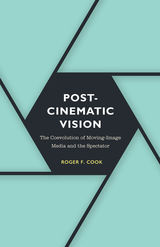 Postcinematic Vision: The Coevolution of Moving-Image Media and the Spectator
Roger F. Cook
University of Minnesota Press, 2020 A study of how film has continually intervened in our sense of perception, with far-ranging insights into the current state of lived experience
How has cinema transformed our senses, and how does it continue to do so? Positing film as a stage in the long coevolution of human consciousness and visual technology, Postcinematic Vision offer a fresh perspective on the history of film while providing startling new insights into the so-called divide between cinematic and digital media. Starting with the argument that film viewing has long altered neural circuitry in our brains, Roger F. Cook proceeds to reevaluate film’s origins, as well as its merger with digital imaging in the 1990s. His animating argument is that film has continually altered the relation between media and human perception, challenging the visual nature of modern culture in favor of a more unified, pan-sensual way of perceiving. Through this approach, he makes original contributions to our understanding of how mediation is altering lived experience. Along the way, Cook provides important reevaluations of well-known figures such as Franz Kafka, closely reading cinematic passages in the great author’s work; he reassesses the conventional wisdom that Marshall McLuhan was a technological determinist; and he lodges an original new reading of The Matrix. Full of provocative and far-reaching ideas, Postcinematic Vision is a powerful work that helps us see old concepts anew while providing new ideas for future investigation.
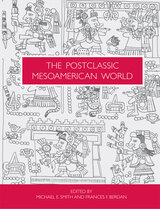 The Postclassic Mesoamerican World
Michael E Smith
University of Utah Press, 2003 Edited by Michael E. Smith and Frances F. Berdan Anthropology and Archaeology The past two decades have seen an explosion of research on Postclassic Mesoamerican societies. In this ambitious new volume, the editors and contributors seek to present a complete picture of the middle and late Postclassic period (ca. AD 1100-1500) employing a new theoretical framework.
Mesoamerican societies after the collapse of the great city-states of Tula and Chichen Itza stand out from earlier societies in a number of ways. They had larger regional populations, smaller polities, a higher volume of long-distance trade, greater diversity of trade goods, a more commercialized economy, and new standardized forms of pictorial writing and iconography. The emerging archaeological record reveals larger quantities of imported goods in Postclassic contexts, and ethnohistoric accounts describe marketplaces, professional merchants, and the use of money throughout Mesoamerica by the time of the Spanish conquest. The integration of this commercial economy with new forms of visual communication produced a dynamic world system that reached every corner of Mesoamerica.
Thirty-six focused articles by twelve authors describe and analyze the complexity of Postclassic Mesoamerica. After an initial theoretical section, chapters are organized by key themes: polities, economic networks, information networks, case studies, and comparisons. Covering a region from western Mexico to Yucatan and the southwestern Maya highlands, this volume should be in the library of anyone with a serious interest in ancient Mexico.
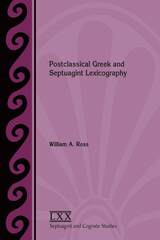 Postclassical Greek and Septuagint Lexicography
William A. Ross
SBL Press, 2022 A long-standing tradition within biblical scholarship sets the Greek text of the Septuagint constantly in relationship with its supposed Hebrew or Aramaic Vorlage, examining the two together in terms of their grammatical alignment as a standard. Yet another tradition frames the discussion in different terms, preferring instead to address the Septuagint first of all in light of its contemporary Greek linguistic environment and only then attempting to describe its language and style as a text. It is this latter approach that William A. Ross employs in this textually based study of the Greek versions of Judges, a so-called double text in the textual history of the Septuagint. The results of his study offer a window into the Old Greek translation and its later revision, two distinct stages of Greek Judges with numerous instances of divergent vocabulary choices that reflect deliberateness in both the original selection and the subsequent change within the textual development of the book. Ross’s study illustrates the practicalities and payoff of a Greek-oriented lexicographical method that situates the language of the Septuagint squarely within its contemporary historical and linguistic context.
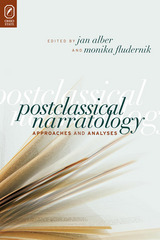 Postclassical Narratology: Approaches and Analyses
Jan Alber
Ohio State University Press, 2010 In this volume, an international group of contributors presents new perspectives on narrative. Using David Herman’s 1999 definition of "postclassical narratology" from Narratologies: New Perspectives on Narrative Analysis (OSUP) as their launching point, these eleven essayists explore the various ways in which new approaches overlap and interrelate to form new ways of understanding narrative texts. Postclassical narratology has reached a new phase of consolidation but also continued diversification. This collection therefore discriminates between what one could call a critical but frame-abiding and a more radical frame-transcending or frame-shattering handling of the structuralist paradigm. Postclassical Narratology: Approaches and Analyses discusses a large variety of different aspects of narrative, such as extensions of classical narratology, new generic applications (autobiography, oral narratives, poetry, painting, and film), the history of narratology, the issue of fictionality, the role of cognition, and questions of authorship and authority, as well as thematic matters related to ethics, gender, and queering. Additionally, it uses a wide spectrum of critical approaches, including feminism, psychoanalysis, media studies, the rhetorical theory of narrative, unnatural narratology, and cognitive studies. In this manner the essays manage to produce new insights into many key issues in narratology. The contributors also demonstrate that narratologists nowadays see the object of their research as more variegated than was the case twenty years ago: they resort to a number of different methods in combination when approaching a problem, and they tend to ground their analyses in a rich contextual framework.
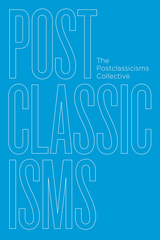 Postclassicisms
The Postclassicisms Collective
University of Chicago Press, 2020 Made up of nine prominent scholars, The Postclassicisms Collective aims to map a space for theorizing and reflecting on the values attributed to antiquity. The product of these reflections, Postclassicisms takes up a set of questions about what it means to know and care about Greco-Roman antiquity in our turbulent world and offers suggestions for a discipline in transformation, as new communities are being built around the study of the ancient Greco-Roman world.
Structured around three primary concepts—value, time, and responsibility—and nine additional concepts, Postclassicisms asks scholars to reflect upon why they choose to work in classics, to examine how proximity to and distance from antiquity has been—and continues to be—figured, and to consider what they seek to accomplish within their own scholarly practices. Together, the authors argue that a stronger critical self-awareness, an enhanced sense of the intellectual history of the methods of classics, and a greater understanding of the ethical and political implications of the decisions that the discipline makes will lead to a more engaged intellectual life, both for classicists and, ultimately, for society. A timely intervention into the present and future of the discipline, Postclassicisms will be required reading for professional classicists and students alike and a model for collaborative disciplinary intervention by scholars in other fields.
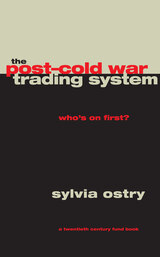 The Post-Cold War Trading System: Who's on First?
Sylvia Ostry
University of Chicago Press, 1997 With the end of the Cold War, the search for a new international and economic order has begun. In this comprehensive account, Sylvia Ostry provides a critical analysis of an international trade system in the throes of rapid and far-reaching change.
With keen historical awareness, Ostry examines the role of key economic power brokers, particularly the United States, in the reconstruction and reconfiguration of an international economy after World War II. She argues that U.S. policy efforts were so successful that they led to an unprecedented renewal of economic growth, living standards, and education levels in postwar Europe and Japan. Ironically, those same policy successes unintentionally fostered the relative decline of U.S. dominance on the world trade scene as the reduction of trade and investment barriers prompted friction and conflict between different kinds of capitalist systems.
Identifying the historical and legal issues key to postwar trade policy, Ostry has commandingly charted our economic course through the last half of this century and, perhaps, into the next.
"Sylvia Ostry knows this subject as few others do, both as a scholar of international trade issues and a major player in the ongoing negotiations that have created the rules of the trade game. The Post-Cold War Trading System is a fine summary of where we've been and where we ought to be going."—Peter Passell, economic scene columnist for The New York Times
 Postcolonial America
Edited by C. Richard King
University of Illinois Press, 2000 Scholars from a wide array of disciplines describe and debate postcolonialism as it applies to America in this authoritative and timely collection. Investigating topics such as law and public policy, immigration and tourism, narratives and discourses, race relations, and virtual communities, Postcolonial America clarifies and challenges prevailing conceptualizations of postcolonialism and accepted understandings of American culture.
Advancing multiple, even conflicted visions of postcolonial America, this important volume interrogates postcolonial theory and traces the emergence and significance of postcolonial practices and precepts in the United States. Contributors discuss how the unique status of the United States as the colony that became a superpower has shaped its sense of itself. They assess the global networks of inequality that have displaced neocolonial systems of conquest, exploitation, and occupation. They also examine how individuals and groups use music, the Internet, and other media to reconfigure, reinvent, and resist postcoloniality in American culture.
Candidly facing the inherent contradictions of "the American experience," this collection demonstrates the patterns, connections, and histories characteristic of postcoloniality in America and initiates important discussions about how these conditions might be changed.
 The Postcolonial and the Global
Revathi Krishnaswamy
University of Minnesota Press, 2007 This interdisciplinary work brings the humanities and social sciences into dialogue by examining issues such as globalized capital, discourses of antiterrorism, and identity politics. Essayists from the fields of postcolonial studies and globalization theory address the ethical and pragmatic ramifications of opposing interpretations of these issues and, for the first time, seek common ground. Contributors: Pal Ahluwalia, U of California, San Diego; Arjun Appadurai, New School U; Geoffrey Bowker, Santa Clara U; Timothy Brennan, U of Minnesota; Ruth Buchanan, U of British Columbia; Verity Burgmann, U of Melbourne; Pheng Cheah, U of California, Berkeley; Inderpal Grewal, U of California, Irvine; Ramon Grosfoguel, U of California, Berkeley; Barbara Harlow, U of Texas, Austin; Anouar Majid, U of New England; John McMurtry, U of Guelph; Walter D. Mignolo, Duke U; Sundhya Pahuja, U of Melbourne; R. Radhakrishnan, U of California, Irvine; Ileana Rodriguez, Ohio State U; E. San Juan, Philippine Forum, New York; Saskia Sassen, U of Chicago; Ella Shohat, New York U; Leslie Sklair, London School of Economics; Robert Stam, New York U; Madina Tlostanova, Russian Peoples’ Friendship U; Harish Trivedi, U of Delhi. Revathi Krishnaswamy is associate professor of English at San Jose State University. John C. Hawley is professor and chair of English at Santa Clara University.
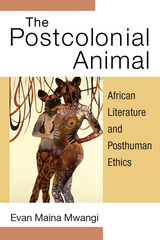 The Postcolonial Animal: African Literature and Posthuman Ethics
Evan Maina Mwangi
University of Michigan Press, 2019 Despite the central role that animals play in African writing and daily life, African literature and African thinkers remain conspicuously absent from the field of animal studies. The Postcolonial Animal: African Literature and Posthuman Ethics demonstrates the importance of African writing to animal studies by analyzing how postcolonial African writing—including folktales, religion, philosophy, and anticolonial movements—has been mobilized to call for humane treatment of nonhuman others. Mwangi illustrates how African authors grapple with the possibility of an alternative to eating meat, and how they present postcolonial animal-consuming cultures as shifting toward an embrace of cultural and political practices that avoid the use of animals and minimize animal suffering. The Postcolonial Animal analyzes texts that imagine a world where animals are not abused or used as a source of food, clothing, or labor, and that offer instruction in how we might act responsibly and how we should relate to others—both human and nonhuman—in order to ensure a world free of oppression. The result is an equitable world where even those who are utterly foreign to us are accorded respect and where we recognize the rights of all marginalized groups.
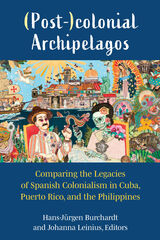 (Post-)colonial Archipelagos: Comparing the Legacies of Spanish Colonialism in Cuba, Puerto Rico, and the Philippines
Hans-Jürgen Burchardt and Johanna Leinius, Editors
University of Michigan Press, 2022 The Puerto Rican debt crisis, the challenges of social, political, and economic transition in Cuba, and the populist politics of Duterte in the Philippines—these topics are typically seen as disparate experiences of social reality. Though these island territories were colonized by the same two colonial powers—by the Spanish Empire and, after 1898, by the United States—research in the fields of history and the social sciences rarely draws links between these three contexts. Located at the intersection of Postcolonial Studies, Latin American Studies, Caribbean Studies, and History, this interdisciplinary volume brings together scholars from the US, Europe, Latin America, the Caribbean, and the Philippines to examine the colonial legacies of the three island nations of Cuba, Puerto Rico, and the Philippines. Instead of focusing on the legacies of US colonialism, the continuing legacies of Spanish colonialism are put center-stage. The analyses offered in the volume yield new and surprising insights into the study of colonial and postcolonial constellations that are of interest not only for experts, but also for readers interested in the social, political, economic, and cultural dynamics of Cuba, Puerto Rico, and the Philippines during Spanish colonization and in the present. The empirical material profits from a rigorous and systematic analytical framework and is thus easily accessible for students, researchers, and the interested public alike.
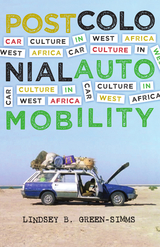 Postcolonial Automobility: Car Culture in West Africa
Lindsey B. Green-Simms
University of Minnesota Press, 2015 For more than a century cars have symbolized autonomous, unfettered mobility and an increasingly global experience. And yet, they are often used differently outside the centers of global capitalism. This pioneering book considers how, through the lens of the automobile, we can assess the pleasures, dangers, and limits of global modernity in West Africa. Through new and provocative readings of famous plays, novels, and films, as well as recent popular videos, Postcolonial Automobility reveals the surprising ways in which automobility in the region is, at once, an everyday practice, an ethos, a fantasy of autonomy, and an affective activity intimately tied to modern social life. Lindsey B. Green-Simms begins with the history of motorization in West Africa from the colonial era to the decolonizing decades after World War II, and addresses the tragedy of car accidents through a close reading of Wole Soyinka’s 1965 postindependence play The Road. Shifting to screen media, she discusses Ousmane Sembene’s Xala and Jean-Pierre Bekolo’s Quartier Mozart and reviews popular, low-budget Nollywood films. Finally, Green-Simms considers how feminist texts rewrite and work in dialogue with the male-centered films and novels where the car stands in for patriarchal power and capitalist achievement. Providing a unique perspective on technology in Africa—one refusing to be confined to narratives of either underdevelopment or inevitable progress—and covering a broad range of interdisciplinary material, Postcolonial Automobility will appeal not only to scholars and students of African literature and cinema but also to those in postcolonial and globalization studies.
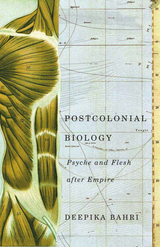 Postcolonial Biology: Psyche and Flesh after Empire
Deepika Bahri
University of Minnesota Press, 2017 Although the body has been a vast subject for postcolonial studies, few theorists have attempted to go beyond the simple mixing of races in examining the impact of colonialism on the colonized body. However, as Deepika Bahri argues, it is essential to see the postcolonial body in a variety of forms: as capable of transformation not only in psyche and outward behavior but also in flesh and blood. European colonizers brought new ways of seeing the body in matters as basic as how to eat, speak, sit, shit, or spit. As nations decolonized, these imperialistic ideas remained, becoming part of the global economy of the body. In Postcolonial Biology, Bahri argues that the political challenges of the twenty-first century require that we deconstruct these imperial notions of the body, as they are fundamental to power structures governing today’s globalized world. Postcolonial Biology investigates how minds and bodies have been shaped by colonial contact, to create deeply embedded hierarchies among the colonized. Moving beyond “North/South” thinking, Bahri reframes the questions of postcolonial bodies to address all societies, whether developed or developing. Engaging in innovative, highly original readings of major thinkers such as Adorno, Horkheimer, Derrida, and Fanon, this book brings an important new focus to the field of postcolonial studies—one that is essential to understanding the ideas and conflicts that currently dominate the global order.
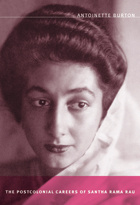 The Postcolonial Careers of Santha Rama Rau
Antoinette Burton
Duke University Press, 2007 Santha Rama Rau was one of the best known South Asian writers in postwar America. Born into India’s elite in 1923, Rama Rau has lived in the United States since the 1940s. Although she is no longer well known, she was for several decades a popular expert on India. She provided an insider’s view of Indian cultures, traditions, and history to an American public increasingly aware of the expanded role of the United States on the world stage. Between 1945 and 1970, Rama Rau published half a dozen books, including travelogues, novels, a memoir, and a Time-Life cookbook; she was a regular contributor to periodicals such as the New Yorker, the New York Times, McCall’s, and Reader’s Digest. Drawing on archival research and interviews with Rama Rau, historian Antoinette Burton opens Rama Rau’s career into an examination of orientalism in the postwar United States, the changing idioms of cosmopolitanism in the postcolonial era, and the afterlife of British colonialism in the American public sphere. Burton describes how Rama Rau’s career was shaped by gendered perceptions of India and “the East” as well as by the shifting relationships between the United States, India, Pakistan, and Great Britain during the Cold War. Exploring how Rama Rau positioned herself as an expert on both India and the British empire, Burton analyzes the correspondence between Rama Rau and her Time-Life editors over the contents of her book The Cooking of India (1969), and Rama Rau’s theatrical adaptation of E. M. Forster’s A Passage to India, which played on Broadway in 1961 and was the basis for David Lean’s 1985 film. Burton assesses the critical reception of Rama Rau’s play as well as her correspondence with Forster and Lean.
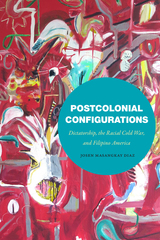 Postcolonial Configurations: Dictatorship, the Racial Cold War, and Filipino America
Josen Masangkay Diaz
Duke University Press, 2023 In Postcolonial Configurations Josen Masangkay Diaz examines the making of Filipino America through the dynamics of dictatorship, coloniality, and subjectivity. Diaz explores how the Ferdinand Marcos dictatorship and US policies during the Cold War that supported the regime defined the relationship between “Filipino” and “America” in ways that influenced the creation of a gendered and racialized Filipino American subject. By analyzing Philippine-US state programs for military operations, labor and immigration reform, and development and modernization plans, she shows how anticommunist liberalism and authoritarianism shaped the visibility and recognition of new forms of Filipino subjectivity. Tracing the rise of various social formations that emerged under the Marcos regime and US programs for liberal reform, from transnational Filipino and US culture and the immigrant returnee to the New Filipina woman and the humanitarian English teacher, Diaz positions literature, film, periodicals, and other cultural texts against official state records in ways that reconceptualize the meanings of Filipino America in the Cold War.
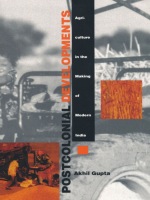 Postcolonial Developments: Agriculture in the Making of Modern India
Akhil Gupta
Duke University Press, 1998 This definitive study brings together recent critiques of development and work in postcolonial studies to explore what the postcolonial condition has meant to rural people in the Third World. Focusing on local-level agricultural practices in India since the “green revolution” of the 1960s, Akhil Gupta challenges the dichotomy of “developed” and “underdeveloped,” as well as the notion of a monolithic postcolonial condition. In so doing, he advances discussions of modernity in the Third World and offers a new model for future ethnographic scholarship.
Based on fieldwork done in the village of Alipur in rural north India from the early 1980s through the 1990s, Postcolonial Developments examines development itself as a post–World War II sociopolitical ideological formation, critiques related policies, and explores the various uses of the concept of the “indigenous” in several discursive contexts. Gupta begins with an analysis of the connections and conflicts between the world food economy, transnational capital, and technological innovations in wheat production. He then examines narratives of village politics in Alipur to show how certain discourses influenced governmental policies on the green revolution. Drawing links between village life, national trends, and global forces, Gupta concludes with a discussion of the implications of environmentalism as exemplified by the Rio Earth Summit and an examination of how global environmental treaties may detrimentally affect the lives of subaltern peoples.
With a series of subtle observations on rural politics, nationalism, gender, modernization, and difference, this innovative study capitalizes on many different disciplines: anthropology, sociology, comparative politics, cultural geography, ecology, political science, agricultural economics, and history.
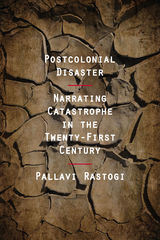 Postcolonial Disaster: Narrating Catastrophe in the Twenty-First Century
Pallavi Rastogi
Northwestern University Press, 2020 Postcolonial Disaster studies literary fiction about crises of epic proportions in contemporary South Asia and Southern Africa: the oceanic disaster in Sri Lanka, the economic disaster in Zimbabwe, the medical disaster in South Africa and Botswana, and the geopolitical disaster in India and Pakistan. Pallavi Rastogi argues that postcolonial fiction about catastrophe is underpinned by a Disaster Unconscious, a buried but mobile agenda that forces disastrous events to narrate themselves. She writes that in disaster fiction, a literary Story and its real-life Event are in constant dialectic tension. In recent disasters, Story and Event are tied together as the urgency to circulate information and rebuild in the aftermath of the disaster dictates the flow of the narrative. As the Story acquires temporal distance from the Event, such as the seventy-three years since the partition of India in 1947, it plays more with form and theme, to expand beyond a tale about an all-consuming tragedy. Story and Event are in a constant dance with each other, and the Disaster Unconscious plays the tune to which they move.
Rastogi creates a narratology for postcolonial disaster fiction and brings concepts from Disaster Studies into the realm of literary analysis.
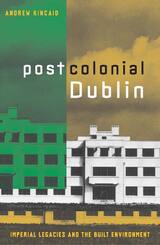 Postcolonial Dublin: Imperial Legacies And The Built Environment
Andrew Kincaid
University of Minnesota Press, 2006 For hundreds of years, Ireland has been a testing ground for colonizing techniques. Postcolonial Dublin shows how perpetrators of colonialism have made use of urban planning and architecture to underscore and legitimate ideologies. From suburban development to building facades, the conflict between nationalists and colonialists has inscribed itself on Dublin’s landscape. Andrew Kincaid illustrates how the architecture and urban planning of Dublin have been integral to debates about nationalism, modernism, and Ireland’s relationship to the rest of the world. Looking at objects such as Londonderry’s Market House, Patrick Abercrombie’s Dublin of the Future, and the urban renewal project of today’s Temple Bar, Kincaid highlights Ireland’s colonial history and the significance of architecture in the evolution of national identity. In doing so, he demonstrates how ideology “spatializes” itself. Postcolonial Dublin engages the prevailing historical representations of Irish nationalism, arguing that the evolving city reflected a debate over who would hold the reins of power. Bringing the tools of literary criticism and postcolonial theory to bear on the field of urban studies, Kincaid places Dublin at the forefront of debates over modernism, modernity, and globalization.Andrew Kincaid is assistant professor of English at the University of Wisconsin, Milwaukee.
Postcolonial France: The Question of Race and the Future of the Republic
Paul Silverstein
Pluto Press, 2018 France has in recent years emerged as a bellwether for worldwide anxieties around postcolonialism and multiculturalism, and the rise of right-wing populism. This book offers a detailed exploration of the dynamics and dilemmas of the present moment of crisis and hope in France through an exploration of a number of recent moral panics. Paul Silverstein here examines urban racial violence, female Islamic dress and male public prayer, anti-system gangster rap, and sports—all of which have triggered major national debates over France’s multicultural future. Silverstein shows convincingly that these conflicts can be traced back to unresolved tensions around France's imperial project, the present-day effects of which are still being felt.
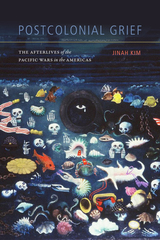 Postcolonial Grief: The Afterlives of the Pacific Wars in the Americas
Jinah Kim
Duke University Press, 2019 In Postcolonial Grief Jinah Kim explores the relationship of mourning to transpacific subjectivities, aesthetics, and decolonial politics since World War II. Kim argues that Asian diasporic subjectivity exists in relation to afterlives because the deaths of those killed by U.S. imperialism and militarism in the Pacific remain unresolved and unaddressed. Kim shows how primarily U.S.-based Korean and Japanese diasporic writers, artists, and filmmakers negotiate the necropolitics of Asia and how their creative refusal to heal from imperial violence may generate transformative antiracist and decolonial politics. She contests prevalent interpretations of melancholia by engaging with Frantz Fanon's and Hisaye Yamamoto's decolonial writings; uncovering the noir genre's relationship to the U.S. war in Korea; discussing the emergence of silenced colonial histories during the 1992 Los Angeles riots; and analyzing the 1996 hostage takeover of the Japanese ambassador's home in Peru. Kim highlights how the aesthetic and creative work of the Japanese and Korean diasporas offers new insights into twenty-first-century concerns surrounding the state's erasure of military violence and colonialism and the difficult work of remembering histories of war across the transpacific.
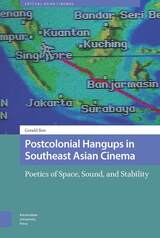 Postcolonial Hangups in Southeast Asian Cinema: Poetics of Space, Sound, and Stability
Gerald Sim
Amsterdam University Press, 2020 Postcolonial Hangups in Southeast Asian Cinema: Poetics of Space, Sound, and Stability rethinks theory and style through films that bring the limits of traditional postcolonial frameworks into stark relief. Discover Singapore’s preoccupations with space, Yasmin Ahmad’s Malaysian soundscapes, and Indonesia’s investment in genre. These undertheorized films from geopolitically situated cultures narrate colonial identity within a distinctively Southeast Asian story. Gerald Sim’s immersive journey nurtures connections between narrative film, commercial video, art cinema, and experimental work with an abiding commitment to self-reflexive theorizing. The book culminates in a reflection on the ethics and politics of conducting knowledge work on world cinema. Sim navigates Singapore’s love of maps with the work of Tom Conley and Gilles Deleuze, surveys the city-state’s cartographic uncanny, before using the spatial inquisitions in filmmaker Tan Pin Pin’s “cinema of hiraeth” to appreciate Singapore’s territorial predispositions. The book then revisits a beloved Malaysian director's voice of modernity alongside Jean-Luc Nancy’s phenomenologies of listening and globalization. Original readings of Ahmad’s oeuvre dwell on the interplay between her ethnic cacophonies and imperfect subtitling. Finally, Sim focuses on the postcoloniality of Indonesia’s Cold War alliance with the United States to contemplate the overhang of authoritarian stability within its contemporary cinema’s generic recourse.
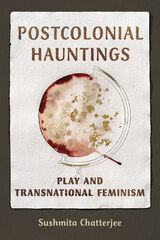 Postcolonial Hauntings: Play and Transnational Feminism
Sushmita Chatterjee
University of Illinois Press, 2024 Often examined separately, play and hauntings in fact act together to frame postcolonial issues. Sushmita Chatterjee showcases their braided workings in social and political fabrics. Drawing on this intertwined idea of play and hauntings, Chatterjee goes to the heart of conundrums within transnational postcolonial feminisms by examining the impossible echoes of translations, differing renditions of queer, and the possibilities of solidarity beyond the fraternal friendships that cement nation-states. Meaning-plays, or slippages through language systems as we move from one language to another, play a pivotal role in a global world. As Chatterjee shows, an attentiveness to meaning-plays discerns the past and present, here and there, and moves us toward responsive ethics in our theories and activisms. Insightful and stimulating, Postcolonial Hauntings centers the inextricable work of play and hauntings as a braided ethics for postcolonial transnational struggles.
Post-colonial Immigrants and Identity Formations in the Netherlands
Edited by Ulbe Bosma
Amsterdam University Press, 2012
In this book Ulbe Bosma explores the experience of immigrants in the Netherlands over sixty years and three generations. Looking at migrants from all countries, Bosma teases out how their ethnic identities are informed by Dutch culture, and how these immigrant identities evolve over time.
“Fascinating, comprehensive, and historically grounded, this essential volume reveals how the colonial past continues to shape multicultural Dutch society. . . . It is an important counterpart to work on France, Britain, and Portugal.”—Andrea Smith, Lafayette College
 Postcolonial Imperialism: Critique of the Society of Dazzlements
Joseph Tonda. Translated by Cheryl Smeall
Duke University Press, 2026 Postcolonial Imperialism considers the inability to distinguish between reality and fiction as a key condition of contemporary life. If postcolonial theory has highlighted how white colonizers created images of racialized Others which project their own self-hatred or disavowal, Joseph Tonda here shows how these images have in turn colonized Western imaginaries. He argues that the Global North’s obsession with its own phantoms takes a newly powerful form in the dazzling images of postcolonial screens. With examples ranging from Nicki Minaj to Osama Bin Laden and child soldier Johnny Mad Dog, Tonda reflects on power by analyzing the dazzlements of both Central Africa and the West, showing how African life prefigures Western experiences. Translated from its original French, Postcolonial Imperialism is a prescient critique of authoritarian attempts to enforce alternate realities, and of the many ways screens can distort our vision.
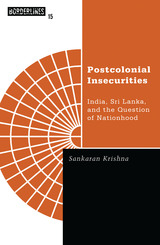 Postcolonial Insecurities: India, Sri Lanka, and the Question of Nationhood
Sankaran Krishna
University of Minnesota Press, 1999 An exploration of the connections between ethnicity and nation-building. This ambitious work explores the vexed connections among nation-building, ethnic identity, and regional conflict by focusing on a specific event: Indian political and military intervention in the ethnic conflict between the Sinhalese and Tamils in Sri Lanka. Drawing on interviews with leading players in the Indian–Sri Lankan debacle, Sankaran Krishna offers a persuasive analysis of this episode. The intervention serves as a springboard to a broader inquiry into the interworkings of nation building, ethnicity, and “foreign” policy. Krishna argues that the modernist effort to construct nation-states on the basis of singular notions of sovereignty and identity has reached a violent dead end in the postcolonial world of South Asia. Showing how the nationalist agenda that seeks to align territory with identity has unleashed a spiral of regional, statist, and insurgent violence, he makes an eloquent case for reimagining South Asia along postnational lines—as a “confederal” space. Postcolonial Insecurities counters the perception of “ethnicity” as an inferior and subversive principle compared with the progressive ideal of the “nation.” Krishna, in fact, shows ethnicity to be indispensable to the production and reproduction of the nation itself.
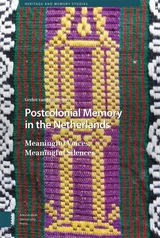 Postcolonial Memory in the Netherlands: Meaningful Voices, Meaningful Silences
Gerlov van Engelenhoven
Amsterdam University Press, 2023 This book is about postcolonial memory in the Netherlands. This term refers to conflicts in contemporary society about how the colonial past should be remembered. The question is often: who has the right or ability to tell their stories and who do not? In other words: who has a voice, and who is silenced? As such, these conflicts represent a wider tendency in cultural theory and activism to use voice as a metaphor for empowerment and silence as voice’s negative counterpart, signifying powerlessness. And yet, there are voices that do not liberate us from, but rather subject us to power. Meanwhile, silence can be powerful: it can protect, disrupt and reconfigure. Throughout this book, it will become clear how voice and silence function not as each other’s opposites, but as each other’s continuation, and that postcolonial memory is articulated through the interplay of meaningful voices and meaningful silences.
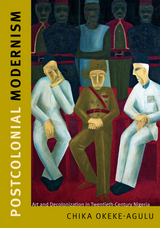 Postcolonial Modernism: Art and Decolonization in Twentieth-Century Nigeria
Chika Okeke-Agulu
Duke University Press, 2015 Written by one of the foremost scholars of African art and featuring 129 color images, Postcolonial Modernism chronicles the emergence of artistic modernism in Nigeria in the heady years surrounding political independence in 1960, before the outbreak of civil war in 1967. Chika Okeke-Agulu traces the artistic, intellectual, and critical networks in several Nigerian cities. Zaria is particularly important, because it was there, at the Nigerian College of Arts, Science and Technology, that a group of students formed the Art Society and inaugurated postcolonial modernism in Nigeria. As Okeke-Agulu explains, their works show both a deep connection with local artistic traditions and the stylistic sophistication that we have come to associate with twentieth-century modernist practices. He explores how these young Nigerian artists were inspired by the rhetoric and ideologies of decolonization and nationalism in the early- and mid-twentieth century and, later, by advocates of negritude and pan-Africanism. They translated the experiences of decolonization into a distinctive "postcolonial modernism" that has continued to inform the work of major Nigerian artists.
Postcolonial Netherlands: Sixty-Five Years of Forgetting, Commemorating, Silencing
Gert Oostindie
Amsterdam University Press, 2012
The Netherlands is home to one million citizens with roots in former Dutch colonies, such as Indonesia, Suriname, and the Antilles. Due to this influx of non-Western immigrants, a nationwide debate over multiculturalism has been waged over the past decade. Postcolonial Netherlands addresses themes of multicultural integration, such as state-sponsored financial gestures towards first-generation immigrants, and their subsequent results. Taking on a controversial thesis, Gert Oostindie claims that children of immigrants feel diminishing ties to their international origins and that for newer Dutch generations, multiculturalism has less and less importance.
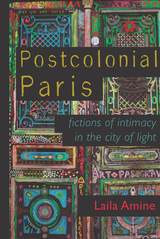 Postcolonial Paris: Fictions of Intimacy in the City of Light
Laila Amine
University of Wisconsin Press, 2021 In the global imagination, Paris is the city's glamorous center, ignoring the Muslim residents in its outskirts except in moments of spectacular crisis such as terrorist attacks or riots. But colonial immigrants and their French offspring have been a significant presence in the Parisian landscape since the 1940s. Expanding the narrow script of what and who is Paris, Laila Amine explores the novels, films, and street art of Maghrebis, Franco-Arabs, and African Americans in the City of Light, including fiction by Charef, Chraïbi, Sebbar, Baldwin, Smith, and Wright, and such films as La haine, Made in France, Chouchou, and A Son.
Spanning the decades from the post–World War II era to the present day, Amine demonstrates that the postcolonial other is both peripheral to and intimately entangled with all the ideals so famously evoked by the French capital—romance, modernity, equality, and liberty. In their work, postcolonial writers and artists have juxtaposed these ideals with colonial tropes of intimacy (the interracial couple, the harem, the Arab queer) to expose their hidden violence. Amine highlights the intrusion of race in everyday life in a nation where, officially, it does not exist.
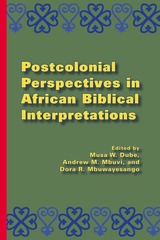 Postcolonial Perspectives in African Biblical Interpretations
Musa W. Dube
SBL Press, 2012 This volume foregrounds biblical interpretation within the African history of colonial contact, from North Atlantic slavery to the current era of globalization. It reads of the prolonged struggle for justice and of hybrid identities from multifaceted contexts, where the Bible co-exists with African Indigenous Religions, Islam, and other religions. Showcasing the dynamic and creative approaches of an emerging and thriving community of biblical scholarship from the African continent and African diaspora, the volume critically examines the interaction of biblical texts with African people and their cultures within a postcolonial framework. While employing feminist/womanist, postcolonial, Afrocentric, social engagement, creative writing, reconstruction, and HIV/AIDS perspectives, the authors all engage with empire in their own ways: in specific times, forms, and geography. This volume is an important addition to postcolonial and empires studies in biblical scholarship. The contributors are David Tuesday Adamo, Lynn Darden, H. J. M. (Hans) van Deventer, Musa W. Dube, John D. K. Ekem, Ernest M. Ezeogu, Elelwani B. Farisani, Sylvester A. Johnson, Emmanuel Katongole, Malebogo Kgalemang, Temba L. J. Mafico, Madipoane Masenya (ngwan’a Mphahlele), Andrew M. Mbuvi, Sarojini Nadar, Elivered Nasambu-Mulongo, Jeremy Punt, Gerrie Snyman, Lovemore Togarasei, Sam Tshehla, Robert Wafawanaka, Robert Wafula, Gerald West, Alice Y. Yafeh-Deigh, and Gosnell L. Yorke.
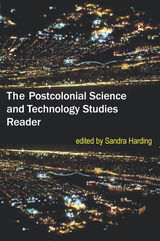 The Postcolonial Science and Technology Studies Reader
Sandra Harding, ed.
Duke University Press, 2011 For twenty years, the renowned philosopher of science Sandra Harding has argued that science and technology studies, postcolonial studies, and feminist critique must inform one another. In The Postcolonial Science and Technology Studies Reader, Harding puts those fields in critical conversation, assembling the anthology that she has long wanted for classroom use. In classic and recent essays, international scholars from a range of disciplines think through a broad array of science and technology philosophies and practices. The contributors reevaluate conventional accounts of the West’s scientific and technological projects in the past and present, rethink the strengths and limitations of non-Western societies’ knowledge traditions, and assess the legacies of colonialism and imperialism. The collection concludes with forward-looking essays, which explore strategies for cultivating new visions of a multicultural, democratic world of sciences and for turning those visions into realities. Feminist science and technology concerns run throughout the reader and are the focus of several essays. Harding provides helpful background for each essay in her introductions to the reader’s four sections. Contributors
Helen Appleton
Karen Bäckstrand
Lucille H. Brockway
Stephen B. Brush
Judith Carney
Committee on Women, Population, and the Environment
Arturo Escobar
Maria E. Fernandez
Ward H. Goodenough
Susantha Goonatilake
Sandra Harding
Steven J. Harris
Betsy Hartmann
Cori Hayden
Catherine L. M. Hill
John M. Hobson
Peter Mühlhäusler
Catherine A. Odora Hoppers
Consuelo Quiroz
Jenny Reardon
Ella Reitsma
Ziauddin Sardar
Daniel Sarewitz
Londa Schiebinger
Catherine V. Scott
Colin Scott
Mary Terrall
D. Michael Warren
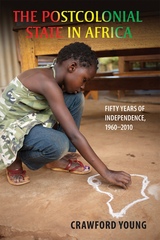 The Postcolonial State in Africa: Fifty Years of Independence, 1960–2010
Crawford Young
University of Wisconsin Press, 2012 In The Postcolonial State in Africa, Crawford Young offers an informed and authoritative comparative overview of fifty years of African independence, drawing on his decades of research and first-hand experience on the African continent.
Young identifies three cycles of hope and disappointment common to many of the African states (including those in North Africa) over the last half-century: initial euphoria at independence in the 1960s followed by disillusionment with a lapse into single-party autocracies and military rule; a period of renewed confidence, radicalization, and ambitious state expansion in the 1970s preceding state crisis and even failure in the disastrous 1980s; and a phase of reborn optimism during the continental wave of democratization beginning around 1990. He explores in depth the many African civil wars—especially those since 1990—and three key tracks of identity: Africanism, territorial nationalism, and ethnicity.
Only more recently, Young argues, have the paths of the fifty-three African states begun to diverge more dramatically, with some leading to liberalization and others to political, social, and economic collapse—outcomes impossible to predict at the outset of independence.
“This book is the best volume to date on the politics of the last 50 years of African independence.”—International Affairs
“The book shares Young’s encyclopedic knowledge of African politics, providing in a single volume a comprehensive rendering of the first 50 years of independence. The book is sprinkled with anecdotes from his vast experience in Africa and that of his many students, and quotations from all of the relevant literature published over the past five decades. Students and scholars of African politics alike will benefit immensely from and enjoy reading The Postcolonial State in Africa.”—Political Science Quarterly
“The study of African politics will continue to be enriched if practitioners pay homage to the erudition and the nobility of spirit that has anchored the engagement of this most esteemed doyen of Africanists with the continent.”—African History Review
“The book’s strongest attribute is the careful way that comparative political theory is woven into historical storytelling throughout the text. . . . Written with great clarity even for all its detail, and its interwoven use of theory makes it a great choice for new students of African studies.”—Australasian Review of African Studies
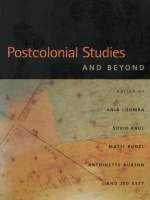 Postcolonial Studies and Beyond
Ania Loomba, Suvir Kaul, Matti Bunzl, Antoinette Burton, and Jed Esty, eds.
Duke University Press, 2005 An interdisciplinary collection of essays designed to map out a wide-ranging and productive future for postcolonial studies, this volume assesses the current state of the field and points toward its most promising new developments. In addressing questions about the definition and relevance of postcolonial scholarship, many of the essays consider its relation to the study of globalization. While some contributors offer broad reflections on the existing two-way influence between postcolonial theory and established university disciplines such as literary criticism and history, others forge ahead into some vital, if nascent, areas for postcolonial research such as media studies, environmental studies, religious studies, and linguistic and semantic analysis. The contributors represent many of the fields altered by postcolonial studies over the past two decades, including literary studies, history, anthropology, Asian and African studies, and political science. They model diverse applications of postcolonial theory to Latin America, East Asia, the Middle East, and the United States. Postcolonial Studies and Beyond propels the field forward. It showcases scholars coming from intellectual precincts usually considered outside the purview of the postcolonial finding new ways to deploy classic techniques of postcolonial analysis, and scholars strongly associated with postcolonial studies offering substantial critiques designed to challenge the field’s most fundamental assumptions. Contributors. Tani E. Barlow, Ali Behdad, Daniel Boyarin, Timothy Brennan, Matti Bunzl, Antoinette Burton, Laura Chrisman, Jean Comaroff, Frederick Cooper, Vilashini Cooppan, Jed Esty, James Ferguson, Peter Hulme, Suvir Kaul, Neil Lazarus, Ania Loomba, Florencia E. Mallon, Nivedita Menon, Rob Nixon, Elizabeth A. Povinelli, David Scott, Ella Shohat, Kelwyn Sole, Robert Stam, Rebecca L. Stein
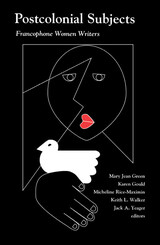 Postcolonial Subjects: Francophone Women Writers
Mary Green
University of Minnesota Press, 1996 Explores French-language writing by women outside France. This groundbreaking volume highlights the work of contemporary women writing in French whose cultural links, ethnic identities, and historical roots lie outside France. The writings of these women emanate from the cultures of Africa and the Indian Ocean, the Middle East, the Caribbean, Southeast Asia, and Quebec and other French-speaking regions of Canada. By writing in French, the writers discussed in Postcolonial Subjects both acknowledge and write against the cultural heritage of France. In doing so, they participate in the subversion of European literary traditions and take part in various forms of cultural and linguistic blending, generating new artistic currents. Each of these essays articulates contemporary debates about the politics and cultural effects of sexism, homophobia, racism, and essentialism, as well as pointing out connections and points of resistance among such diverse strains as feminism, nationalism, and ethnicity. Contributors: Eloise A. Brière, U of Albany; Miriam Cooke, Duke U; Irène Assiba d’Almeida, U of Arizona; Joan Dayan, U of Arizona; John D. Erickson, U of Kentucky; Françoise Lionnet, Northwestern U; Christiane Makward, Pennsylvania State U; Kitzie McKinney, Bentley College; Christopher L. Miller, Yale U; Mary-Kay Miller, Vanderbilt U; Jane Moss, Colby College; Elisabeth Mudimbe-Boyi, Stanford U; Lori Saint-Martin, U du Québec à Montréal; Ronnie Scharfman, Purchase College, SUNY.
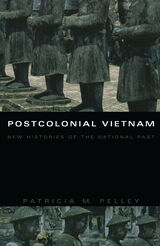 Postcolonial Vietnam: New Histories of the National Past
Patricia M. Pelley
Duke University Press, 2002 New nations require new histories of their struggles for nationhood. Postcolonial Vietnam takes us back to the 1950s to see how official Vietnamese historians and others rethought what counted as history, what producing history entailed, and who should be included as participants and agents in the story. Beginning with government-appointed historians’ first publications in 1954 and following their efforts over the next thirty years, Patricia M. Pelley surveys this daunting process and, in doing so, opens a wide window on the historical forces and tensions that have gone into shaping the new nation of Vietnam.
Although she considers a variety of sources—government directives, census reports, statistics, poetry, civic festivities, ethnographies, and museum displays—Pelley focuses primarily on the work of official historians in Hanoi who argued about and tried to stabilize the meaning of topics ranging from prehistory to the Vietnam War. She looks at their strained and idiosyncratic attempts to plot the Vietnamese past according to Marxist and Stalinist paradigms and their ultimate abandonment of such models. She explores their struggle to redefine Vietnam in multiethnic terms and to normalize the idea of the family-state. Centering on the conversation that began in 1954 among historians in North Vietnam, her work identifies a threefold process of creating the new history: constituting historiographical issues, resolving problems of interpretation and narration, and conventionalizing various elements of the national narrative. As she tracks the processes that shaped the history of postcolonial Vietnam, Pelley dismantles numerous clichés of contemporary Vietnamese history and helps us to understand why and how its history-writing evolved.
Postcolonialism and the Hebrew Bible:The Next Step
Roland Boer
SBL Press, 2013 This volume returns to where initial interest in postcolonial biblical criticism began: the Hebrew Bible. It does so not to celebrate the significant achievements of postcolonial analysis over the last few decades but to ask what the next step might be. In these essays, established and newer scholars, many from the interstices of global scholarship, discuss specific texts, neo/post/colonial situations, and theoretical issues. Moving from the Caribbean to Greenland, from Ezra-Nehemiah to the Gibeonites, this collection seeks out new territory, new questions, and possibly some new answers. The contributors are Roland Boer, Steed Davidson, Richard Horsley, Uriah Y. Kim, Judith McKinlay, Johnny Miles, Althea Spencer-Miller, Leo Perdue, Christina Petterson, Joerg Rieger, and Gerald West.
 Postcolonialisms: An Anthology of Cultural Theory and Criticism
Desai, Gaurav
Rutgers University Press, 2005 Bringing together thirty-seven essays that have helped define the study of colonial and postcolonial cultures, this expansive and thoughtfully organized anthology offers an up-to-date and in-depth overview of this rapidly developing field.
Canonical articles, most unexcerpted, explore postcolonialism’s key themes—power and knowledge—while articles by contemporary scholars expand the discipline to include discussions of the discovery of the New World, Native American and indigenous identities in Latin America and the Pacific, settler colonies in Africa and Australia, English colonialism in Ireland, and feminism in Nigeria and Egypt. The inclusion of a broad sampling of histories and theories attests to multiple, even competing postcolonialisms, while the skillful organization of the volume provides a useful map of the field in terms of recognizable patterns, shared family resemblances, and common genealogies. The book is divided into nine sections: Ideologies of Imperialism, The Critique of Colonial Discourse, The Politics of Language and Literary Studies, Nationalisms and Nativisms, Hybrid Identities, Gender and Sexualities, Reading the Subaltern, Comparative (Post)colonialisms, and Globalization and Postcoloniality. Detailed introductions to each section serve to develop key themes, encourage debate, and contextualize the wide-ranging voices that contribute to the topic.
The most cogent and teachable collection of postcolonial texts yet compiled, this anthology is equally suitable for undergraduate students and seasoned scholars.
Postcoloniality-Decoloniality-Black Critique: Joints and Fissures
Edited by Sabine Broeck and Carsten Junker
Campus Verlag, 2014 Can Western modernity be analyzed and critiqued through the lens of enslavement and colonial history? As this volume reveals, such analysis is not only possible, it is essential to our understanding of contemporary race relations and society generally. Drawing from the fields of postcolonial, decolonial, and black studies, this book assembles contributions from renowned scholars that offer timely and critical perspectives from a variety of disciplines, including history, sociology, political science, gender studies, cultural and literary studies, and philosophy.
 Post-Communist Mafia State: The Case of Hungary
Bálint Magyar
Central European University Press, 2016 In an article in 2001 the author analyzed the way Fidesz, the party on government for the first time then, was eliminating the institutional system of the rule of law. At that time, many readers doubted the legitimacy of the new approach, whose key categories were the 'organized over-world', the 'state employing mafia methods' and the 'adopted political family'. Critics considered these categories metaphors rather than elements of a coherent conceptual framework. Ten years later Fidesz won a two-third majority in Parliament at the 2010 elections: the institutional obstacles of exerting power were thus largely removed. Just like the party, the state itself was placed under the control of a single individual, who since then has applied the techniques used within his party to enforce submission and obedience onto society as a whole. While in many post-communist systems a segment of the party and secret service became the elite in possession of not only political power but also of wealth, Fidesz, as a late-coming new political predator, was able to occupy this position through an aggressive change of elite. The actions of the post-communist mafia state model are led by the logic of power and wealth concentration in the hands of the clan. But while the classical mafia channeled wealth and economic players into its spheres of interest by means of direct coercion, the mafia state does the same by means of parliamentary legislation, legal prosecution, tax authority, police forces and secret service. The new conceptual framework is important and timely not only for Hungary, but also for other post-communist countries subjected to autocratic rules.
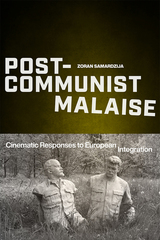 Post-Communist Malaise: Cinematic Responses to European Integration
Zoran Samardzija
Rutgers University Press, 2020 The collapse of communism in the Soviet Union and Eastern Europe was supposed to bring about the “end of history” with capitalism and liberal democracy achieving decisive victories. Europe would now integrate and reconcile with its past. However, the aftershocks of the financial crisis of 2008—the rise in right-wing populism, austerity politics, and mass migration—have shown that the ideological divisions which haunted Europe in the twentieth century still remain. It is within this context that Post-Communist Malaise revives discourses of political modernism and revisits debates from Marxism and seventies film theory. Analyzing work of Theo Angelopoulos, Věra Chytilová, Srdjan Dragojević, Jean-Luc Godard, Miklós Jancsó, Emir Kusturica, Dušan Makavejev, Cristi Puiu, Jan Švankmajer, Andrei Tarkovsky, and Béla Tarr, the book focuses on how select cinemas from Eastern Europe and the Balkans critique the neoliberal integration of Europe whose failures fuel the rise of nationalism and right-wing politics. By politicizing art cinema from the regions, Post-Communist Malaise asks fundamental questions about film, aesthetics, and ideology. It argues for the utopian potential of the materiality of cinematic time to imagine a new political and cultural organization for Europe.
Post-Communist Restitution and the Rule of Law
Csongor Kuti
Central European University Press, 2009 Eastern European societies underwent large-scale deprivations of property by the authoritarian regimes, beginning after World War II, largely ending with the last waves of the kolkhoz movement in the early 1960s. Kuti examines property reparations that took place after 1989, from the perspective of constitutional justice, the rule of law, but also from the point of view of identity politics.
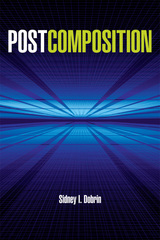 Postcomposition
Sidney I. Dobrin
Southern Illinois University Press, 2011 Leading a burgeoning self-critical moment in composition studies and writing program administration, Postcomposition is a fundamental reconsideration of the field that attempts to shift the focus away from pedagogy and writing subjects and toward writing itself. In this forceful and reasoned critique of many of the primary tenets and widely accepted institutional structures of composition studies, Sidney I. Dobrin delivers a series of shocks to the system meant to disrupt the pedagogical imperative and move beyond the existing limits of the discipline.
Dobrin evaluates the current state of composition studies, underscoring the difference between composition and writing and arguing that the field's focus on the administration of writing students and its historically imposed prohibition on theory greatly limit what can be understood about writing. Instead he envisions a more significant approach to writing, one that questions the field's conservative allegiance to subject and administration and reconsiders writing as spatial and ecological. Using concepts from ecocomposition, spatial theory, network theory, complexity theory, and systems theory, Postcomposition lays the groundwork for a networked theory of writing, and advocates the abandonment of administration as a useful part of the field. He also challenges the usefulness of rhetoric in writing studies, showing how writing exceeds rhetoric.
Postcomposition is a detailed consideration of how posthumanism affects the field's understanding of subjectivity. It also tears at the seams of the "contingent labor problem." As he articulates his own frustrations with the conservatism of composition studies and builds on previous critiques of the discipline, Dobrin stages a courageous-and inevitably polemical-intellectual challenge to the entrenched ideas and assumptions that have defined composition studies.
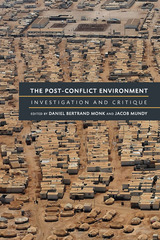 The Post-Conflict Environment: Investigation and Critique
Daniel Bertrand Monk and Jacob Mundy, editors
University of Michigan Press, 2014 In case studies focusing on contemporary crises spanning Africa, the Middle East, and Eastern Europe, the scholars in this volume examine the dominant prescriptive practices of late neoliberal post-conflict interventions—such as statebuilding, peacebuilding, transitional justice, refugee management, reconstruction, and redevelopment—and contend that the post-conflict environment is in fact created and sustained by this international technocratic paradigm of peacebuilding. Key international stakeholders—from activists to politicians, humanitarian agencies to financial institutions—characterize disparate sites as “weak,” “fragile,” or “failed” states and, as a result, prescribe peacebuilding techniques that paradoxically disable effective management of post-conflict spaces while perpetuating neoliberal political and economic conditions. Treating all efforts to represent post-conflict environments as problematic, the goal becomes understanding the underlying connection between post-conflict conditions and the actions and interventions of peacebuilding technocracies.
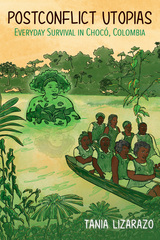 Postconflict Utopias: Everyday Survival in Chocó, Colombia
Tania Lizarazo
University of Illinois Press, 2024 Black women in the department of Chocó, Colombia, respond to the violence endemic to their region with activism and storytelling. Tania Lizarazo focuses on members of COCOMACIA, a Black farmers’ association that defends communities and territories along the nation’s Pacific lowlands’ rivers. Drawing on the life stories of members, Lizarazo explains how Chocó’s Black Colombian women answered firsthand experiences of violence with a dedication to survival and activism. Survival amid armed conflict proves to be an embodied practice. Day by day, the women imagine what memory, peace, and justice could look like when the bloodshed ends. Though peace may seem impossible, wishing and working for a better world motivates these women to steadily dismantle the scaffolding of violence built around their lives. A merger of eyewitness accounts and theory, Postconflict Utopias explores the links between lived knowledge and survival while revealing the power unleashed when women ask the simple question, “Why not?”
 Post-Cowboy Economics: Pay And Prosperity In The New American West
Thomas M. Power and Richard Barrett
Island Press, 2001 A great deal of reactionary political fire in the Mountain West has been aimed at environmental protection measures that are perceived to have destroyed or diminished the livelihoods of long-time residents. Conventional wisdom sees the economic woes afflicting the region -- declining pay, growing inequality, persistent poverty -- as a direct result of increasingly strict environmental regulations that have crippled natural resource industries such as mining and logging.In Post-Cowboy Economics, economists Thomas Michael Power and Richard Barrett provide a new interpretation of the economy of the Mountain West. Based on evidence from a wide variety of sources, including data on individual employment and income histories of more than 300,000 residents, they clearly demonstrate that the region's economic misfortunes are not the result of changes in regional industrial structure but rather are local manifestations of pervasive national and international trends. The authors: discuss and critique entrenched conventional wisdom and its policy implications present an empirical analysis of changes in the region offer a new interpretation of events affecting the regional economy set forth public policies that will work to protect and enhance the economic well-being of its residents and communitiesThe authors' analysis and interpretation make a compelling case that despite incomes that are low compared to the rest of the country, the region is not suffering from general impoverishment, and that environmental protection, rather than threatening economic well-being, enhances welfare and protects the very source of the economic vitality that the Mountain West enjoys. Throughout, they argue that fearful, crisis driven environmental and economic development policies are unnecessary and inappropriate, and often counterproductive.Post-Cowboy Economics is an important work for professionals and scholars involved with environmental policy, economic development, and resource management, as well as anyone interested in the future of the American West."
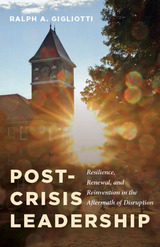 Post-Crisis Leadership: Resilience, Renewal, and Reinvention in the Aftermath of Disruption
Ralph A. Gigliotti
Rutgers University Press, 2025 Given the many pressures facing leaders across higher education, the work of crisis leadership remains an imperative for leaders at all levels. Attention tends to center on strategies for engaging in leadership both prior to and during crisis, often leaving the post-crisis period as an afterthought. This book introduces a research-informed framework for this critical, and often neglected, phase of crisis leadership. With an underlying commitment to values-based, principle-oriented, and people-centered practices, this framework consists of five leadership practices that are recognized as especially critical in the aftermath of crisis: (a) encourage learning, (b) inspire growth, (c) stimulate meaning-making, (d) pursue reinvention, and (e) advance renewal. Communication serves a critical role in each of the various dimensions of post-crisis leadership, and it is a communication orientation that can help to inform the paradoxes, processes, and patterns that arise during these periods of immense tension and, at times, transcendence.
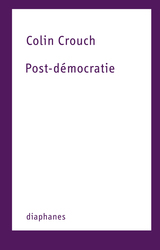 Post-démocratie
Colin Crouch
Diaphanes, 2013 Paru au Royaume-Uni en 2004, cet essai se propose d’explorer les forces sociales et économiques à l’oeuvre dans les démocraties modernes. Partant du malaise profond et de la violente crise de confiance que les peuples de ces pays traversent vis-à-vis des institutions étatiques, Crouch avance que les États y cèdent progressivement tout leur pouvoir décisionnel et leur marge d’action
aux multinationales. L’importance démesurée des flux de capitaux induits par le capitalisme moderne rend en effet les gouvernements extrêmement dépendants des conglomérats. Rejetés et décrédibilisés dans leur fonction même – garantir des services publics et sociaux à la population et à répondre à ses besoins –, ils délèguent ces tâches à des entreprises privées et perdent peu à peu toute légitimité.
Concis et subtilement argumenté, cet essai offre une réponse cinglante aux chantres du néolibéralisme pour qui les sociétés dites avancées ont atteint le degré de démocratie le plus élevé possible ; et propose des pistes concrètes afin de redonner aux citoyens – principaux acteurs de la vie économique et sociale – une réelle marge d’action, dans le cadre d’un système véritablement « démocratique ».
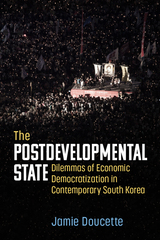 The Postdevelopmental State: Dilemmas of Economic Democratization in Contemporary South Korea
Jamie Doucette
University of Michigan Press, 2024 Over the last 25 years, South Korea has witnessed growing inequality due to the proliferation of non-standard employment, ballooning household debt, deepening export-dependency, and the growth of super-conglomerates such as Samsung and Hyundai. Combined with declining rates of economic growth and turbulent political events, these processes mark a departure from Korea’s past recognition as a high growth “developmental state.”
The Postdevelopmental State radically reframes research into the South Korean economy by foregrounding the efforts of pro-democratic reformers and social movements in South Korea to create an alternative economic model—one that can address Korea’s legacy of authoritarian economic development during the Cold War and neoliberal restructuring since the Asian Financial Crisis of the late 1990s. Understanding these attempts offers insight into the types of economic reforms that have been enacted since the late 1990s as well as the continued legacy of dictatorship-era politics within the Korean political and legal system. By examining the dilemmas economic democracy has encountered over the past 25 years, from the IMF Crisis to the aftermath of the Candlelight Revolution, the book reveals the enormous and comprehensive challenges involved in addressing the legacy of authoritarian economic models and their neoliberal transformations.
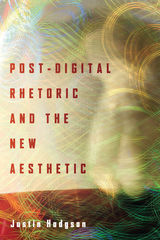 Post-Digital Rhetoric and the New Aesthetic
Justin Hodgson
Ohio State University Press, 2019 The proliferation of smart devices, digital media, and network technologies has led to everyday people experiencing everyday things increasingly on and through the screen. In fact, much of the world has become so saturated by digital mediations that many individuals have adopted digitally inflected sensibilities. This gestures not simply toward posthumanism, but more fundamentally toward an altogether post-digital condition—one in which the boundaries between the “real” and the “digital” have become blurred and technology has fundamentally reconfigured how we make sense of the world.
Post-Digital Rhetoric and the New Aesthetic takes stock of these reconfigurations and their implications for rhetorical studies by taking up the New Aesthetic—a movement introduced by artist/digital futurist James Bridle that was meant to capture something of a digital way of seeing by identifying aesthetic values that could not exist without computational and digital technologies. Bringing together work in rhetoric, art, and digital media studies, Hodgson treats the New Aesthetic as a rhetorical ecology rather than simply an aesthetic movement, allowing him to provide operative guides for the knowing, doing, and making of rhetoric in a post-digital culture.
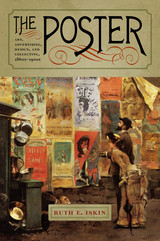 The Poster: Art, Advertising, Design, and Collecting, 1860s–1900s
Ruth E. Iskin
Dartmouth College Press, 2014 The Poster: Art, Advertising, Design, and Collecting, 1860s–1900s is a cultural history that situates the poster at the crossroads of art, design, advertising, and collecting. Though international in scope, the book focuses especially on France and England. Ruth E. Iskin argues that the avant-garde poster and the original art print played an important role in the development of a modernist language of art in the 1890s, as well as in the adaptation of art to an era of mass media. She moreover contends that this new form of visual communication fundamentally redefined relations between word and image: poster designers embedded words within the graphic, rather than using images to illustrate a text. Posters had to function as effective advertising in the hectic environment of the urban street. Even though initially commissioned as advertisements, they were soon coveted by collectors. Iskin introduces readers to the late nineteenth-century “iconophile”—a new type of collector/curator/archivist who discovered in poster collecting an ephemeral archaeology of modernity. Bridging the separation between the fields of art, design, advertising, and collecting, Iskin’s insightful study proposes that the poster played a constitutive role in the modern culture of spectacle. This stunningly illustrated book will appeal to art historians and students of visual culture, as well as social and cultural history, media, design, and advertising.
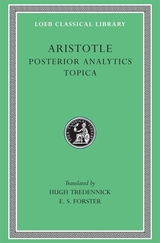 Posterior Analytics. Topica
Aristotle
Harvard University Press The philosopher’s toolkit.
Aristotle, great Greek philosopher, researcher, reasoner, and writer, born at Stagirus in 384 BC, was the son of a physician. He studied under Plato at Athens and taught there (367–347); subsequently he spent three years at the court of a former pupil in Asia Minor. After some time at Mitylene, in 343–342 he was appointed by King Philip of Macedon to be tutor of his teen-aged son Alexander. After Philip’s death in 336, Aristotle became head of his own school (of “Peripatetics”), the Lyceum at Athens. Because of anti-Macedonian feeling there after Alexander’s death in 323, he withdrew to Chalcis in Euboea, where he died in 322.
Nearly all the works Aristotle prepared for publication are lost; the priceless ones extant are lecture-materials, notes, and memoranda (some are spurious). They can be categorized as follows:
I Practical: Nicomachean Ethics; Great Ethics (Magna Moralia); Eudemian Ethics; Politics; Economics (on the good of the family); On Virtues and Vices.
II Logical: Categories; Analytics (Prior and Posterior); Interpretation; Refutations used by Sophists; Topica.
III Physical: Twenty-six works (some suspect) including astronomy, generation and destruction, the senses, memory, sleep, dreams, life, facts about animals, etc.
IV Metaphysics: on being as being.
V Art: Rhetoric and Poetics.
VI Other works including the Constitution of Athens; more works also of doubtful authorship.
VII Fragments of various works such as dialogues on philosophy and literature; and of treatises on rhetoric, politics, and metaphysics.
The Loeb Classical Library edition of Aristotle is in twenty-three volumes.
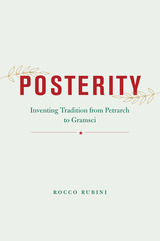 Posterity: Inventing Tradition from Petrarch to Gramsci
Rocco Rubini
University of Chicago Press, 2022 Reading a range of Italian works, Rubini considers the active transmittal of traditions through generations of writers and thinkers.
Rocco Rubini studies the motives and literary forms in the making of a “tradition,” not understood narrowly, as the conservative, stubborn preservation of received conventions, values, and institutions, but instead as the deliberate effort on the part of writers to transmit a reformulated past across generations. Leveraging Italian thinkers from Petrarch to Gramsci, with stops at prominent humanists in between—including Giambattista Vico, Carlo Goldoni, Francesco De Sanctis, and Benedetto Croce—Rubini gives us an innovative lens through which to view an Italian intellectual tradition that is at once premodern and modern, a legacy that does not depend on a date or a single masterpiece, but instead requires the reader to parse an expanse of writings to uncover deeper transhistorical continuities that span six hundred years. Whether reading work from the fourteenth century, or from the 1930s, Rubini elucidates the interplay of creation and the reception underlying the enactment of tradition, the practice of retrieving and conserving, and the revivification of shared themes and intentions that connect thinkers across time. Building on his award-winning book, The Other Renaissance, this will prove a valuable contribution for intellectual historians, literary scholars, and those invested in the continuing humanist legacy.
 Posterity Is Now: Practicing Museum Anthropology, Collections Care, and Collaborative Research with Indigenous Peoples
Jennifer A. Shannon
University of Wyoming Press, 2025 Posterity Is Now is about doing—about how to do—museum anthropology, collections stewardship, and collaborative research based on working in collaboration with Indigenous communities. Guided by values-centered practice, this book shows how following Indigenous communities’ lead, being flexible, and creating a welcoming environment to build essential relationships can reorient museums to support cultural continuity instead of merely preserving objects.
In this handbook based on over twenty years of teaching and practice at the intersection of museums, anthropology, and Indigenous peoples, Jennifer A. Shannon covers both the theoretical (i.e., exploring the idea of objects as kin) and the pragmatic (i.e., guidelines for how to design and budget collaborative projects). She advocates for fundamental change in how anthropological research design and practice are done within and beyond the museum and how leadership and staff view the very purpose of the museum. She also demonstrates how collaborative museum anthropology can be a model for the fields of anthropology, public scholarship, and social science research more broadly.
Posterity Is Now is a starting point, a “companion to practice,” written in accessible language and equally relevant for use in university classrooms, by qualitative researchers, and by practitioners in museums and cultural centers.
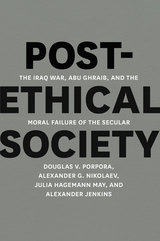 Post-Ethical Society: The Iraq War, Abu Ghraib, and the Moral Failure of the Secular
Douglas V. Porpora, Alexander G. Nikolaev, Julia Hagemann May, and Alexander Jenkins
University of Chicago Press, 2013 We’ve all seen the images from Abu Ghraib: stress positions, US soldiers kneeling on the heads of prisoners, and dehumanizing pyramids formed from black-hooded bodies. We have watched officials elected to our highest offices defend enhanced interrogation in terms of efficacy and justify drone strikes in terms of retribution and deterrence. But the mainstream secular media rarely addresses the morality of these choices, leaving us to ask individually: Is this right?
In this singular examination of the American discourse over war and torture, Douglas V. Porpora, Alexander Nikolaev, Julia Hagemann May, and Alexander Jenkins investigate the opinion pages of American newspapers, television commentary, and online discussion groups to offer the first empirical study of the national conversation about the 2003 invasion of Iraq and the revelations of prisoner abuse at Abu Ghraib a year later. Post-Ethical Society is not just another shot fired in the ongoing culture war between conservatives and liberals, but a pensive and ethically engaged reflection of America’s feelings about itself and our actions as a nation. And while many writers and commentators have opined about our moral place in the world, the vast amount of empirical data amassed in Post-Ethical Society sets it apart—and makes its findings that much more damning.
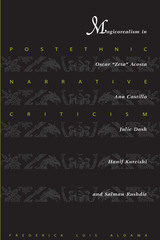 Postethnic Narrative Criticism: Magicorealism in Oscar "Zeta" Acosta, Ana Castillo, Julie Dash, Hanif Kureishi, and Salman Rushdie
By Frederick Luis Aldama
University of Texas Press, 2003 Magical realism has become almost synonymous with Latin American fiction, but this way of representing the layered and often contradictory reality of the topsy-turvy, late-capitalist, globalizing world finds equally vivid expression in U.S. multiethnic and British postcolonial literature and film. Writers and filmmakers such as Oscar "Zeta" Acosta, Ana Castillo, Julie Dash, Hanif Kureishi, and Salman Rushdie have made brilliant use of magical realism to articulate the trauma of dislocation and the legacies of colonialism that people of color experience in the postcolonial, multiethnic world. This book seeks to redeem and refine the theory of magical realism in U.S. multiethnic and British postcolonial literature and film. Frederick Aldama engages in theoretically sophisticated readings of Ana Castillo's So Far from God, Oscar "Zeta" Acosta's Autobiography of a Brown Buffalo, Salman Rushdie's Midnight's Children, Shame, The Satanic Verses, and The Moor's Last Sigh, Julie Dash's Daughters of the Dust, and Stephen Frears and Hanif Kureishi's Sammy and Rosie Get Laid. Coining the term "magicorealism" to characterize these works, Aldama not only creates a postethnic critical methodology for enlarging the contact zone between the genres of novel, film, and autobiography, but also shatters the interpretive lens that traditionally confuses the transcription of the real world, where truth and falsity apply, with narrative modes governed by other criteria.
 Post-Fascist Fantasies: Psychoanalysis, History, and the Literature of East Germany
Julia Hell
Duke University Press, 1997 Post-Fascist Fantasies examines the cultural function of the novels of communist authors in East Germany from a psychoanalytic angle. Various critics have argued that these socialist realist fictions were monolithic attempts to translate Communist dogma into the realm of aesthetics. Julia Hell argues to the contrary that they were in fact complex fictions sharing the theme of antifascism, the founding discourse of the German Democratic Republic. Employing an approach informed by Slavoj Zizek’s work on the Communist’s sublime body and by British psychoanalytic feminism’s concern with feminine subjectivity, Hell first examines the antifascist works by exiled authors and authors tied to the resistance movement. She then strives to understand the role of Christa Wolf, the GDR’s most prominent author, in the GDR’s effort to reconstruct symbolic power after the Nazi period.
By focusing on the unconscious fantasies about post-fascist body and post-fascist voice that suffuse the texts of Wolf and others, Hell radically reconceptualizes the notion of the author’s subjective authenticity. Since this notion occupies a key position in previous literary-historical accounts of East German culture, Hell’s psychoanalytic approach problematizes the established literary model of an "authentic feminine voice" that gradually liberates itself from the GDR’s dominant ideological narrative. Far from operating solely on a narrowly political level, the novels of Wolf and others were intricate family sagas portraying psychic structures linked in complex ways to the GDR’s social dynamics. Hell traces this link through East German literatrure’s dominant narrative, a paternal narrative organized around the figure of the Communist father as antifascist hero.
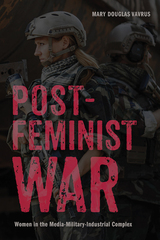 Postfeminist War: Women in the Media-Military-Industrial Complex
Mary Douglas Vavrus
Rutgers University Press, 2019 Media representations and practices that have emerged out of contemporary wars have been well documented by a wide array of books and articles. These treatments, however, have been less attentive to how cultural constructions of military personnel and war itself figure in the depiction of the incursions in Iraq and Afghanistan. In Post-Feminist War, Mary Douglas Vavrus argues that all of these identity categories are integral to our understanding of those fighting, saved, or victimized by war. She considers two important questions: how the construction of gender, race, and class in media are productive of régimes of truth regarding war and military life, and how such constructions may also intensify militarism. By examining news and documentary media produced since September 11, 2001, Vavrus demonstrates that news narratives that include women use feminism selectively in gender equality narratives, which tend to reinforce historically resonant gender, race, and class identity constructions. She ultimately asserts that such reporting advances post-feminism, which, in tandem with banal militarism, subtly pushes military solutions for an array of problems women and girls face.
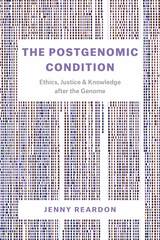 The Postgenomic Condition: Ethics, Justice, and Knowledge after the Genome
Jenny Reardon
University of Chicago Press, 2017 Now that we have sequenced the human genome, what does it mean? In The Postgenomic Condition, Jenny Reardon critically examines the decade after the Human Genome Project, and the fundamental questions about meaning, value and justice this landmark achievement left in its wake.
Drawing on more than a decade of research—in molecular biology labs, commercial startups, governmental agencies, and civic spaces—Reardon demonstrates how the extensive efforts to transform genomics from high tech informatics practiced by a few to meaningful knowledge beneficial to all exposed the limits of long-cherished liberal modes of knowing and governing life. Those in the American South challenged the value of being included in genomics when no hospital served their community. Ethicists and lawyers charged with overseeing Scottish DNA and data questioned how to develop a system of ownership for these resources when their capacity to create things of value—new personalized treatments—remained largely unrealized. Molecular biologists who pioneered genomics asked whether their practices of thinking could survive the deluge of data produced by the growing power of sequencing machines. While the media is filled with grand visions of precision medicine, The Postgenomic Condition shares these actual challenges of the scientists, entrepreneurs, policy makers, bioethicists, lawyers, and patient advocates who sought to leverage liberal democratic practices to render genomic data a new source of meaning and value for interpreting and caring for life. It brings into rich empirical focus the resulting hard on-the-ground questions about how to know and live on a depleted but data-rich, interconnected yet fractured planet, where technoscience garners significant resources, but deeper questions of knowledge and justice urgently demand attention.
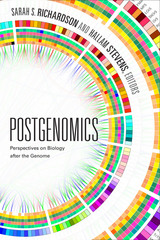 Postgenomics: Perspectives on Biology after the Genome
Sarah S. Richardson and Hallam Stevens, editors
Duke University Press, 2015 Ten years after the Human Genome Project’s completion the life sciences stand in a moment of uncertainty, transition, and contestation. The postgenomic era has seen rapid shifts in research methodology, funding, scientific labor, and disciplinary structures. Postgenomics is transforming our understanding of disease and health, our environment, and the categories of race, class, and gender. At the same time, the gene retains its centrality and power in biological and popular discourse. The contributors to Postgenomics analyze these ruptures and continuities and place them in historical, social, and political context. Postgenomics, they argue, forces a rethinking of the genome itself, and opens new territory for conversations between the social sciences, humanities, and life sciences.
Contributors. Russ Altman, Rachel A. Ankeny, Catherine Bliss, John Dupré, Michael Fortun, Evelyn Fox Keller, Sabina Leonelli, Adrian Mackenzie, Margot Moinester, Aaron Panofsky, Sarah S. Richardson, Sara Shostak, Hallam Stevens
 The Post-Global City: Theorizing Technology Cultures in Urban Africa
Editors: Katrien Pype, Omolade Adunbi and Michael M.J. Fischer
University of Michigan Press, 2026 The Post-Global City seeks to open a new field of analytical inquiry that examines knowledge production and technological developments in urban Africa rooted in local, historical realities, while also partaking in transnational, global processes. This work explores the ways in which urban residents have utilized technologies and networks to operate around, under, and beyond the state and the international “order,” and challenges the stereotypical images of Africa as a continent either devoid of technology or filled with either broken technologies or technologies from the Global North or Asia. This book focuses on accounts and critiques of new “Rising Africa” ideologies, examining megaprojects such as geothermal and hydroelectric plants with new networked startups that circumvent state and patriarchal hierarchies, women vendors selling online, youths designing and constructing oil refining technologies and tech startups working across diasporas.
Grounded in ethnographic fieldwork carried out in urban spaces in Nigeria, Kenya, the Democratic Republic of Congo, Sudan, Gabon, Cameroon, and Tanzania, The Post-Global City brings together voices from Africa, Europe, and the United States to inquire into the dialectics between technology and the urban on the African continent.
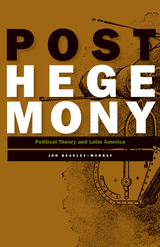 Posthegemony: Political Theory and Latin America
Jon Beasley-Murray
University of Minnesota Press, 2010 Posthegemony is an investigation into the origins, limits, and possibilities for contemporary politics and political analysis. Jon Beasley-Murray grounds his theoretical discussion with accounts of historical movements in Latin America, from Columbus to Chávez, and from Argentine Peronism to Peru's Sendero Luminoso.
Challenging dominant strains in social theory, Beasley-Murray contends that cultural studies simply replicates the populism that conditions it, and that civil society theory merely nourishes the neoliberalism that it sets out to oppose. Both end up entrenching the fiction of a social contract. In place of hegemony or civil society, Beasley-Murray presents a theory of posthegemony, focusing on affect, habit, and the multitude. This approach addresses an era of biopolitics and bare life, tedium and terror, in which state control is ever more pervasive but something always escapes.
In his thorough examination, Beasley-Murray undoes the dominant narrative of hegemonic projects and counterhegemonic resistance, of civilization and subalternity, to reveal instead a history of failed contracts and unpredicted insurgencies.
 Post-History
Vilém Flusser
University of Minnesota Press, 2013
Is there any room left for freedom in a programmed world? This is the essential question that Vilém Flusser asks in Post-History. Written as a series of lectures to be delivered at universities in Brazil, Israel, and France, it was subsequently developed as a book and published for the first time in Brazil in 1983. This first English translation of Post-History brings to an anglophone readership Flusser’s first critique of apparatus as the aesthetic, ethical, and epistemological model of present times.
In his main argument, Flusser suggests that our times may be characterized by the term “program,” much in the same way that the seventeenth century is loosely characterized by the term “nature,” the eighteenth by “reason,” and the nineteenth by “progress.” In suggesting this shift in worldview, he then poses a provocative question: If I function within a predictable programmed reality, can I rebel and how can I do it? The answer comes swiftly: Only malfunctioning programs and apparatus allow for freedom. Throughout the twenty essays of Post-History, Flusser reminds us that any future theory of political resistance must consider this shift in worldview, together with the horrors that Western society has brought into realization because of it. Only then may we start to talk again about freedom.
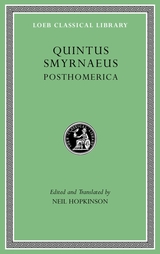 Posthomerica
Quintus Smyrnaeus
Harvard University Press, 2018 A late epic bridge between Homeric masterpieces.
Quintus Smyrnaeus’ Posthomerica, the only long mythological epic to survive in Greek from the period between Apollonius’ Argonautica (3rd century BC) and Nonnus’ Dionysiaca (5th century AD), fills in the whole story of the Trojan expedition between the end of Homer’s Iliad and the beginning of the Odyssey, which had been treated only episodically by earlier epic and dramatic poets. Composing sometime between the late second and mid-fourth centuries AD, Quintus boldly adapts Homeric diction and style to suit the literary, moral, religious, rhetorical, and philosophical culture of the high Roman Empire, and does not hesitate to diverge from the usual versions of the story in order to craft his own narrative vision.
This edition of the Posthomerica replaces the earlier Loeb Classical Library edition by A. S. Way (1913) with an updated text based on that of F. Vian, and fresh translation, introduction, and bibliography that take account of more than a century of intervening scholarship.
 The Posthuman Condition: Consciousness Beyond the Brain
Robert Pepperell
Intellect Books, 2009 "Where humanists saw themselves as distinct beings in an antagonistic relationship with their surroundings, posthumans regard their own being as embodied in an extended technological world."
Synthetic creativity, organic computers, genetic modification, intelligent machines--such ideas are deeply challenging to many of our traditional assumptions about human uniqueness and superiority. But, ironically, it is our very capacity for technological invention that has secured us so dominant a position in the world which may lead ultimately to (as some have put it) 'The End of Man'. If we are really capable of creating entities that exceed our own skills and intellect then the consequences for humanity are almost inconceivable. Nevertheless, we must now face up to the possibility that attributes like intelligence and consciousness may be synthesised in non-human entities--perhaps within our lifetime. Would such entities have human-like emotions; would they have a sense of their own being?
The Posthuman Condition argues that such questions are difficult to tackle given the concepts of human existence that we have inherited from humanism, many of which can no longer be sustained. New theories about nature and the operation of the universe arising from sophisticated computer modelling are starting to demonstrate the profound interconnections between all things in reality where previously we had seen only separations. This has implications for traditional views of the human condition, consciousness, the way we look at art, and for some of the oldest problems in philosophy.
First published in the 1990s, this important text has been completely revised by the author with the addition of new sections and illustrations.
For further information see: www.post-human.net
Posthumanism and the Graphic Novel in Latin America
Edward King and Joanna Page
University College London, 2017 Latin America is experiencing a boom in graphic novels that are innovative in their conceptual play and their reworking of the medium. Drawing on a range of sophisticated work, these graphic novels experiment with questions of the representation of urban space, modes of perception and cognition, and new forms of ethics in the post-human world. As the first book-length study of the topic, this book argues that the graphic novel’s emergence in Latin America acts as a uniquely powerful force exploring the nature of twenty-first-century subjectivity, emphasizing the ways that humans are bound to their non-human environment.
The Posthumous Affair
James Friel
Tupelo Press, 2012 In the late nineteenth century, in Washington Square, two children play with a red balloon… and so begins the strange romance between Daniel, beautiful and tiny, and Grace, known as The Fat Princess, an orphaned girl whose enormous girth matches her wealth. Each wishes for a life of the mind, for artistic mastery, to be read and to be understood — most of all by each other — but through their lives, the couple only occasionally meet, until Daniel uncovers Grace’s great secret in her House of Death.
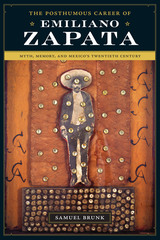 The Posthumous Career of Emiliano Zapata: Myth, Memory, and Mexico's Twentieth Century
By Samuel Brunk
University of Texas Press, 2008 Before there was Che Guevara, there was Emiliano Zapata, the charismatic revolutionary who left indelible marks on Mexican politics and society. The sequel to Samuel Brunk's 1995 biography of Zapata, The Posthumous Career of Emiliano Zapata traces the power and impact of this ubiquitous, immortalized figure. Mining the massive extant literature on Zapata, supplemented by archival documents and historical newspaper accounts, Brunk explores frameworks of myth and commemoration while responding to key questions regarding the regime that emerged from the Zapatista movement, including whether it was spawned by a genuinely "popular" revolution. Blending a sophisticated analysis of hegemonic systems and nationalism with lively, accessible accounts of ways in which the rebel is continually resurrected decades after his death in a 1919 ambush, Brunk delves into a rich realm of artistic, geographical, militaristic, and ultimately all-encompassing applications of this charismatic icon. Examining all perspectives, from politicized commemorations of Zapata's death to popular stories and corridos, The Posthumous Career of Emiliano Zapata is an eloquent, engaging portrait of a legend incarnate.
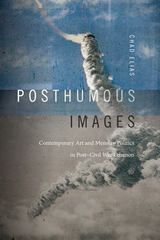 Posthumous Images: Contemporary Art and Memory Politics in Post–Civil War Lebanon
Chad Elias
Duke University Press, 2018 For almost two decades of its history (1975-90), Lebanon was besieged by sectarian fighting, foreign invasions, and complicated proxy wars. In Posthumous Images, Chad Elias analyzes a generation of contemporary artists who have sought, in different ways, to interrogate the contested memory of those years of civil strife and political upheaval. In their films, photography, architectural projects, and multimedia performances, these artists appropriate existing images to challenge divisive and violent political discourses. They also create new images that make visible individuals and communities that have been effectively silenced, rendered invisible, or denied political representation. As Elias demonstrates, these practices serve to productively unsettle the distinctions between past and present, the dead and the living, official history and popular memory. In Lebanon, the field of contemporary art is shown to be critical to remembering the past and reimagining the future in a nation haunted by a violent and unresolved war.
 Posthumous Love: Eros and the Afterlife in Renaissance England
Ramie Targoff
University of Chicago Press, 2014 For Dante and Petrarch, posthumous love was a powerful conviction. Like many of their contemporaries, both poets envisioned their encounters with their beloved in heaven—Dante with Beatrice, Petrarch with Laura. But as Ramie Targoff reveals in this elegant study, English love poetry of the Renaissance brought a startling reversal of this tradition: human love became definitively mortal. Exploring the boundaries that Renaissance English poets drew between earthly and heavenly existence, Targoff seeks to understand this shift and its consequences for English poetry.
Targoff shows that medieval notions of the somewhat flexible boundaries between love in this world and in the next were hardened by Protestant reformers, who envisioned a total break between the two. Tracing the narrative of this rupture, she focuses on central episodes in poetic history in which poets developed rich and compelling compensations for the lack of posthumous love—from Thomas Wyatt’s translations of Petrarch’s love sonnets and the Elizabethan sonnet series of Shakespeare and Spencer to the carpe diem poems of the seventeenth century. Targoff’s centerpiece is Romeo and Juliet, where she considers how Shakespeare’s reworking of the Italian story stripped away any expectation that the doomed teenagers would reunite in heaven. Casting new light on these familiar works of poetry and drama, this book ultimately demonstrates that the negation of posthumous love brought forth a new mode of poetics that derived its emotional and aesthetic power from its insistence upon love’s mortal limits.
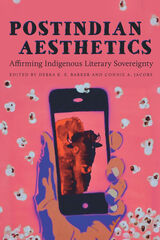 Postindian Aesthetics: Affirming Indigenous Literary Sovereignty
Edited by Debra K. S. Barker and Connie A. Jacobs
University of Arizona Press, 2022 Postindian Aesthetics is a collection of critical, cutting-edge essays on Indigenous writers who are creatively and powerfully contributing to a thriving Indigenous literary aesthetic. This book argues for a literary canon that includes Indigenous literature that resists colonizing stereotypes of what has been and often still is expected in art produced by American Indians.
The works featured are inventive and current, and the writers covered are visionaries who are boldly redefining Indigenous literary aesthetics. The artists covered include Orlando White, LeAnne Howe, Stephen Graham Jones, Deborah Miranda, Heid E. Erdrich, Sherwin Bitsui, and many others.
Postindian Aesthetics is expansive and comprehensive with essays by many of today’s leading Indigenous studies scholars. Organized thematically into four sections, the topics in this book include working-class and labor politics, queer embodiment, national and tribal narratives, and new directions in Indigenous literatures. By urging readers to think beyond the more popularized Indigenous literary canon, the essays in this book open up a new world of possibilities for understanding the contemporary Indigenous experience.
The volume showcases thought-provoking scholarship about literature written by important contemporary Indigenous authors who are inspiring critical acclaim and offers new ways to think about the Indigenous literary canon and encourages instructors to broaden the scope of works taught in literature courses more broadly.
ContributorsEric Gary Anderson
Ellen L. Arnold
Debra K. S. Barker
Laura J. Beard
Esther G. Belin
Jeff Berglund
Sherwin Bitsui
Frank Buffalo Hyde
Jeremy M. Carnes
Gabriel S. Estrada
Stephanie Fitzgerald
Jane Haladay
Connie A. Jacobs
Daniel Heath Justice
Virginia Kennedy
Denise Low
Molly McGlennen
Dean Rader
Kenneth M. Roemer
Susan Scarberry-García
Siobhan Senier
Kirstin L. Squint
Robert Warrior
 Posting for Power: Congressional Partisanship on Social Media
Jeremy Gelman and Steven Lloyd Wilson
University of Michigan Press, 2026 Among the most common features of the modern US Congress is its partisanship, a deeply felt political divide that sometimes seems to be each side’s primary motivator. In Congress we have seen heated disagreements, a tendency to blame the opposing party for any bad outcome, and attempts to undermine the other side’s successes. For those watching Congress, it is easy to assume everyone on Capitol Hill participates equally in framing issues as pitting Democrats versus Republicans. Yet in Posting for Power, Jeremy Gelman and Steven Wilson show that partisanship varies a great deal among legislators: it is motivated by reelection and promotion-seeking considerations, and it comes with no substantial legislative or electoral consequences.
In the US Congress, lawmakers regularly choose to bicker for political gain, whether or not they disagree on issues. By classifying millions of social media posts as partisan or not, Gelman and Wilson quantify a legislator’s partisan intensity through the time and effort they spend supporting their party and bickering with the opposition. The authors argue that the partisan personas politicians create are both a home style, to help them win reelection, and hill style, to help them become politically influential by showing off as good team players. Bringing together a wide range of data on leadership races, elections, voting records, cosponsorship patterns, and lawmaking outcomes, they demonstrate the nearly consequence-free way that legislators strategically deploy partisanship to impress their copartisans and voters. Gelman and Wilson closely examine what motivates members to differ so much in developing this part of their public personas and offer clear recommendations for how to turn down the partisan heat on Capitol Hill.
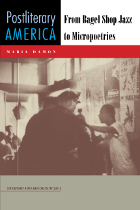 Postliterary America: From Bagel Shop Jazz to Micropoetries
Maria Damon
University of Iowa Press, 2011 In this capacious and challenging book, Maria Damon surveys the poetry and culture of the United States in two distinct but inextricably linked periods. In part 1, “Identity K/not/e/s,” she considers the America of the 1950s and early 1960s, when contentious and troubled alliances took shape between different marginalized communities and their respective but overlapping bohemias—Jews, African Americans, the Beats, and gays and lesbians. Using a rich trove of texts and artifacts—ranging from Gertrude Stein’s writings about her own Jewishness to transcripts from Lenny Bruce’s obscenity trial, Bob Kaufman’s Beat poetry—as well as her own stake in the material, Damon plumbs the complexities of social identity and expressive cultures to fascinating effect. Always erudite but never effete, Damon then turns to more contemporary issues and broader topics of poetics: micropoetries, cyberpoetics, spoken-word poets, performance poets, and their communities. Echoing many of the themes of the first section of the book, including poetic identity and the troubled nature of the poetic “I,” part 2’s “Poetics for a Postliterary America” goes on to paint a wider picture, dwelling less on close readings of individual poems and more on asking questions about the nature of poetry itself and its role in community formation and individual survival. Discussions of counterperformance, kinetics, the Nuyoricans, Latino identity, and electronic poetics enliven this section. Never reluctant to acknowledge the deeply personal origins of the work at hand, Damon cleaves to the subject matter, be it questions of identity, matters of poetry, or what it means to live in a postliterary culture. In doing so, she dares to ask what it means to be a member of the “shadow people”—those who occupy marginalized, nocturnal counterculture—creating verbal art.
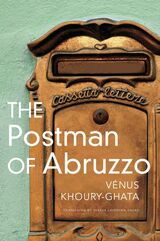 The Postman of Abruzzo
Vénus Khoury-Ghata
Seagull Books, 2023 A lyrical novel concerning belonging, foreignness, and ethnicity.
Following the path of her late geneticist husband, Laure arrives in the town of Malaterra in the harsh mountains of Abruzzo in Italy, where her husband was studying the close-knit Albanian inhabitants. At first an intruder, she is gradually accepted by the population, which is made up of amusing, eccentric characters. Among them: Helena, who hanged her dishonored daughter from the fig tree in her garden, and who has been waiting for thirty years with her gun for her daughter’s rapist to return; the Kosovar, a distrusted bookseller languishing in his dusty shop; Mourad, the baker, who proposes marriage to Laure and every other woman who enters his bakery; and Yussuf, the postman, who makes his rounds even if there is no mail to deliver. We also meet the unfortunate assailant who returns from his exile to reclaim and restore his family home. With humor and compassion, this book brings to life the inhabitants of a small, remote town in the mountains of Abruzzo.
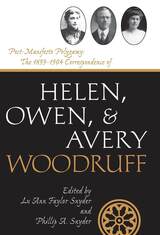 Post-Manifesto Polygamy: The 1899 to 1904 Correspondence of Helen, Owen and Avery Woodruff
Lu Ann Faylor Snyder and Phillip A. Snyder
Utah State University Press, 2009 These letters among two women and their husband offer a rare look into the personal dynamics of an LDS polygamous relationship. Abraham “Owen” Woodruff was a young Mormon apostle, the son of President Wilford Woodruff, remembered for the Woodruff Manifesto, which called for the divinely inspired termination of plural marriage. It eased a systematic federal judicial assault on Mormons and made Utah statehood possible. It did not end polygamy in the church. Some leaders continued to encourage and perform such marriages. Owen Woodruff himself contracted a secretive, second marriage to Avery Clark. Pressure on the LDS church revived with hearings regarding Reed Smoot’s seat in the U. S. Senate. After church president Joseph F. Smith issued the so-called Second Manifesto in 1904, polygamy and its more prominent advocates were mostly expunged from mainstream Mormonism. Owen Woodruff was not excommunicated, as a couple of his apostolic colleagues were. He and his first wife, Helen May Winters, had died suddenly that same year after contracting smallpox in Mexico. Owen Woodruff had often been “on the underground,” moving frequently, traveling under secret identities, and using code names in his letters to his wives, while still carrying out his administrative duties, which, in particular, involved supervision of the nascent Mormon colonies in the Big Horn Basin of Wyoming.
 Post-Military Society: Militarism, Demilitarization and War at the End of the Twentieth Century
Martin Shaw
Temple University Press, 1991 With the collapse of the Cold War following the Eastern European revolutions and the ongoing democratization of the Soviet republics, optimism about peace has transformed the international political climate. Incidents such as the Gulf War, however, have tempered this optimism and cast doubts on the prospects for demilitarization. In this book, Martin Shaw examines some of the developments that lie behind the recent momentous changes and argues that, despite the Gulf War and other regional wars, militarism is in decisive retreat.
Writing from a broadly sociological perspective, Shaw examines the roles of war and military institutions in human society and the ways in which preoccupation with war has affected domestic, regional, and international politics in the twentieth century. In doing so, he asks: When does the post-war era end? How have nuclear weapons altered the perception of war by society? What is the relationship between industrialism and militarism?
The author contends that, despite the militarism of some Third World countries, societies in the advanced industrial world (especially in Europe) have been undergoing a profound demilitarization. These societies have become politically insulated from war preparation, have recognized the effect of social movements on inter-state relations, and are experiencing a "revolution of rising expectations."
Offering evidence of "post-military citizenship," Shaw describes the increasing resistance to military conscription throughout the Western world, the replacement of blind obedience with demand for accountability in Eastern bloc countries, and the simultaneous rise of nationalism and communitarianism among common market members. And, in light of the collapse of Stalinist militarism in Europe and the USSR, Shaw suggests some of the changes that face Soviet society.
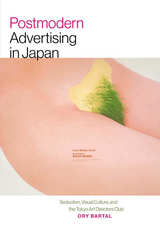 Postmodern Advertising in Japan: Seduction, Visual Culture, and the Tokyo Art Directors Club
Ory Bartal
Dartmouth College Press, 2015 In a study driven by stunning images of Japanese advertisements and the artworks they quote from, Ory Bartal offers a first-of-its-kind interpretation of the “postmodern” genre of advertising in Japan, which both shaped and reflected the new consumer-driven culture that arose during the bubble era of the 1980s and 1990s. Through a fascinating tale of art directors and their works and influences, Bartal shows how this postmodern visual language, like postmodernism in other streams, is distinguished by its mélange of styles, blurring of boundaries between art and design, and reliance on visual and textual quotations from sources past and present, domestic and foreign. Although this advertising culture partakes of global trends, Bartal draws attention to the varied local artistic sensibilities, structures of thought, and underlying practices, challenging the often-simplistic characterization of “Japaneseness” as being rooted in a Zen tradition of aesthetic indirectness and ambiguity. Combining multilingual scholarship with a wealth of information gleaned through years of personal interviews with the principals involved, this is a truly original contribution to the discussion of Japanese art and advertising as well as an insightful reading of more general issues in the study of visual culture and media.
Postmodern Animal
Steve Baker
Reaktion Books, 2000 In The Postmodern Animal, Steve Baker explores how animal imagery has been used in modern and contemporary art and performance, and in postmodern philosophy and literature, to suggest and shape ideas about identity and creativity. Baker cogently analyses the work of such European and American artists as Olly and Suzi, Mark Dion, Paula Rego and Sue Coe, at the same time looking critically at the constructions, performances and installations of Robert Rauschenberg, Louise Bourgeois, Joseph Beuys and other significant late twentieth-century artists. Baker's book draws parallels between the animal's place in postmodern art and poststructuralist theory, drawing on works as diverse as Jacques Derrida's recent analysis of the role of animals in philosophical thought and Julian Barnes's best-selling Flaubert's Parrot.
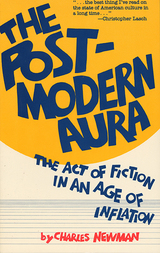 Post-Modern Aura: The Act of Fiction in an Age of Inflation
Charles Newman
Northwestern University Press, 1985 The Post-Modern Aura is Charles Newman's classic and incendiary polemic about the "Post-Modern" attitude in fiction, culture, and sensibility. In it, he challenges the "revolutionary" claims of avant-garde novelists and literary theorists as well as the arguments of neoconservatives, neorealists, and advocates of "moral fiction." Newman argues that neither of these groups confront the unprecedented break with tradition entailed by an economics and culture of inflation. A combination of cultural critique, literary criticism, economic forecast, and historical jeremiad, The Post-Modern Aura is finally a positive statement, celebrating "The Act of Fiction" and suggesting how the forces which have been devaluing it might be overcome.
In the twenty-first century as an interest in Marxist thought again coincides with the specter of financial inflation, The Post-Modern Aura is timely again.
POSTMODERN BEOWULF: A CRITICAL CASEBOOK
EILEEN A. JOY
West Virginia University Press, 2006 This work includes twenty-four essays including a preface, introduction, afterword, and sections containing seminal methodological pieces by such giants as Edward Said and Michel Foucault, as well as contemporary applications to Beowulf and other Old English and Germanic texts focusing on historicism, psychoanalysis, gender, textuality, and post-colonialism.
The Postmodern Condition: A Report on Knowledge
Jean-Francois Lyotard
University of Minnesota Press, 1984 Many definitions of postmodernism focus on its nature as the aftermath of the modern industrial age when technology developed dynamically. In The Postmodern Condition Jean-Francois Lyotard extends that analysis to postmodernism by looking at the status of science, technology, and the arts, the significance of technocracy, and the way the flow of information and knowledge are controlled in the Western world. Lyotard emphasized language; the world of postmodern knowledge can be represented as a game of language where speaking is participation in the game whose goal is the creation of new and ever-changing social linkages.
Postmodern Education: Politics, Culture, and Social Criticism
Stanley Aronowitz
University of Minnesota Press, 1991 This book offers and opinionated analysis of today’s polemics surrounding the topic of education and society. Aronowitz and Giroux present a conceptual framework for charting the future directions educational theory and practice might take and continue the debate begun in their previous book, Education Under Siege, which was named one of the most significant books in education by the American Educational Studies Association in 1986. "In Postmodern Education Aronowitz and Giroux are architects of the imagination, presenting essays of political, social, and cultural criticism aimed at altering the ways we understand the existing social order and act to change the conditions of our lives.” Afterimage
|
|

